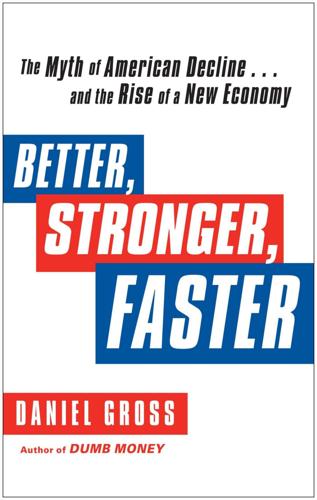
Better, Stronger, Faster: The Myth of American Decline . . . And the Rise of a New Economy
by
Daniel Gross
Published 7 May 2012
.: BMW in, 87, 97 GE in, 109–10, 174, 228 gross domestic product (GDP), 9, 17, 29, 31, 75, 198, 227 of BRIC nations, 19–20 and costs of bailouts, 38, 43 exports and, 98–99 in history, 13–14 Groupon, 203 Grupo Phoenix, 88–92 Gyourko, Joseph, 212 Hagerty, James, 108 Hamilton, Alexander, 218 Hanjour, Hani Hasan, 120 Hassett, Kevin, 18 Hawaii, 117–18, 123–25, 211 Hawaii Volcanoes National Park, 207 health care, 70, 91, 145–46, 172, 216–17, 225 exports and, 116, 125–26 inports and, 136, 145 North Dakota and, 157, 160, 162 Obama on, 5–6, 222 Healy, Tim, 72–74 hedge funds, 16, 19, 82, 85, 94, 156 timely policy decisions and, 36, 38 Helliker, Kevin, 161–62 higher education, 142, 175, 204, 215, 226 efficient consumers and, 192–95 export of, 115–21, 126, 131, 161–62, 164 inports and, 145–46 North Dakota and, 153, 160–62 tuition charges in, 118–20, 126, 146, 161 High Line, 121, 213, 225 Hildestad, Terry, 153 Hill Holliday, 50 Hoffman, Reid, 203–4 Holmes, Elizabeth, 125 HomeAway, 203 home equity lines of credit, 51, 54–56 Hong Kong, 7, 22, 92, 120, 138 Hoover Dam, 206 Hot Properties, 171 houses, housing, 12, 56, 74, 116, 180, 225 booms in, 9, 21, 54, 156, 171, 194 bubbles in, 15, 51, 54–55, 190, 219 in China, 7, 20 crises in, 4, 81, 190–91, 212, 219–20 efficiency economy and, 61, 224 efficient consumers and, 185–91, 194–96 exports and, 111–13 FDI and, 83–85 forecasts and, 16–18 infrastructure and, 211–13 in North Dakota, 150–52, 155–56, 158 prices of, 3, 9, 16–17, 24, 29, 54, 84, 150, 155–56, 211–12, 219 renting rooms in, 194–95 restructuring and, 53–55 strengthening recovery and, 215–17, 220–21 timely policy decisions and, 29, 32, 34–35, 42–43, 54–55 see also mortgages Howard, Tim, 126 “How the Great Recession Was Brought to an End” (Zandi and Blinder), 31 Huawei, 96 Hudson River, 206, 211, 225–26 hydraulic fracturing, 79, 86, 105, 151 Hy-Lite, 169 Hyman, Jennifer, 194 Hyundais, 77–78 IBM, 82, 133, 143, 199 Immelt, Jeff, 146 exports and, 109–10 and reshoring and insourcing, 172–73 immigrants, immigration, 21, 89, 91, 165, 182, 215 Erie Canal and, 205–6 exports and, 117, 121, 123 and reshoring and insourcing, 176–77 InBev, 95 incomes, 9, 16, 37, 72, 98, 111, 156, 168, 222 in China, 20, 164–67 efficient consumers and, 180–84 exports and, 101, 116, 118, 126, 164 FDI and, 83, 91 infrastructure and, 205–7, 209–10 inports and, 139–40 North Dakota and, 152, 160 and reshoring and insourcing, 169–70, 172, 178 restructuring and, 54, 56–57 supersizing and, 200–201 India, 19, 26, 100–101, 112, 125, 161, 164, 171–72 exports and, 106, 108–9, 117–18, 120–22, 127, 169 FDI and, 86–87, 94 inports and, 131–32, 138, 227 Indian Point nuclear power plant, 74 IndiGo, 108 Industrial and Commercial Bank of China (ICBC), 92–93 inflation, 9, 15, 20, 24, 165, 170 infrastructure, 13, 101, 137, 169, 207, 217, 224–25, 228 efficiency economy and, 79, 224 exports and, 103–4, 106, 113, 123, 208 North Dakota and, 150, 152–53, 157, 162 supersizing and, 202–14 initial public offerings (IPOs), 7, 35, 42, 68, 133, 201, 204 inports, 131–47 in auto industry, 133–37, 227 China and, 134–36, 138–43, 146, 164, 227 Disney and, 132, 137–38, 144 employment and, 132, 134–36, 140, 142, 146–47 health care and, 136, 145 higher education and, 145–46 Mary Kay and, 132, 141–43 Starbucks and, 139–41 supersizing and, 202–3 insourcing, see reshoring and insourcing Institute of International Education, 118–19 interest, interest rates, 10, 85, 217, 221 of Japan, 29–30 restructuring and, 48, 57, 136 timely policy decisions and, 34, 37–38, 42 International Trade Administration, 226 Internet, 10, 18, 26, 46, 84, 168, 180, 225 efficient consumers and, 183, 193–95 stocks and, 15, 21–22, 82 supersizing and, 200–201, 203, 208–10, 214 interstate highway system, 207 inventories, 9, 18, 155, 167, 170, 177, 194, 220 inports and, 135, 142 investors, investing, 1, 13, 16, 24, 32, 107, 133, 163, 199, 217, 219, 222, 226 automaker bailouts and, 41–42 economic declines and, 4, 17 efficiency economy and, 62, 65, 71–73, 76, 78–79, 224 efficient consumers and, 181, 184–85, 195–96 infrastructure and, 205, 207–8, 210–13 inports and, 131, 136–38 North Dakota and, 150–51, 157, 160–62 and reshoring and insourcing, 170, 173–74, 179 restructuring and, 44–45, 49–51, 78 strengthening recovery and, 215, 220 supersizing and, 200, 213 timely policy decisions and, 30, 36–38, 41–42 see also foreign direct investment iPads, 140, 193, 200 iPhones, 64, 140, 189, 198, 200, 204, 227 Iran, 227 Iraq, 110 Ireland, 38 Isaacson, Walter, 128, 200–201 Israel, 84, 123, 197, 211, 231 Italy, 14, 19, 29, 46–47, 71, 87, 106, 123, 133, 203 ITU, 209 iTunes, 184, 200, 210 Japan, 47, 140, 165, 168 automakers and, 14, 26, 41, 79, 87, 134–35, 173 comparisons between U.S. and, 8–9, 19, 21, 29, 202 demographics of, 8–9, 21, 29, 162 efficiency economy and, 60–61, 67 exports and, 101, 106, 109, 124–25, 128 FDI of, 82, 92–93, 95–96 in history, 13–14, 20, 61 inports and, 138, 144 timely decisions and, 29–30, 37 tsunami in, 21, 41, 124, 167 Jarden, 169–71 JBS, 95 Jobs, Steve, 128, 199–202 John F.
…
Index Abdullah, King of Saudi Arabia, 125 advertising, 7, 50, 136, 143, 201, 202 exports and, 129–30 Aegis Communications, 172 agriculture, 20, 99–101, 206, 227 exports and, 100–101, 104, 122, 154, 160 in North Dakota, 149, 153–58, 162 AIA, 35 AIG, 32–33, 35–36, 133 Airbnb, 194–95 Ally Financial, 40, 42 Altman, Daniel, 141 Amazon.com, 22, 203 American Association of Publishers, 193 American Bankers Association, 12–13 American Petroleum Institute, 104 American Recovery and Reinvestment Act, 30 American Society of Civil Engineers (ASCE), 208 Anheuser-Busch, 95, 158 AOL, 183–84, 195 A123 Systems, 211 Apple, 140–41, 143, 195, 198–201 Areddy, James T., 101 Argentina, 85, 176, 203 arms, exports of, 108–9 Armstrong, Tim, 183 Arvizu, Dan, 210 Asia, 13, 35, 87, 144, 203, 226, 228 employment and, 164, 168 exports and, 103, 105, 120, 123 inports and, 131, 138, 140, 146 North Dakota and, 155, 161 and reshoring and insourcing, 169–70, 173, 176–78 Associated Press, 174, 190, 206 Association of International Educators (NAFSA), 119–20 athletes, 126–27 ATM machines, 124, 174–76 Auletta, Ken, 183 Australia, 14, 48, 74, 103, 203 exports and, 98, 106, 122 autos, automakers, 2, 7, 14–15, 21, 34, 104, 186 bailout of, 33, 40–43, 46, 133, 136 efficiency economy and, 60–61, 69, 75, 77–79, 102, 173, 222–24, 227 efficient consumers and, 182, 190–93, 195–96 electric, 41, 79, 97, 210–11, 222 FDI and, 82, 87, 97 hybrid, 78–80, 211 inports and, 133–37, 227 Japan and, 14, 26, 41, 79, 87, 134–35, 173 and reshoring and insourcing, 167–68, 173–74 restructuring and, 46, 51–52, 78, 136, 173–74 supersizing and, 210–11 Bach Composite, 86 bailouts, 6, 20, 23, 46, 51–52, 133, 136–37 of Fannie Mae and Freddie Mac, 32, 35, 42–43 TARP and, 36–38, 40–42 timely policy decisions and, 28, 31–43 Bailyn, Bernard, 18 Bain Capital, 50–51 Baker, Akbar Al, 108 Bakken Shale, 151 Banco do Brasil, 95 Bank of America, 37–38, 48 Bank of East Asia, 92 Bank of Hawaii, 124 bankruptcies, 1, 82, 111, 166, 218 of CIT Group, 47–48 efficiency economy and, 78, 80 restructuring and, 44–48, 51, 53, 55, 58, 78, 136 timely policy decisions and, 40–41 banks, bankers, banking, 1–4, 16, 21, 25–26, 65, 81, 208, 217, 219 bailouts and, 6, 20, 32–34, 38–40, 42–43 of China, 20, 82, 92–94 economic decline and, 12, 17 efficient consumers and, 184, 190 exports and, 112, 124, 129 failure of, 1, 39–40, 46, 92 FDI and, 83, 85, 92–95 in history, 13–14, 36 of Japan, 29–30, 37, 47 North Dakota and, 156–58 regulation of, 19, 25 restructuring and, 45–47, 51, 53–55, 58 strengthening recovery and, 216, 220 TARP and, 36–38 timely policy decisions and, 32–34, 36–40, 43 Barboza, David, 141 Batali, Mario, 123 Bear Stearns, 32–33, 53 Beck, Jill, 155–56, 162 beer, beer business, 144, 194, 206 FDI and, 95–96 North Dakota and, 158–59 and reshoring and insourcing, 177–78 Bennett, Jeff, 87 Berger, John, 153 Bernanke, Ben, 32–33 Bernstein, Peter, 206 Berry Petroleum, 80 Better Place, A, 211 BigBelly Solar, 75, 107, 195, 204 efficiency economy and, 64–68, 72 Big Roads, The (Swift), 207 Bison Gear & Engineering, 67 Blinder, Alan, 31, 164 Blonder Home Accents, 111 Bloomberg, 33, 109 BMW, 79, 87, 97 Boehner, John, 5, 222 Boeing, 51, 108, 227 Book of Masters, 137 Bopp, Aric, 88–89 Boskin, Michael, 5 Boston, Mass., 72, 144, 192, 212, 224 BigBelly Solar and, 66–67 restructuring and, 49–51 Boston Community Capital, 225 Boston Consulting Group (BCG), 117, 166–68, 179 Boston Properties, 51 bottled water, 184–85 Bowen, Wally, 209–10 Bowles-Simpson Commission, 221–22 BP Amoco, 153 brands, 46, 159, 183, 206, 215 exports and, 111, 117, 119 FDI and, 87, 93, 96 inports and, 132, 135, 138–41, 143–44, 227 supersizing and, 199, 202 Braskem, 95 Brattle Group, 210 Brazil, 19, 100–101, 175 exports and, 101, 103–4, 109, 122 FDI and, 82, 85, 94–95 inports and, 131, 144–46 BRIC nations, 19–20, 23, 151 Broadway Partners, 49–50 Buffalo Commons theory, 150 Buicks, Buick, 78, 134–36, 227 Bull, 171 Bureau of Labor Statistics, 166, 187, 191 Burger King, 95 Burr, Aaron, 218 Bush, George W., 5, 16, 26, 30, 33, 222 business cycles, 17–18, 82, 231 Business Roundtable, 146–47 Cai Yong, 134 California, 79–80, 149, 161, 211–12 FDI and, 84, 92, 96–97 tourism in, 122–23 Campagna, Michael A., 178 Canada, 4, 48, 74, 202 exports and, 100, 122 FDI and, 92, 95 capitalism, 3, 14, 25, 45 Capital One, 58 Capital Purchase Program (CPP), 36–38 carbon, 170, 186 efficiency economy and, 61, 65, 75 taxes on, 61, 75, 103–4, 217 Card Hub, 55, 58 Cargill Malt, 158–59 Caro, Robert, 206 casinos, 85, 152 Cavendish Farms, 159–60 Census Bureau, 53 Center for Budget and Policy Priorities, 222 Center Rock Inc., 108 Central Park, 85, 94, 212 Chandan, Sam, 94 Chandler, Alfred, 206 Chegg.com, 193, 195, 204 Cheniere Energy Partners, 106 Chesapeake Bay Candle, 177 Chevrolets, Chevrolet, 41, 77, 135–36, 199 Chicago, Ill., 8, 67, 90, 193, 212 China, 6–9, 14, 18–21, 25–26, 82, 164–78, 187, 217 comparisons between U.S. and, 7–8, 25, 166–67, 202, 208 economy of, 2, 7–8, 18–20, 25, 141, 148, 165, 178, 222 efficiency economy and, 62, 67–69, 71, 227 employment and, 164–68, 170 FDI and, 85–87, 92–94, 97, 164 incomes in, 20, 164–67 inports and, 134–36, 138–44, 146, 164, 227 and reshoring and insourcing, 169–78, 222 trade and, 94, 98, 100–104, 106–9, 112–14, 116, 118–20, 122–28, 164 China Eastern, 124 China UnionPay, 124 Christie, Chris, 211 Chrysler: bailout of, 40–42 bankruptcy of, 40–41, 46, 51, 136 Fiat’s acquisition of, 40, 78, 87 and reshoring and insourcing, 173–74 Chung, Winston, 97 CIT Group, 47–49 Citi, Citibank, Citigroup, 37, 53, 84–85, 172 Citic Press, 128 Civilian Conservation Corps (CCC), 206–7 Civil War, 18, 82 Civil Works Administration, 206 Cleveland Clinic, 126, 145 Clinton, Bill, 26, 31, 70, 217–18, 228 Clooney, George, 129, 227 CNBC, 4, 108 CNG Now, 105 CNOOC, 86 coal, 102–5, 162, 165, 202 Coca-Cola, 83–84, 143, 202, 227 inports and, 133, 137–38, 146 coffee, 139–40, 181 Coleman, 171 collateralized debt obligations, 36 Collinses, 111–14, 116 Colombia, 26, 131, 148 FDI and, 85, 88–91 Commerce Department, U.S., 1, 54, 99–100, 104, 120, 122, 125, 219 Commercial Paper Funding Facility, 34 Committee on Foreign Investment in the United States, 96 competition, 3, 19, 21, 23, 80, 83, 106–7, 167, 194, 204, 228 efficiency economy and, 62, 68, 77 efficient consumers and, 193, 196 inports and, 131–32, 137, 141 North Dakota and, 148, 161 and reshoring and insourcing, 169, 179 Congress, U.S., 14, 19, 23–24, 125, 146 deficits and, 221–22 economic decline and, 3, 10 health care reform and, 5–6 U.S. credit rating and, 1–2 Congressional Budget Office, 31 Connecticut, 50, 86, 105, 140, 146, 151, 161–62, 212 efficient consumers and, 187–88 Conservation and Recreation Department, Mass., 66 construction, 174 efficient consumers and, 190–91 housing crisis and, 219–20 infrastructure and, 205–6, 209, 211, 213 North Dakota and, 152–53, 155–56 Consumer Price Index, 187 consumers, consumerism, consumption, 2, 25, 28, 81, 101, 111, 216, 219 coal and, 102–3 economic pessimism and, 22–23 efficiency economy and, 64–65, 68, 73–75, 78, 223–24 exports and, 98–99, 104–5, 107, 110, 119, 128, 130–31, 147, 154, 164 FDI and, 83, 89–90, 92–93 indebtedness and, 9–10, 53–57 inports and, 131–32, 136–37, 141, 143, 147, 227 North Dakota and, 151, 153–54 and reshoring and insourcing, 169, 172, 175, 177 restructuring and, 44–45, 53–59 supersizing and, 202, 204, 209 see also efficient consumers Cooper, Bill, 105 Cooper, Stephen, 44 CoreLogic, 190 corporations, 1, 9–10, 60, 139–43, 163–67, 169–85, 192–206, 225 comparisons between consumers and, 181, 185, 189, 195 and costs of labor, 164–67 economic optimism and, 23–24 economic pessimism and, 22–23 efficiency economy and, 63–68, 71, 75–76, 80–81, 158, 172, 223 efficient consumers and, 181–85, 192–96 exports and, 98, 103, 108–10, 112–14, 116–17, 131, 177 FDI and, 82–96 global, 22, 24, 71, 95 inports and, 132, 135–37, 139–42, 144, 146–47, 202–3, 227 job growth and, 218–19 North Dakota and, 152–53, 155, 157–60 recoveries and, 17–18, 21, 215 and reshoring and insourcing, 167, 169–79 restructuring and, 44–45, 47–49, 52–53, 57–58, 81, 166 supersizing and, 199–206, 209–10 taxes on, 146–47, 163 timely policy decisions and, 28, 30, 34 U.S. economic importance and, 227–28 Costner, Kevin, 129–30 Coty, 71 Coulomb Technologies, 211 Council of Economic Advisers, 31 Cowan, Lynn, 203 Creation Technologies, 67 credit, 32–36, 94, 194 booms in, 21, 29, 56, 62 crisis in, 2, 4, 23, 26, 48, 53 exports and, 112–13 restructuring and, 49, 51, 53–56, 58 timely policy decisions and, 29, 32–33, 35–36, 42–43 credit cards, 34, 183–85 restructuring and, 54–56 credit ratings, 1–2, 11, 52 Credit Suisse, 137, 223 Davis, Fred, 90–91 debt, 1, 19–20, 23–24, 60, 185 CIT Group and, 48–49 consumers and, 9–10, 53–57 crises and, 6, 29, 216 efficiency economy and, 62–63, 72, 78 efficient consumers and, 181, 189, 193, 196 Erie Canal and, 205–6 FDI and, 82, 94 national, 2, 5, 11, 217 North Dakota and, 155–56 restructuring and, 45–59, 78 strengthening recovery and, 215–16 timely policy decisions and, 32–34, 36, 39, 42 see also loans, lending, lenders debt ceiling extensions, 2, 217 Dedrick, Jason, 140 Defense Department, U.S., 109 deficits: budget, 2, 6, 10, 64–65, 217, 221–22 efficiency economy and, 64–65 trade, 102, 107, 168, 221–22 Delphi, 46 demand, 18, 31, 45, 57, 101, 132, 178, 221 efficiency economy and, 60, 62, 72–74, 223 exports and, 99, 104, 107–10, 116, 119 North Dakota and, 153–54, 159 supersizing and, 206, 208 Deming, W.
…
Edwards, 61 Democrats, 3, 5, 10, 14, 26, 205, 218 demographics: of China, 20, 25, 165 of Japan, 8–9, 21, 29, 162 of North Dakota, 149, 159–62 of U.S., 9, 21, 166, 205, 215 Dempsey, Clint, 126 DeVol, Ross, 17 Dimon, Jamie, 58 Disney, 132, 137–38, 144, 154, 165, 202 dollar, 2, 21, 104, 134, 165 Dorsman, Peter, 175–76 Dow Jones Industrial Average, 5, 18, 24 Dow 36,000 (Glassman and Hassett), 18 Dubai, 86, 112, 145 Dubai Ports World, 96 Dublin, Va., 88–90 Dumb Money (Gross), 204 Eatalay, 123 eBay, 203–4, 210 Ecclestone, Petra, 84 Eclipse (Subramanian), 8 e-commerce, 56, 208–9 economics, economy: booms in, 2, 8, 14, 152 declines in, 1–19, 21–24, 27–28, 30, 44–45, 52, 59, 61–63, 80–81, 83, 98–99, 116, 121, 143, 147–50, 192, 195, 198, 205, 209, 215–16, 218, 227 excess and waste in, 60–61 expansions in, 15, 28–29, 53, 62–63, 199, 207, 217, 227 in future, 10, 15–18, 24, 28, 97 importance of U.S. in, 2, 227–28 malaise in, 8–9, 14, 83 myths about, 14, 16, 23–24, 28, 97 optimism and confidence in, 2, 14–16, 23–25, 27, 148, 198, 217 pessimism about, 12, 21–24, 99, 200 policy proposals for, 217–18, 226–27 statistics on, 1, 4, 7, 9, 17, 215, 217, 227 strengthening of, 215–17, 220–21 taking action on, 225–26 Economic Stimulus Act, 30 Eden, Doug, 158–59 education, 11, 14, 26, 132, 217, 225 in North Dakota, 153, 157–58, 160–62 see also higher education efficiency economy, 60–81, 167 autos and, 60–61, 69, 75, 77–79, 102, 173, 222–24, 227 BigBelly Solar and, 64–68, 72 energy and, 61–62, 64–80, 102, 107, 158, 222–24 EnerNOC and, 72–75, 77 exports and, 102, 107 internal resources for, 60–64, 79–80, 107 North Dakota and, 158–59 and reshoring and insourcing, 170–73, 178 in retrofitting commercial buildings, 68–72, 80 strengthening recovery and, 215–16 UPS and, 76–77 Walmart and, 62, 68, 75–76 efficient consumers, 180–96 autos and, 182, 190–93, 195–96 cost and spending reductions of, 181–86, 188–89, 191–96 energy and, 182, 185–90, 195–96 housing and, 185–91, 194–96 pools of, 185–87 Egypt, 167, 227 Elkind, Peter, 22 emerging markets, 94, 104 FDI and, 86–87 inports and, 140, 144 Empire State Building, 69–72, 77, 204 employees, employment, 1–3, 24, 163–81 automaker bailouts and, 40–41 costs of, 164–68, 170 efficiency economy and, 61–68, 75, 78–79, 158 efficient consumers and, 180–81, 190 exports and, 99–100, 106–8, 110, 112–13, 117–20, 122, 164, 226 FDI and, 82–83, 85–92, 95, 97, 163–64 infrastructure and, 205–7, 209, 213 inports and, 132, 134–36, 140, 142, 146–47 job creation and, 1, 9–10, 16, 19, 31, 41, 45, 56–57, 89, 99–100, 106–7, 110, 174, 179, 199–201, 205–6, 209, 211, 213, 218–19 layoffs and, 9, 16, 45, 56–57, 62–63, 79, 82, 85, 88, 111, 113, 150, 163, 203 at Newsweek, 15–16 North Dakota and, 149–53, 157–60, 212 and reshoring and insourcing, 163, 167–79 restructuring and, 45, 53–57, 59, 78, 136 statistics on, 3, 13, 29–31, 45, 57, 63, 86, 95, 99–100, 117, 119, 149, 152, 166, 209 strengthening recovery and, 215–17 supersizing and, 199–201, 203–7, 209–11 timely policy decisions and, 30–31, 40–41 training of, 90–91, 165–66 unemployment and, 2–3, 12–13, 29–31, 40, 45, 55, 75, 78, 119, 132, 149, 159, 163, 206, 211–12, 215–16, 218 see also incomes Endeavor Foundation, 228 energy, 7, 26, 165, 167, 178, 216–17, 225 cost of, 2, 15, 75, 77, 153, 172, 188 efficiency economy and, 61–62, 64–80, 102, 107, 158, 222–24 efficient consumers and, 182, 185–90, 195–96 exports and, 101–6, 109, 160 FDI and, 86, 90, 95 North Dakota and, 148, 151–54, 157, 160, 162 Super Cool Biz campaign and, 9, 61 supersizing and, 202, 206, 210–11 see also gasoline; oil; solar energy Energy Department, U.S., 70, 102, 106 Energy Information Administration, 186 EnerNOC, 195 demand-response model of, 73–74 efficiency economy and, 72–75, 77 ENN Energy Trading, 106 entertainment and entertainers: exports of, 128–30 inports and, 137–38 entrepreneurs, 69, 84, 142, 195, 199, 228 Environmental Protection Agency (EPA), 102, 104 Erie Canal, 205–6 Essar, 172 ethanol, 104–5 Europeans, Europe, 2–3, 7–8, 13, 19, 24, 29, 101, 116, 132, 140, 144, 148, 177, 203, 206, 217 efficiency economy and, 60, 68 FDI and, 81–82, 95 timely policy decisions and, 32, 38–39 trade and, 14, 120, 123, 129 exports, 98–134, 137, 143–44, 147, 169, 176–77, 199, 208, 216, 228 of agricultural products, 100–101, 104, 122, 154, 160 of arms, 108–9 of athletes, 126–27 energy and, 101–6, 109, 160 of entertainment and entertainers, 128–30 of expensive, value-added, life-enhancing equipment, 107–8 of GE, 109–10, 112, 119 of higher education, 115–21, 126, 131, 161–62, 164 inports and, 132–34 of literary works, 127–28 misperceptions about, 98–99 North Dakota and, 150, 154–55, 158–62 statistics on, 98–101, 103–9, 112, 114–16, 118–25, 128–29, 226 tourism and, 116, 121–26, 164 of Wallquest, 111–14, 119 Exxon, 218 Facebook, 84, 197–99, 227 supersizing and, 199, 201–2, 204 Fannie Mae, 32, 35, 42–43, 156 Federal Deposit Insurance Corporation (FDIC), 13, 32–34, 39–40, 46, 92 Federal Reserve (Fed), 5–6, 10, 17, 81, 95, 217 AIG bailout and, 32, 35–36 CIT Group and, 47–48 restructuring and, 48, 53, 57 timely policy decisions and, 32–36, 40 Ferguson, Niall, 4–5 fertility rates, 21 Fiat, 40, 78, 87 Fichter, Paul, 178 financial crises, 4, 6, 12–15, 43–47, 65, 81, 94, 109, 134, 198 recoveries after, 18, 216 reforms and, 12–14, 18 restructuring and, 44–45, 51–52, 56, 59 timely policy decisions and, 28, 32–34, 37, 39–40, 43, 59 Financial Times (FT), 23, 29, 104–5, 108, 185, 223, 227 Findlay Industries, 88 fiscal policy, 25, 30, 32, 221 Fisker Automotive, 79, 210 Five Mile Capital, 50 Fleiss, Jennifer, 194 Florida, 145, 149, 169 FDI and, 82, 85, 92, 95 Florida, Richard, 28, 201–2 Ford, Henry, 51, 61 Fords, Ford, 26, 77–78, 199, 211 inports and, 134, 136–37 and reshoring and insourcing, 173–74 restructuring of, 51–52, 78, 136 foreign direct investment (FDI), 22, 24, 81–97, 116, 147, 216 Brazil and, 82, 85, 94–95 China and, 85–87, 92–94, 97, 164 employment and, 82–83, 85–92, 95, 97, 163–64 of Grupo Phoenix, 88–92 in history, 13, 81–82, 97 in human resources, 86–87 real estate and, 83–85, 92–94, 96 of Uniqlo, 92–93 Fortune, 22, 77, 200–201 France, 3, 19, 29, 39, 84, 111 efficiency economy and, 68, 71 exports and, 106, 123 FDI and, 81–82 supersizing and, 202–3 Frank, Barney, 3 Franklin, Martin, 171 Freddie Mac, 32, 35, 42–43 Friedman, Thomas, 6, 217 Fujiwara, Kyoaki, 8–9 garbage, 107, 195 efficiency economy and, 64–68, 70–71, 80 Garza, Barbara, 84 gasoline, 104, 153, 186, 208, 216 efficiency economy and, 61, 76–79, 224 efficient consumers and, 182, 191–92 price of, 2, 77 gas turbines, 26, 109–10, 174, 228 Geithner, Timothy, 21, 32–33, 37 General Electric (GE), 121, 146, 172–74, 188, 227–28 exports of, 109–10, 112, 119 and reshoring and insourcing, 172–73 General Growth Properties, 46 General Motors (GM), 166 bailout of, 40–42, 133, 136 bankruptcy of, 40–41, 46, 51, 78, 136, 218 efficiency economy and, 78–79 inports and, 135–36, 227 and reshoring and insourcing, 173–74 George Washington Bridge, 206 Germany, 13, 19, 29, 39, 45, 61, 135, 144 automakers of, 79, 87, 97, 173 exports and, 98, 109, 112–13, 116, 123, 127 FDI and, 82, 87, 91, 97 Gettysburg, Battle of, 18 Gibbons, David, 135–36 Glader, Paul, 172 Glassman, James, 18 GlassPoint Solar, 79–80 Global Automakers, 173 Global Beef Consultants, 155 globalism, globalization, 2–3, 10, 19, 21–25, 42, 80, 117, 197, 199, 216 economics and, 22–25, 29, 48, 83, 95, 149–50, 202, 227–28 efficiency economy and, 62, 71, 75 FDI and, 83, 95 North Dakota and, 149–51, 153–54, 159, 162 and reshoring and insourcing, 173, 175, 179 restructuring and, 48, 52–53, 57 supersizing and, 201–3 see also trade global warming, 3, 11, 64–65, 103, 217 GM Shanghai, 135–36 Godhwani, Sunil, 86–87, 172 Goehring, Doug, 154–55 gold, 2, 22 Gold, Russell, 106–7 Goldman Sachs, 23, 32, 37, 48, 53, 198 Goodman, Allan, 118 Google, 63, 137, 143, 184, 197–99 supersizing and, 199, 201, 204, 207–8, 211 government spending, 4, 10, 42, 57, 90, 157 deficits and, 221–22 timely policy decisions and, 30–31, 39 Graham, Lindsey, 3 Great Depression, 2, 17, 44, 54, 57, 69, 206–7, 217 “Great Plains, The” (Popper and Popper), 149–50 Great Recession, 1–4, 21–22, 24, 44, 147, 216 economic decline and, 1–2, 15, 17 efficiency economy and, 74–75 efficient consumers and, 189, 192, 194 employment and, 163, 165–66, 199 end of, 1, 28, 62 exports and, 99, 118 FDI and, 82, 91, 94 predictions on, 4, 15–17 restructuring and, 54, 56 start of, 28–29, 74 supersizing and, 199, 203, 205 timely policy decisions and, 30, 32–33 Greece, 19, 21, 112, 117, 227 Green, Stephen, 141 greenfielding, 87–88 greenhouse gases, 68 Green Mountain Coffee, 89–90 Greenville, S.C.: BMW in, 87, 97 GE in, 109–10, 174, 228 gross domestic product (GDP), 9, 17, 29, 31, 75, 198, 227 of BRIC nations, 19–20 and costs of bailouts, 38, 43 exports and, 98–99 in history, 13–14 Groupon, 203 Grupo Phoenix, 88–92 Gyourko, Joseph, 212 Hagerty, James, 108 Hamilton, Alexander, 218 Hanjour, Hani Hasan, 120 Hassett, Kevin, 18 Hawaii, 117–18, 123–25, 211 Hawaii Volcanoes National Park, 207 health care, 70, 91, 145–46, 172, 216–17, 225 exports and, 116, 125–26 inports and, 136, 145 North Dakota and, 157, 160, 162 Obama on, 5–6, 222 Healy, Tim, 72–74 hedge funds, 16, 19, 82, 85, 94, 156 timely policy decisions and, 36, 38 Helliker, Kevin, 161–62 higher education, 142, 175, 204, 215, 226 efficient consumers and, 192–95 export of, 115–21, 126, 131, 161–62, 164 inports and, 145–46 North Dakota and, 153, 160–62 tuition charges in, 118–20, 126, 146, 161 High Line, 121, 213, 225 Hildestad, Terry, 153 Hill Holliday, 50 Hoffman, Reid, 203–4 Holmes, Elizabeth, 125 HomeAway, 203 home equity lines of credit, 51, 54–56 Hong Kong, 7, 22, 92, 120, 138 Hoover Dam, 206 Hot Properties, 171 houses, housing, 12, 56, 74, 116, 180, 225 booms in, 9, 21, 54, 156, 171, 194 bubbles in, 15, 51, 54–55, 190, 219 in China, 7, 20 crises in, 4, 81, 190–91, 212, 219–20 efficiency economy and, 61, 224 efficient consumers and, 185–91, 194–96 exports and, 111–13 FDI and, 83–85 forecasts and, 16–18 infrastructure and, 211–13 in North Dakota, 150–52, 155–56, 158 prices of, 3, 9, 16–17, 24, 29, 54, 84, 150, 155–56, 211–12, 219 renting rooms in, 194–95 restructuring and, 53–55 strengthening recovery and, 215–17, 220–21 timely policy decisions and, 29, 32, 34–35, 42–43, 54–55 see also mortgages Howard, Tim, 126 “How the Great Recession Was Brought to an End” (Zandi and Blinder), 31 Huawei, 96 Hudson River, 206, 211, 225–26 hydraulic fracturing, 79, 86, 105, 151 Hy-Lite, 169 Hyman, Jennifer, 194 Hyundais, 77–78 IBM, 82, 133, 143, 199 Immelt, Jeff, 146 exports and, 109–10 and reshoring and insourcing, 172–73 immigrants, immigration, 21, 89, 91, 165, 182, 215 Erie Canal and, 205–6 exports and, 117, 121, 123 and reshoring and insourcing, 176–77 InBev, 95 incomes, 9, 16, 37, 72, 98, 111, 156, 168, 222 in China, 20, 164–67 efficient consumers and, 180–84 exports and, 101, 116, 118, 126, 164 FDI and, 83, 91 infrastructure and, 205–7, 209–10 inports and, 139–40 North Dakota and, 152, 160 and reshoring and insourcing, 169–70, 172, 178 restructuring and, 54, 56–57 supersizing and, 200–201 India, 19, 26, 100–101, 112, 125, 161, 164, 171–72 exports and, 106, 108–9, 117–18, 120–22, 127, 169 FDI and, 86–87, 94 inports and, 131–32, 138, 227 Indian Point nuclear power plant, 74 IndiGo, 108 Industrial and Commercial Bank of China (ICBC), 92–93 inflation, 9, 15, 20, 24, 165, 170 infrastructure, 13, 101, 137, 169, 207, 217, 224–25, 228 efficiency economy and, 79, 224 exports and, 103–4, 106, 113, 123, 208 North Dakota and, 150, 152–53, 157, 162 supersizing and, 202–14 initial public offerings (IPOs), 7, 35, 42, 68, 133, 201, 204 inports, 131–47 in auto industry, 133–37, 227 China and, 134–36, 138–43, 146, 164, 227 Disney and, 132, 137–38, 144 employment and, 132, 134–36, 140, 142, 146–47 health care and, 136, 145 higher education and, 145–46 Mary Kay and, 132, 141–43 Starbucks and, 139–41 supersizing and, 202–3 insourcing, see reshoring and insourcing Institute of International Education, 118–19 interest, interest rates, 10, 85, 217, 221 of Japan, 29–30 restructuring and, 48, 57, 136 timely policy decisions and, 34, 37–38, 42 International Trade Administration, 226 Internet, 10, 18, 26, 46, 84, 168, 180, 225 efficient consumers and, 183, 193–95 stocks and, 15, 21–22, 82 supersizing and, 200–201, 203, 208–10, 214 interstate highway system, 207 inventories, 9, 18, 155, 167, 170, 177, 194, 220 inports and, 135, 142 investors, investing, 1, 13, 16, 24, 32, 107, 133, 163, 199, 217, 219, 222, 226 automaker bailouts and, 41–42 economic declines and, 4, 17 efficiency economy and, 62, 65, 71–73, 76, 78–79, 224 efficient consumers and, 181, 184–85, 195–96 infrastructure and, 205, 207–8, 210–13 inports and, 131, 136–38 North Dakota and, 150–51, 157, 160–62 and reshoring and insourcing, 170, 173–74, 179 restructuring and, 44–45, 49–51, 78 strengthening recovery and, 215, 220 supersizing and, 200, 213 timely policy decisions and, 30, 36–38, 41–42 see also foreign direct investment iPads, 140, 193, 200 iPhones, 64, 140, 189, 198, 200, 204, 227 Iran, 227 Iraq, 110 Ireland, 38 Isaacson, Walter, 128, 200–201 Israel, 84, 123, 197, 211, 231 Italy, 14, 19, 29, 46–47, 71, 87, 106, 123, 133, 203 ITU, 209 iTunes, 184, 200, 210 Japan, 47, 140, 165, 168 automakers and, 14, 26, 41, 79, 87, 134–35, 173 comparisons between U.S. and, 8–9, 19, 21, 29, 202 demographics of, 8–9, 21, 29, 162 efficiency economy and, 60–61, 67 exports and, 101, 106, 109, 124–25, 128 FDI of, 82, 92–93, 95–96 in history, 13–14, 20, 61 inports and, 138, 144 timely decisions and, 29–30, 37 tsunami in, 21, 41, 124, 167 Jarden, 169–71 JBS, 95 Jobs, Steve, 128, 199–202 John F.
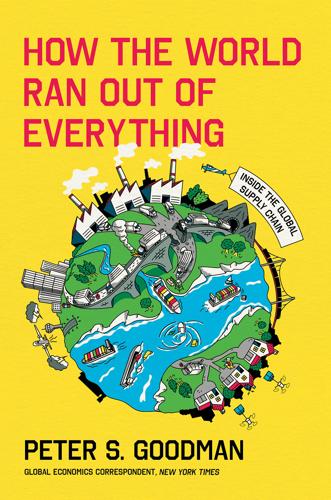
How the World Ran Out of Everything
by
Peter S. Goodman
Published 11 Jun 2024
Ford was breaking ground: Olivia Evans, “Ford, SK On Bringing 5,000 Jobs to Kentucky with Massive Electric Vehicle Battery Park,” Louisville Courier-Journal, December 5, 2022. 34. imported from China: Harry Moser’s testimony before the US-China Economic Security Review Commission, June 9, 2022. 35. jobs in the pipeline: “Reshoring Initiative 2022 Data Report,” Reshoring Initiative, https://reshorenow.org/blog/reshoring-initiative-2022-data-report/. Chapter 20: “Okay, Mexico, Save Me.” 1. exceeding half a trillion: Walmart 2022 Annual Report. 2. group exceeding 40 million: Sandy Dietrich and Erik Hernandez, “Nearly 68 Million People Spoke a Language Other Than English at Home in 2019,” United States Census Bureau, December 6, 2002, https://www.census.gov/library/stories/2022/12/languages-we-speak-in-united-states.html. 3. he derided as “rapists”: Alexander Burns, “Choice Words from Donald Trump, Presidential Candidate,” New York Times, June 16, 2015. 4.
…
Indeed, by late 2023, Taiwan Semiconductor was delaying plans for production at its new Arizona factory while complaining that it could not hire enough skilled workers. And reshoring was largely driven by federal subsidies, not by the market. It was the result of a concerted campaign by the Trump and Biden administrations to alter the map governing international trade, as opposed to the product of dispassionate economic calculations. “The national security concerns, and the geopolitics with Taiwan, those factors are motivators,” said Eskander Yavar, a managing partner at BDO, an international business consulting firm. “If there’s no subsidies in place, I think reshoring becomes a slower roll.” Yet this was the very point of the subsidies, Yavar added.
…
But outside of obvious beneficiaries like chipmakers, few industries saw the appeal of setting up in the United States. In a suddenly hyped conversation around the revival of American industry, talk of reshoring was widespread, yet actual instances were few. Bringing factory work home to American shores was challenged by the same consideration that had sent it away in the first place: lower prices could be found elsewhere. An advocacy group called the Reshoring Initiative launched by Harry Moser, a retired manufacturing executive, had long labored in obscurity. When I caught up with him in February 2023, Moser was testifying on Capitol Hill, pressing the imperative to quit depending on China by bringing production home.

Rise of the Robots: Technology and the Threat of a Jobless Future
by
Martin Ford
Published 4 May 2015
There is, however, one important caveat to the reshoring narrative. Even the relatively small number of new factory jobs now being created as a result of reshoring won’t necessarily be around over the long term; as robots continue to get more capable and dexterous and as new technologies like 3D printing come into widespread use, it seems likely that many factories will eventually approach full automation. Manufacturing jobs in the United States currently account for well under 10 percent of total employment. As a result, manufacturing robots and reshoring are likely to have a fairly marginal impact on the overall job market.
…
While a robot like Baxter can certainly eliminate the jobs of some workers who perform routine tasks, it also helps make US manufacturing more competitive with low-wage countries. Indeed, there is now a significant “reshoring” trend under way, and this is being driven both by the availability of new technology and by rising offshore labor costs, especially in China where typical factory workers saw their pay increase by nearly 20 percent per year between 2005 and 2010. In April 2012, the Boston Consulting Group surveyed American manufacturing executives and found that nearly half of companies with sales exceeding $10 billion were either actively pursuing or considering bringing factories back to the United States.8 Factory reshoring dramatically decreases transportation costs and also provides many other advantages.
…
Suitable Technologies offered remote presence at the tradeshow for a minimal fee, allowing visitors from outside the San Francisco Bay area to avoid thousands of dollars in travel costs. After a few minutes, the robots—each with a human face displayed on its screen—did not seem at all out of place as they prowled between booths and engaged other attendees in conversation. Manufacturing Jobs and Factory Reshoring In a September 2013 article, Stephanie Clifford of the New York Times told the story of Parkdale Mills, a textile factory in Gaffney, South Carolina. The Parkdale plant employs about 140 people. In 1980, the same level of production would have required more than 2,000 factory workers. Within the Parkdale plant, “only infrequently does a person interrupt the automation, mainly because certain tasks are still cheaper if performed by hand—like moving half-finished yarn between machines on forklifts.”6 Completed yarn is conveyed automatically toward packing and shipping machines along pathways attached to the ceiling.
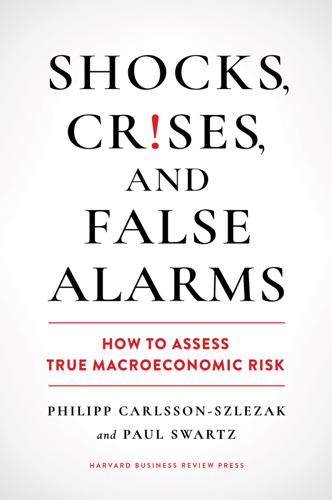
Shocks, Crises, and False Alarms: How to Assess True Macroeconomic Risk
by
Philipp Carlsson-Szlezak
and
Paul Swartz
Published 8 Jul 2024
Mark Stenberg, “How the CEO of Pepsi, by Bartering Battleships and Vodka, Negotiated Cold War Diplomacy and Brought His Soda to the Soviet Union,” Business Insider, November 11, 2020, https://www.businessinsider.com/ceo-of-pepsi-brought-soda-to-the-soviet-union-2020-11. 7. A 2022 Goldman Sachs report found that US companies have engaged in limited reshoring so far, as they look to strengthen supply-chain resilience. Instead, companies have focused on inventory overstocking and broadening their supplier base. Jan Hatzius et al., “Strengthening Supply Chain Resilience: Reshoring, Diversification, and Inventory Overstocking,” Goldman Sachs, March 27, 2022, https://www.gspublishing.com/content/research/en/reports/2022/03/28/a69df56c-b50e-4af5-9295-7fc7be33e096.html. 8.
…
The era of global convergence spawned an integrated trade architecture that firms spun into an intricate web of global value chains, lower costs, and profit expansion. As the simple narrative of geopolitical convergence gives way to the complex one of divergence, it is fair to expect trade architecture to adjust again, along with economic knock-on effects. In the popular telling, globalization is giving way to deglobalization, offshoring to reshoring. The benefits that were gained are supposedly to be lost. But trade is a perfect example of treacherous extrapolation and the simplification that occurs when translating geopolitical forces to economic outcomes, about which we warned in the preceding two chapters. Consider that despite (nearly) a decade that has seen Brexit, trade wars, and decoupling, the volume of global trade has continued to climb.
…
West Germans built gas pipelines from the Soviet Union under Willy Brandt in the 1970s.5 Pepsi sold fizzy drinks in the Soviet Union and was paid in scrap metal.6 China is far more integrated into the world economy than the Soviet Union ever was, so these sorts of interchanges will likely remain more plentiful. The multitude of stakeholders that have traded with China for decades have strong incentives to maintain links. This is well illustrated by the limitations of reshoring predictions.7 Existing value chains are rarely dismantled outright. Rather, gradual decisions are made to situate incremental capacity closer to home. There is no certainty about the extent of geographical separation. Which industries will separate the most is also uncertain. The trade in cutting-edge electronics was seen only a handful of years ago as a success of globalization.
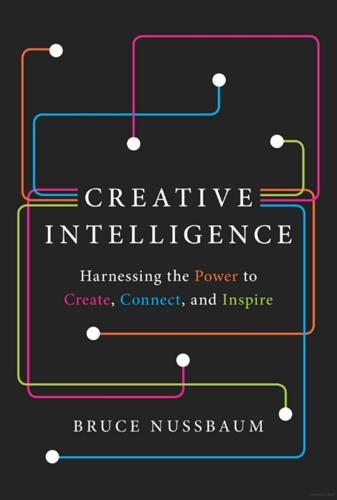
Creative Intelligence: Harnessing the Power to Create, Connect, and Inspire
by
Bruce Nussbaum
Published 5 Mar 2013
See also Knowledge mining cultivating Creative Intelligence, 257–61 gaming and process of, 140–41 Lee, Ben, 240 Lee, Cheng-Chung, 61 Lee, Jay, 244–45 Lee, Tzong-Ming, 61 Lenovo, 52–56, 101, 226 Leopard frogs, 71–72 Levy, Shawn, 4 Liberal arts education, 247 LinkedIn, 215 Little Alouette (company), 162–66 LKS Partners, 107–9 Local crowdfunding, 244–45 Local economies Indie Capitalism and, 38, 247–48 making and, 159 reshoring and, 160–62 Local networks, pivoting and, 204–8 Locavore food movement, 173 Lowry, Adam, 45–48 Lumi Process printing system, 198–99 MacCready, Paul B., 141 McGonigal, Jane, 131–32 Macintosh computer, 43–44 Mackay, Charles, 229 Mack Center for Technological Innovation, 234 McLain, Neal, 109 McQueen, Alexander, 56 Madonna, 66 Magic circle concept, 126–27, 142, 194 Make-it-local culture, 159 Make magazine, 152–53 MakerBot (company), 168–69 Maker Faires, 152–53 Makers’ universities, 169 Making, 147–75 3-D printing and, 167–71 creating satisfying lives and stronger economy with, 171–75 as Creative Intelligence competency, 36, 155 financial capitalism and beginnings of culture of, 149–56 General Electric’s reshoring and, 160–62 homegrown economy and, 156–59 Indie Capitalism and, 248 Little Alouette company on Etsy platform and, 162–66 private commercial rocket launch and, 147–49 Maliq, Irish, 91–92 Managers, wandering, 190–99 Manchanda, Sonia, 29, 75–76 Mandel, Michael, 234 Manufacturing, reshoring of, 160–62, 174–75. See also Outsourcing Mapping creativity networks, 81 Market norms vs. social norms, 183 Markets, Indie Capitalism and, 248 Martha Stewart Media, 165 Martin, Roger, 14, 233, 253 Mass customization, 175 May, Rollo, 23 Mayo Clinic, 34 Meaning in Capitalism, 241 embedding, in products, 183–90 engagement framing and, 102 immersion in discovery of, 52–57 Indie Capitalism and, 38 knowledge mining and, 45, 77, 83 pivoting and, 219–20 Measurement, creativity, 11–14, 251–57 Measurement, efficient market theory and, 228 Mechanical reproduction, 186 Meckling, William, 230 Memorial Sloan-Kettering Cancer Center, 91–92 Mergers, expansion through, 224 Method (company), 45–48, 52, 212 Meyer, John, 196 Micklus, Sam, 258–59 Microfinance, 76 Miesen, Alexis, 156–58 Miethner, Emily, 181, 204 Mini Cooper, 66 Minimal (company), 87 Mining, knowledge.
…
GE is spending $1 billion to bring manufacturing back to its plants in Louisville, Kentucky; Bloomington, Indiana; and Decatur, Alabama. Some 1,300 jobs will be added when the refurbishing of the facilities is completed. Water heaters and washing machines, now made in Asia, and refrigerators, currently made in Mexico, will be on assembly in Louisville. Why the shift to “reshoring”? Lower prices for technology make manufacturing at home in the United States easier. And rising wages in China, Mexico, and other suppliers coupled with falling wages in the United States have made it more advantageous to make things in America. Finally, and perhaps most important, being close to customers who increasingly want to participate in the design of their consumer goods makes manufacturing across oceans and time zones problematic.
…
• Indie Capitalism would be more local and less global. Making things locally and in the United States would be a key priority, and this emphasis on localization would also change the way many global corporations operate domestically. The shift is beginning at a number of companies, with Boeing, Caterpillar, and GE “reshoring” a small part of their production back to the United States and publicizing the move in high-profile ad campaigns that reflect a growing demand for more domestic production. Finally, localism will require global corporations to adopt the values of the American local movement, paying workers higher wages, improving working conditions.

The Impulse Society: America in the Age of Instant Gratification
by
Paul Roberts
Published 1 Sep 2014
It’s a workplace version of the self-absorption and narcissism that has already infected much of the rest of life—and hardly the sort of attitude one imagines at the forefront of any industrial renaissance. There is a more fundamental reason to be skeptical of any imminent turnaround in the current hollowing of the job market in the Impulse Society. So much of the current investment in innovation is actually intended to prevent a turnaround from happening. Even if the reshoring movement were to pick up steam, the reshored jobs would be nowhere nearly as numerous as the ones that left. That’s because, in the two decades since the offshoring trend kicked in, multiple generations of automation technologies have continued to reduce labor demands. Consumer products firms are experimenting with sealed, fully automated assembly lines, where humans only supervise and fix things.
…
And, in fact, in the aftermath of the Great Recession, some in the business world seemed unhappy with its chosen path. The offshoring miracle was losing some of its glow. There were continuing problems with quality and communication. Many foreign workers were demanding substantially higher wages. Slowly, some Western firms began bringing back some offshored jobs—a shift that was quickly dubbed reshoring, and has since spurred a lot of talk of an American manufacturing renaissance. At the same time, the widening gap between job requirements and workers’ skills was becoming so large and unsustainable that the education sector was under heavy pressure to reinvent itself. Of particular note have been efforts to upgrade education with the efficiencies to digital technology.
…
“If I was to take a guess, I would say that ten years from now, we’re much more likely to have labor shortages than job shortages.”24 For Mandel and others, our innovation-and-job machine hasn’t stalled—rather, it has been delayed by the massive complexity of today’s technical challenges, and a lot of unnecessary government regulation, and is now poised for a major breakout. And yet, while it’s clearly the case that the innovation-jobs machine is nowhere near tapped out, even positive trends such as reshoring and a biotech revolution will be hard-pressed to counter the larger trends now in motion without a much deeper shift in our impulsive approach to innovation. To quote another economist, John Maynard Keynes, “Markets can remain irrational a lot longer than you and I can remain solvent.” And there have been many developments in our emerging, impulsive economy that will forestall any sort of market correction to our myopic innovation strategies.
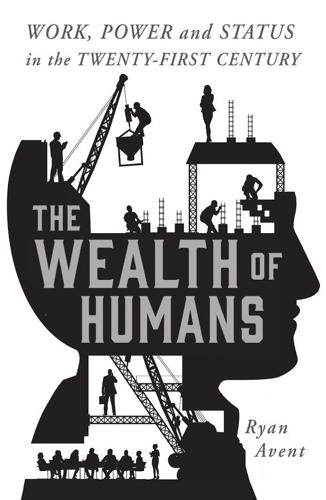
The Wealth of Humans: Work, Power, and Status in the Twenty-First Century
by
Ryan Avent
Published 20 Sep 2016
The growing importance of knowledge (and the growing irrelevance of other cost sources) means that the advantage to rich-world firms of moving anything abroad is decreasing. ‘Reshoring’ in manufacturing, or the relocation of industrial production back to the rich economies that were priced out of such businesses decades ago, is often framed as a labour-cost phenomenon and a potential boon for middle-skill workers in advanced economies: with Chinese wages rising, some believe, it is increasingly attractive for firms to keep assembly in America, and to employ thousands of manufacturing workers in the process. But that is not, for the most part, what is occurring. Reshoring is predominantly a function of the rising knowledge-intensity of production, which means that variations in the cost of unskilled labour no longer matter all that much.
…
Better for Tesla to keep production close at hand (in Fremont, California, on the eastern shore of San Francisco Bay) where its skilled engineers can keep a watchful eye on the code operating the plants, than to move assembly abroad in search of modest savings on the wage bill. And sure enough, the reshoring phenomenon, where it has occurred, has not brought back mass employment of less-skilled workers. That means that economies which were hoping to establish an industrial foothold for themselves by using their low labour costs to wiggle onto a supply chain are increasingly out of luck. There are exceptions, but they are of a particular and unhelpful sort: where labour is so incredibly cheap that it remains economical to use people in place of available technologies.
…
Acemoglu, Daron ageing populations agency, concept of Airbnb Amazon American Medical Association (AMA) anarchism Andreessen, Marc Anglo-Saxon economies Apple the iPhone the iPod artisanal goods and services Atkinson, Anthony Atlanta, Georgia austerity policies automation in car plants fully autonomous trucks of ‘green jobs’ during industrial revolution installation work as resistant to low-pay as check on of menial/routine work self-driving cars and technological deskilling automobiles assembly-line techniques automated car plants and dematerialization early days of car industry fully autonomous trucks self-driving cars baseball Baumol, William Belgium Bernanke, Ben Bezos, Jeff black plague (late Middle Ages) Boston, Massachusetts Brazil BRIC era Bridgewater Associates Britain deindustrialization education in extensions of franchise in financial crisis (2008) Great Exhibition (London 1851) housing wealth in and industrial revolution Labour Party in liberalization in political fractionalization in real wages in social capital in surpassed by US as leading nation wage subsidies in Brontë, Charlotte Brynjolfsson, Erik bubbles, asset-price Buffalo Bill (William Cody) BuzzFeed Cairncross, Frances, The Death of Distance (1997) capital ‘deepening’ infrastructure investment investment in developing world career, concept of cars see automobiles Catalan nationalism Central African Republic central banks Chait, Jonathan Charlotte chemistry, industrial Chicago meat packers in nineteenth-century expansion of World’s Columbia Exposition (1893) China Deng Xiaoping’s reforms economic slow-down in era of rapid growth foreign-exchange reserves ‘green jobs’ in illiberal institutions in inequality in iPod assembly in technological transformation in wage levels in Chorus (content-management system) Christensen, Clayton Cisco cities artisanal goods and services building-supply restrictions growth of and housing costs and industrial revolution and information membership battles in rich/skilled and social capital clerical work climate change Clinton, Hillary Coase, Ronald Columbia University, School of Mines communications technology communism communities of affinity computing app-based companies capability thresholds cloud services cycles of experimentation desktop market disk-drive industry ‘enterprise software’ products exponential progress narrative as general purpose technology hardware and software infrastructure history of ‘Moore’s Law’ and productivity switches transistors vacuum tubes see also digital revolution; software construction industry regulations on Corbyn, Jeremy Corliss steam engine corporate power Cowen, Tyler craft producers Craigslist creative destruction the Crystal Palace, London Dalio, Ray Dallas, Texas debt deindustrialization demand, chronically weak dematerialization Detroit developing economies and capital investment and digital revolution era of rapid growth and industrialization pockets of wealth in and ‘reshoring’ phenomenon and sharp slowdown and social capital see also emerging economies digital revolution and agency and company cultures and developing economies and distance distribution of benefits of dotcom tech boom emergence of and global imbalances and highly skilled few and industrial institutions and information flows investment in social capital niche markets pace of change and paradox of potential productivity and output and secular stagnation start-ups and technological deskilling techno-optimism techno-pessimism as tectonic economic transformation and trading patterns web journalism see also automation; computing; globalization discrimination and exclusion ‘disruption’, phenomenon of distribution of wealth see inequality; redistribution; wealth and income distribution dotcom boom eBay economics, classical The Economist education in emerging economies during industrial revolution racial segregation in USA and scarcity see also university education electricity Ellison, Glenn Ellison, Sara Fisher emerging economies deindustrialization economic growth in education in foreign-exchange reserves growth in global supply chains highly skilled workers in see also developing economies employment and basic income policy cheap labour as boost to and dot.com boom in Europe and financial crisis (2008) ‘green jobs’ low-pay sector minimum wage impact niche markets in public sector ‘reshoring’ phenomenon as rising globally and social contexts and social membership as source of personal identity and structural change trilemma in USA see also labour; wages Engels, Friedrich environmental issues Etsy euro- zone Europe extreme populist politics liberalized economies political fractionalization in European Union Facebook face-recognition technology factors of production land see also capital; labour ‘Factory Asia’ factory work assembly-line techniques during industrial revolution family fascism Federal Reserve financial crisis (2008) financial markets cross-border capital flows in developing economies Finland firms and companies Coase’s work on core competencies culture of dark matter (intangible capital) and dematerialization and ‘disruption’ ‘firm-specific’ knowledge and information flows internal incentive structures pay of top executives shifting boundaries of social capital of and social wealth start-ups Ford, Martin, Rise of the Robots (2015) Ford Motor Company fracking France franchise, electoral Friedman, Milton Fukuyama, Francis Gates, Bill gender discrimination general purpose technologies enormous benefits from exponential progress and skilled labour supporting infrastructure and time lags see also digital revolution Germany ‘gig economy’ Glaeser, Ed global economy growth in supply chains imbalances lack of international cooperation savings glut and social consensus globalization hyperglobalization and secular stagnation and separatist movements Goldman Sachs Google Gordon, Robert Gothenburg, Sweden Great Depression Great Depression (1930s) Great Exhibition, London (1851) Great Recession Great Stagnation Greece ‘green jobs’ growth, economic battle over spoils of boom (1994-2005) and classical economists as consistent in rich countries decline of ‘labour share’ dotcom boom emerging economies gains not flowing to workers and industrial revolution Kaldor’s ‘stylized facts of’ and Keynes during liberal era pie metaphor in post-war period and quality of institutions and rich/elite cities rich-poor nation gap and skilled labour guilds Hansen, Alvin Hayes, Chris, The Twilight of the Elites healthcare and medicine hedge funds and private equity firms Holmes, Oliver Wendell Hong Kong housing in Bay-Area NIMBY campaigns against soaring prices pre-2008 crisis zoning and regulations Houston, Texas Huffington Post human capital Hungary IBM identity, personal immigration and ethno-nationalist separatism and labour markets in Nordic countries and social capital income distribution see inequality; redistribution; wealth and income distribution India Indonesia industrial revolution automation during and economic growth and growth of cities need for better-educated workers and productivity ‘second revolution’ and social change and wages and World’s Fairs inequality and education levels between firms and housing wealth during industrial revolution during liberal era between nations pay of top executives rise of in emerging economies and secular stagnation in Sweden wild contingency of wealth see also rich people; wealth and income distribution inflation in 1970s hyperinflation information technology see computing Intel interest rates International Space Station (ISS) iRobot ISIS Italy Jacksonville, Florida Jacquard, Joseph Marie Japan journalism Kaldor, Nicholas Keynes, John Maynard Kurzweil.
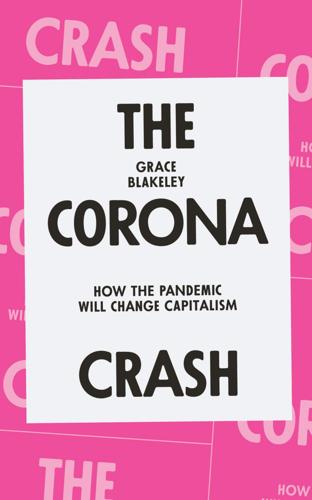
The Corona Crash: How the Pandemic Will Change Capitalism
by
Grace Blakeley
Published 14 Oct 2020
In others, the process merely entailed greater levels of extraction by capitalists in the Global North. Many newly independent states in the Global South didn’t have the power to boost domestic industry as the Chinese state did, so foreign direct investment was focused on multinationals extracting commodities from these countries, and surplus value from their workers, while reshoring the profits to the Global North, paying off domestic capitalists and functionaries for the privilege. The profits from production undertaken in the imperial periphery were sucked into asset markets in the global North – often via tax havens – supporting the process of financialisation and deepening inequalities between global North and South.22 The finance-led growth regime that has emerged over the course of the last forty years is not the first unique mode of accumulation in the history of capitalism.
…
Those states first to industrialise were the first to build multinational corporations and organised workforces, which won a series of victories that pushed up the price of their labour-power. States supported domestic corporations in accessing cheap labour and new markets abroad, first through military and then through political-economic imperialism: asymmetric trade and investment treaties, the reshoring of international profits and pressure to adopt ‘free market’ economic policies from wealthy states and the international organisations they support.8 The international division of labour under contemporary globalisation continues to be structured by imperialistic relationships between states. The value chains used by many large monopolies engaged in commodities production span the globe – low valueadded activities take place in the periphery, where profits are often generated, while high value-added activities take place in the core, where profits are repatriated.9 For ‘tech’ firms like Apple, which derive most of their profits from ordinary commodity production, these relationships are very obvious: hyper-exploited Foxconn workers in China manufacture iPhones while largely unproductive workers in the ‘head office’ located in the US benefit from inflated wages.10 Although it is far from consensual, modern-day imperialism is not primarily enforced using violence.
…
Mainstream economists claimed that lowincome countries should focus on their ‘comparative advantage’ by exporting commodities to the rest of the world – which meant ending subsidies to domestic industry, ‘freeing’ the private sector from regulation and state intervention, and removing constraints on capital mobility. In fact, these measures simply made it easier for multinational corporations to enter the economies of the Global South and displace domestic capitalists before reshoring their profits to the Global North. It also made it easier for elites to siphon their cash out of the country and store it abroad, often in tax havens. Meanwhile, domestic producers faced huge barriers to exporting their goods on a global market weighted towards core countries, which used their huge resources to protect their domestic producers.
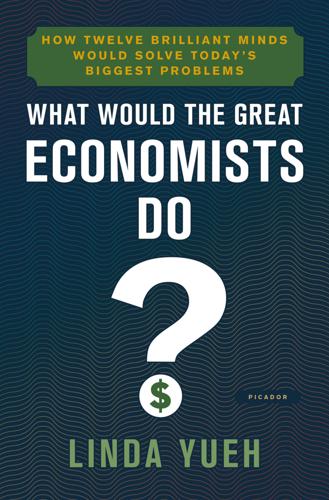
What Would the Great Economists Do?: How Twelve Brilliant Minds Would Solve Today's Biggest Problems
by
Linda Yueh
Published 4 Jun 2018
Britain ranks above the world average, but lags behind other countries like the US as well as Germany. Could the UK also experience a reshoring of manufacturing? One issue is a scarcity of STEM workers, which is often mentioned as an impediment for UK employers in business surveys. So, where does this leave advanced economies like Britain and America? Even if manufacturing output is reshored back to the US or the UK, manufacturing is unlikely to become the biggest part of the economy. Employment will also likely face pressure from robotics and automation. Still, the US experience with the reshoring of production holds lessons for Britain and others as to how to become more competitive in high-end manufacturing, which in turn has implications for what drives growth and also a nation’s trade position.
…
The company working with Oak Ridge to create the plastics that make the car body strong enough to withstand road stress is a reminder that manufacturing is still based in factories, as is clear from the smell of melting plastic and the loud whirling of machines that accompany this high-tech process. For reshoring and reindustrialization to take hold, therefore, will require people to see industry in a new light. Will Americans really contemplate going back to work on the factory floor? A common concern of companies is the shortage of skilled workers. I conducted an informal survey of students at the University of Tennessee and found that most didn’t see their future in manufacturing.
…
joint-stock companies Jones, Homer Journal of Economic Perspectives Journal of Political Economy JPMorgan Juncker Plan Kahn, Richard Kant, Immanuel Keynes, John Maynard and the backlash against globalization and the Bloomsbury Group and Bretton Woods System and budget deficits counter-cyclical policies and crowding out on depression/recession The Economic Consequences of the Peace fiscal activism and Friedman The General Theory of Employment, Interest and Money and government spending on government’s role in economy and Hayek and investors Keynesian revolution legacy life and times of and Marshall and Niemeyer and paradox of thrift at Paris Peace Conference Prices and Production and public investment and Robbins Robinson and Keynes/Keynesian economics and Schumpeter and ‘socializing investment’ A Tract on Monetary Reform and the Treasury A Treatise on Money wealth Keynes, John Neville Khrushchev, Nikita Knight, Frank Kodak Korea North South Krugman, Paul Krupp Kuznets, Simon labour force growth labour productivity and work incentive laissez-faire landowners Lassalle, Ferdinand Latin America currency crisis (1981–82) see also specific countries League of Nations Lehman Brothers Lenin, Vladimir Leontief, Wassily Lewis, Arthur Lewis, Barbara (‘Bobby’) Life Extension Institute Linda for Congress BBC documentary London London School of Economics and Political Science London Stock Exchange Long Depression (1880s) Lopokova, Lydia Louis XIV LSE see London School of Economics and Political Science Lucas, Jr, Robert Ma, Jack (Ma Yun) Maastricht Treaty macroprudential policy see also central banks; financial stability Malaysia Malthus, Thomas Manchester Mandela, Nelson manufacturing additive (3D printing) automation in China and deindustrialization GDP contribution in UK German high-tech and industrialization see also industrialization Japan ‘manu-services’ ‘March of the Makers’ mass-manufactured goods and national statistics reshoring rolling back deindustrialization process and Smith trade patterns changed by advanced manufacturing US Mao Zedong Maoism ‘March of the Makers’ marginal utility analysis marginalism market forces/economy ‘Big Bang’ (1986) competition see competition and economic equilibrium see economic equilibrium emerging economies see emerging economies Hayek and the supremacy of market forces ‘invisible hand’ and laissez-faire and Marx 4 self-righting markets supply and demand see supply and demand Marshall, Alfred on approach to economics and the backlash against globalization and the Cambridge School and decentralization Economics of Industry and education’s role in reducing inequality and inequality and Keynes and laissez-faire legacy life and times of marginal utility analysis and Marx and poverty Principles of Economics and utility theory Marshall, Mary, née Paley Marx, Heinrich Marx, Henriette, née Pressburg Marx, Jenny, née von Westphalen Marx, Karl and agriculture and the backlash against globalization Capital and capitalism and China and class Communist Manifesto (with Engels) communist theories A Contribution to the Critique of Political Economy doctoral thesis The Eighteenth Brumaire of Louis Bonaparte and Engels journalism life and times of and Marshall and rate of profit and Ricardo and Russia on service sector workers surplus value theory and the Young Hegelians Marx, Laura Marx, Louise Marxism and the Austrian School and unemployment see also Marx, Karl Mason, Edward mathematical economics Mauritius May, Theresa Meade, James median income Menger, Carl mercantilist policies see also Corn Laws Merkel, Angela Mexico middle class China and economic growth and economic inequality and European revolutionaries income and industrialization and Keynes and Heinrich Marx as proportion of world population and Schumpeter social resentment US Mill, James Mill, John Stuart On Liberty Principles of Political Economy Minsky, Hyman Mises, Ludwig von Mitchell, Wesley mobile phones/smartphones monetarism see also Friedman, Milton monetary policy and Friedman tools see also quantitative easing (QE) see also central banks monopolies and Marx natural and Robinson and Schumpeter and Smith and Sraffa monopsony Mont Pelerin Society Morgenthau, Henry mortgage-backed securities (MBS) mortgage lending and the 2008 financial crisis sub-prime Myanmar Myrdal, Gunnar Napoleon I Napoleon III Napoleonic Wars national/official statistics China UK US national debt Austria and central banks China and creditors and debt forgiveness and deficits euro area and foreign exchange reserves and investment Japan major economies owed to foreigners and quantitative easing and Ricardian equivalent UK US Vietnam National Health Service (UK) National Infrastructure Commission (UK) Navigation Acts neoclassical economics convergence hypothesis ‘neoclassical synthesis’ New Neoclassical Synthesis see also Fisher, Irving; Marshall, Alfred; Solow, Robert Neoclassical Synthesis see also Samuelson, Paul New Classicists see also Lucas, Jr, Robert New Deal New Institutional Economics see also North, Douglass New Keynesians see also Stiglitz, Joseph New Neoclassical Synthesis New Rhineland News (Cologne) New Rhineland News: Review of Political Economy (London) new trade theory New York Herald New York Times New York Tribune Newcomb, Simon Newsweek Niemeyer, Sir Otto Nissan Nixon, Richard Nokia non-tariff barriers (NTBs) Nordhaus, William North, Douglass and the backlash against globalization and development challenges doctoral thesis The Economic Growth of the United States from 1790 to 1860 and institutions Institutions, Institutional Change and Economic Performance life and times of Nobel Prize path dependence theory and Smith North, Elizabeth, née Case North Korea Northern Rock Oak Ridge National Laboratory Obama, Barack Occupy movement oil industry Organisation for Economic Co-operation and Development (OECD) Osborne, George Overseas Development Institute (ODI) Oxford University Balliol College Paine, Thomas Paley, Mary Paris Peace Conference path dependence theory see also North, Douglass Peel Banking Act Philips, Lion Philips (electronics company) physical capital Physiocrats Pigou, Arthur Cecil Piketty, Thomas pin-making Pinochet, Augusto Ponzi finance populism Portugal poverty aid and development see economic development challenges eradication/reduction frictional and Marshall and Marx and median income people lifted from in South Africa productivity and agriculture ‘benign neglect’ of Britain’s productivity puzzle and computers and economic growth and education and factor reallocation and Germany and Hayek incentives and industry/industrial revolution and innovation and investment Japan and jobs labour see labour productivity and land low and Marshall moving into higher sectors of and pricing raising and Schumpeter and secular stagnation slow economic and productivity growth and the future and specialization and technology total factor productivity and trade and wages Prohibition protectionism agricultural see also Corn Laws Navigation Acts public-private partnerships public investment and Keynes public spending general government spending see government spending public investment see public investment squeeze see also austerity Puerto Rico quantitative easing (QE) Quantity Theory of Money see also Friedman, Milton; monetarism; Equation of Exchange Rand, Ayn RAND Corporation rate of profit rational expectations theory Reagan, Ronald recession/depression debt-deflation theory of depression Great Depression see Great Depression (1930s) Great Recession (2009) Greece ‘hangover theory’ of Hayek on and Keynes Long Depression (1880s) second recession (1937–38: recession within the Depression) in UK 1970s redistribution Regional Comprehensive Economic Partnership (RCEP) Reich, Robert reindustrialization Reisinger, Anna Josefina Remington Rand rent-seeking research and development (R&D) investment China Research in Motion (RIM) retail trade Rhineland News Ricardian equivalence Ricardo, David and the backlash against globalization and class comparative advantage theory and the Corn Laws Essay on the Influence of a Low Price of Corn on the Profits of Stock The High Price of Bullion international trade theory as a landlord life and times of as a loan contractor and Marx On the Principles of Political Economy and Taxation and Schumpeter and Smith wealth Ricardo, Priscilla Robbins, Lionel Robinson, Austin Robinson, James Robinson, Joan The Accumulation of Capital and the AEA and the backlash against globalization and communism Economic Philosophy The Economics of Imperfect Competition Essays in the Theory of Employment and imperfect competition Introduction to the Theory of Employment and Keynes and Keynesian economics life and times of and monopolies monopsony theory and Schumpeter and unemployment wage determination theory robotics Rodrik, Dani Rolls-Royce Roosevelt, Franklin D New Deal Russia 1905 Revolution and Lenin and Marx Samsung Samuelson, Paul and the backlash against globalization Economics factor-price equalization theorem Nobel Prize savings for capital investment and inflation and Keynes and the ‘paradox of thrift’ Say, Jean-Baptiste Schmoller, Gustav von Schumpeter, Anna, née Reisinger Schumpeter, Gladys, née Seaver Schumpeter, Joseph and the backlash against globalization as banker/investor Business Cycles and capitalism Capitalism, Socialism and Democracy ‘creative destruction’, innovation and ‘The Crisis of the Tax State’ and the Econometric Society economics and entrepreneurs on Fisher and Hayek History of Economic Analysis and Keynes legacy life and times of The Nature and Content of Theoretical Economics and perfect competition and Ricardo and Robinson Theory of Economic Development wealth Schumpeter, Romaine Elizabeth, née Boody Schumpeter Group of Seven Wise Men Schwartz, Anna Jacobson Schwarzenegger, Arnold Scottish Enlightenment Seaver, Gladys Ricarde see Schumpeter, Gladys secular stagnation self-interest services sector China and deindustrialization financial services see financial services global trade in services human capital investment invisibility of liberalization ‘manu-services’ and Marx move away from and national statistics output measurement productivity and innovation and Smith Trade in Services Agreement (TiSA) UK US shadow banking Shiller, Robert silver Singapore Skidelsky, Robert skill-biased technical change skills shortage small and medium-sized enterprises (SMEs) smartphones/mobile phones Smith, Adam and the backlash against globalization as Commissioner of Customs for Scotland economic freedom on ‘invisible hand’ of market forces and laissez-faire economics legacy life and times of and manufacturing and Marx and North and Physiocracy on rate of profit and rebalancing the economy and Ricardo and the services sector and state intervention The Theory of Moral Sentiments The Wealth of Nations social capital social networks social services socialism communist see communism vs welfare state capitalism Solow, Barbara (‘Bobby’), née Lewis Solow, Robert and the backlash against globalization with Council of Economic Advisers doctoral thesis economic growth model ‘How Economic Ideas Turn to Mush’ John Bates Clark Medal and Keynesian economics life and times of Nobel Prize Presidential Medal of Freedom and technological progress Sony Sorrell, Sir Martin South Africa South Korea Soviet Union and China Cold War collapse of see also Russia Spain specialization spontaneous order Sraffa, Piero stagflation Stanley Black & Decker state government regulation intervention in the economy laissez-faire STEM (science, technology, engineering and mathematics) workers sterling Stigler, George Stiglitz, Joseph stocks and Fisher and interest rates US railroad Strachey, Lytton Strahan, William Strong, Benjamin Sturzenegger, Federico Summers, Lawrence supply and demand see also market forces/economy: ‘invisible hand’ Sustainable Development Goals (SDGs) Taiwan Tanzania tariffs taxation and austerity devolved powers of flat for government deficit spending before Great Depression and inequality and investment Japan and Marshall negative income tax to pay off national debt Pigouvian tax progressive and Reagan redistribution through Schumpeter on Smith on Taylor, John Taylor, Overton H.
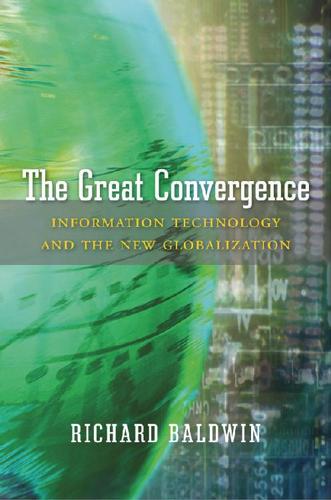
The Great Convergence: Information Technology and the New Globalization
by
Richard Baldwin
Published 14 Nov 2016
An unusual feature of the convexity of coordination costs is that offshoring will tend to be delayed in the sense that a stage that would be cheaper to do abroad will stay at home to economize on coordination costs. But when offshoring does occur, “too many” stages will go since clustering stages saves on coordination costs. This is called offshore “overshooting.” Thinking this through, it also means that as coordination costs fall further, some stages will be “reshored”—a phenomenon that seems to have started in the 2010s. Fractionalization and Offshoring Interactions: The Nature of Jobs Fractionalization and offshoring have, so far, been considered separately, yet they can and do interact in important ways—ways that might involve firms changing the mix of tasks per occupation, or oc cupations per stage, to take advantage of offshoring possibilities.
…
Importantly, this crystalized my view that the second unbundling should be thought of as a phenomenon with two basic elements, namely fractionalization of the production process and within-firm technology transfers. Tony Venables and I looked at theoretical interactions between offshoring and agglomeration in a piece that predicted, among other things, the reshoring of offshored stages that has been observed in recent years. When it comes to globalization and growth takeoffs, Philippe Martin, Gianmarco Ottaviano, and I wrote down the first model of the agglomeration-competitiveness growth cycle that I use in this book to explain the Great Divergence. Philippe and I later developed a strand of theory where the interplay between trade costs and knowledge spillovers could result in the Great Divergence in the nineteenth century and the Great Convergence in the twenty-first century.
…
See also developing nations; North Africa Against the Tide: An Intellectual History of Free Trade (Irwin), 119 Age of Discovery, European, 38, 39–40, 46 agglomeration (industrial clustering)/dispersion: cities and, 26; coordination and, 203, 204; free trade and, 129, 136, 194–196; future and, 290, 292–293; geographical distance and, 267; globalization and, 2, 19, 77, 127–130, 136, 140, 143; human capital and, 235; innovation and, 116, 123, 124; jobs and, 232; New Economic Geography and, 186–196, 189f, 194f, 214; Old Globalization (first unbundling) and, 122–124, 123f, 124f; specialization and, 202, 208; stickiness and, 231, 233, 235; tacit knowledge and, 230; transport costs and, 212; wages and, 114–115, 214–215. See also offshoring; reshoring; specialization; stickiness agriculture and food: bubonic plague and, 36; China and, 44; climate change and, 22f; first bundling and, 24–46; migration and, 138; multiple equlibria and, 255f–256; New Globalization/poverty line and, 242; New vs. Old Worlds and, 59, 61; population growth and, 26–30; production/consumption clusters and, 18, 21, 45, 116; productivity and, 59; shift to industry and, 277; summary, 109.

MegaThreats: Ten Dangerous Trends That Imperil Our Future, and How to Survive Them
by
Nouriel Roubini
Published 17 Oct 2022
Deglobalization, protectionism, and inward-oriented policies intended to protect workers and firms will punish economies rather than bolster them. By restricting global trade in goods, services, capital, technology, data, and investments, they will impose higher import prices, rising costs of production, and will sap growth. 4. Reshoring of manufacturing may improve supply chain security, but shifting production from low-cost emerging markets such as China to friendlier but higher-cost developed markets (“friend-shoring”) will spur cost and price increases. When security replaces efficiency in allocating capital, costs of productions will rise.
…
One path favors a course of trade that continues to unite an efficient global marketplace while compensating or retraining workers left behind. Consumers worldwide will continue to enjoy lower prices while employment in emerging markets lifts millions of global citizens out of poverty. The opposite path, call it deglobalization, favors protectionist policies aimed at bringing lost jobs back home, aka reshoring, and preventing jobs from moving abroad. As appealing as protectionism may sound, when tried before, it toppled the economic ladder for nearly everyone. That is why deglobalization is a megathreat. Deglobalization geared to preserving twentieth-century factory jobs will backfire, crippling essential trade in much larger markets for services, technology, data, information, capital, investment, and labor.
…
Economist Dani Rodrik and others argue that hyperglobalization, democracy, and national sovereignty create an “inconsistent trilemma.” To maintain democracy and sovereignty, hyperglobalization needs to be curtailed. More recently, as the consequence of the COVID-19 crisis and the ensuing disruptions to global supply chains, logistics, and transportation networks, calls for reshoring or friend-shoring of manufacturing and global supply chains have become louder and more popular. Indeed, global pandemics that spread faster because of globalization have first led to draconian restrictions of the movement of people—as during the peak of COVID-19—when foreign travel became nearly impossible and is still hampered.
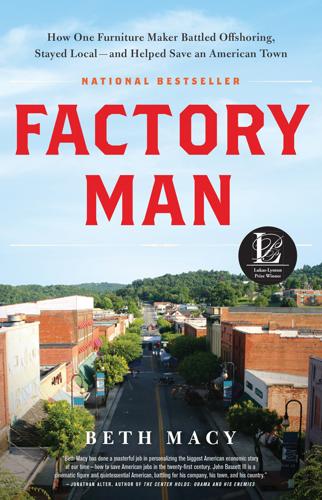
Factory Man: How One Furniture Maker Battled Offshoring, Stayed Local - and Helped Save an American Town
by
Beth Macy
Published 14 Jul 2014
“Back then, they could sell with no profit at all and get a check back from their government as a thank-you for exporting.” That stopped with the start of the housing recession in 2008 and annual double-digit wage hikes in China. “Now they’ve shifted those rewards to high tech to raise the standard of living for their citizens,” Epperson said. That shift continues to prompt a small but growing reshoring movement as companies come back to the United States. New American GE and Caterpillar factories have gone up and there’s even a new giant Ashley Furniture upholstery plant and distribution facility south of Winston-Salem, but there have been no major wood furniture-making endeavors in the mix. “Remember,” Epperson said, “furniture has always been used as a way to educate agricultural workers on how to work indoors in a factory with heavy equipment.”
…
(It maintains two Henry County warehouses, which together employ about seventy.) Though it still imports adult furniture from Indonesia and Vietnam, Stanley adopted a new kind of blended strategy in 2011: At the same time it closed the Stanleytown plant, the company pumped $8 million in Byrd money into new equipment for its aging plant in Robbinsville, North Carolina, reshoring—or bringing back to the United States—its Young America children’s line. The change was prompted in part by a string of crib recalls that had roiled the industry, most involving Chinese imports (though Stanley’s biggest voluntary recall of cribs, involving its 2nd Nature Built to Grow cribs, were made in Slovenia).
…
He wished his dad would learn to Skype on the iPad he bought him for Christmas. Stanley’s Filipino engineers, who see their families a few times a year, shared similar feelings about being so far from home. Wanda Perdue might still be looking for full-time employment, I thought, but at least she has her family nearby. Though talk of reshoring manufacturing is heating up—and companies like Ford, Apple, GE, and Caterpillar are bringing some production back to the United States—economists and furniture analysts alike doubt that low-skilled furniture-making will ever be what it once was in America. The exceptions? Niche markets like high-end furniture, hospitality, upholstery, and cabinetmaking, all of which tend to rely on made-to-order specs.
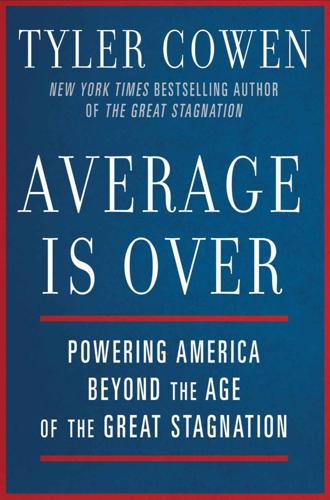
Average Is Over: Powering America Beyond the Age of the Great Stagnation
by
Tyler Cowen
Published 11 Sep 2013
One reason for this is simply that America can sell its artificial intelligence products to the rest of the world, but a deeper mechanism is operating too. If there aren’t many workers in a plant or project, hiring in a wealthy country brings less of a wage penalty. Indeed, some manufacturing plants are moving back to the United States—“reshoring” it is called—and those are the plants that use lots of robots and artificial intelligence. The technical proficiency is in the West for the most part and yet these plants will still create American jobs indirectly—through infrastructure, the service sector, and distribution—even if there are relatively few human jobs within the plant itself.
…
On the German population growing again, see Suzanne Daley and Nicholas Kulish, “Brain Drain Feared as German Jobs Lure Southern Europeans,” The New York Times, April 28, 2012. On job growth in services, see A. Michael Spence and Sandile Hlatshwayo, “The Evolving Structure of the American Economy and the Employment Challenge,” Council on Foreign Relations, March 2011. For one recent look at reshoring, see John Markoff, “Skilled Work, Without the Worker,” The New York Times, August 18, 2012. Chapter 10: Relearning Education For figures on K–12, see Stephanie Banchero and Stephanie Simon, “My Teacher is an App,” The Wall Street Journal, November 12, 2011. The point about stronger incentives for innovation I owe to Alex Tabarrok.
…
, 7, 12, 157 Jobs, Steve, 25 Jones, Benjamin, 216 Journal of the American Statistical Association, 10 journalism, 9 Junior (chess program), 68, 72, 78 Jurafsky, Dan, 12–13 K-12 education, 4, 168, 181–82 Kabbalah, 153 Kahneman, Daniel, 105, 227 Kaiser Family Foundation, 60 Karlan, Dean, 223 Kasparov, Garry, 7, 69, 77, 80–81, 110, 124, 157 Kaufman, Larry, 203 Kempelen, Wolfgang von, 149 Kepler, Johannes, 153 Keynesian economics, 53–54, 56, 226 Khan Academy, 180, 184–85 KIPP schools, 199 Knoxville, Tennessee, 244 Komodo (chess program), 68, 203 Kraai, Jesse, 188 Kramnik, Vladimir, 103, 109, 149–50 Kronrod, Alexander, 68 Krueger, Alan, 59 Krugman, Paul, 180–81, 227 Kurzweil, Ray, 6, 137–38 labor market and age of workers, 41–42, 51–52, 62–63 and benefit costs, 36, 59, 113 careers in the changing market, 41–44 changing worker profiles, 29–40 and computer skills, 21, 33 and conscientiousness of workers, 201–2 and factor price equalization, 163 and global trends, 3–4 and healthcare reform, 238 and hiring costs, 36, 59, 60 important worker characteristics, 32 and income trends, 39 labor economics, 226 and layoffs, 54–55, 57–58, 61 and management, 27–29 and man-machine collaboration, 93 and marketing, 22–27 and outsourcing, 163–71 participation rates, 45, 46, 51 polarization in, 37, 55, 231 and “reshoring” trend, 177 and residential segregation, 247–48 and retraining, 202 and the social contract, 229 laboratory science, 100 land prices, 236, 247 language recognition, 119, 139–41 Latin America, 167–68, 170–71, 242 law and legal issues and the changing labor market, 41 costs of employing labor, 36, 59 lawsuits, 36, 59, 60 lawyer ratings, 121 malpractice suits, 128 and medical diagnosis, 128–29 and reliance on computer systems, 128–31 See also regulatory issues layoffs, 54–55, 57–58, 61 Levitt, Steven, 226–27 liberalism, 252, 253–54 libertarianism, 256–57 lie detection, 12–13, 16 The Lights in the Tunnel (Ford), 6 liquidity crunch, 54, 55 Liu, Runjuan, 164 Loebner Prize, 139–40 logistic function, 203 long-term unemployment, 58 machine intelligence.
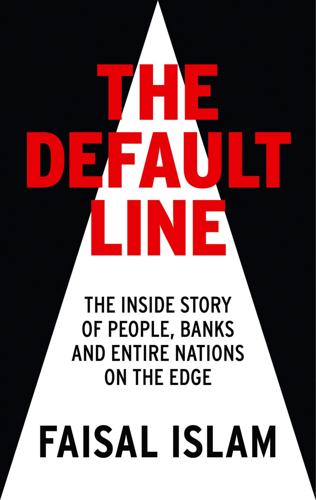
The Default Line: The Inside Story of People, Banks and Entire Nations on the Edge
by
Faisal Islam
Published 28 Aug 2013
They’d have to second-guess emerging trends, the sizes, the colours. They’d have to discount 80 per cent of stock from full price because that equation would inevitably be wrong. Well, nearshoring and reshoring changes all that. The company can get the clothes on the shelves quicker. They can do a test run of, say, 500, and then swiftly reorder. They can shout at somebody in person if the colour is wrong. Reshoring takes huge amounts of risk out of the supply chain. Boohoo’s CEO Chris Bale told me that eighteen months previously 75 per cent of his product came from China. Now over half of it is made in the UK.
…
The GECF’s ambitions have been further thwarted by American exploitation of substantial US reserves of shale gas, which are providing the world’s biggest gas consumer with its own degree of energy independence. In the Gulf of Mexico and on America’s western seaboard, terminals built for liquefied natural gas imports, are now being converted to handle potential gas exports. Manufacturing is being reshored to America, with the promise of cheaper indigenous energy. The US actually overtook Russia as a producer of gas. But the GECF may take comfort from the fact that OPEC itself did not acquire global reach overnight, being largely ignored for over a decade following its birth in Baghdad in 1960, after efforts from the powerful ‘Seven Sisters’ (the cartel of Western oil companies that dominated the global oil industry from the mid-1940s to the 1970s) to drive down crude oil prices.
…
These were the words used in 1844 by Friedrich Engels to describe his visit to the textile mills near the centre of a Manchester booming during Britain’s Industrial Revolution, and home to waves of migrant workers from Ireland. In 2012, a plan was hatched to lure them back. The promise was no less than the return of Manchester’s rag trade, but in a form less dark and less satanic than its nineteenth-century predecessor. Reshoring, rebalancing and reindustrialising Manchester’s textile industry was the call – the rag trade returning to its historic home. In theory, this was the reverse of offshoring, imbalances, and deindustrialisation: just what George Osborne said he wanted for the UK economy. At Headen & Quarmby in Middleton, the retail guru Mary Portas commissioned a range of upscale women’s underwear called ‘Kinky Knickers’.
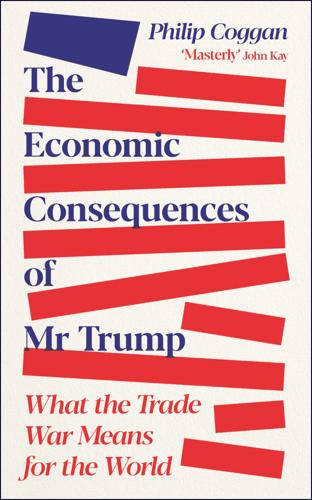
The Economic Consequences of Mr Trump: What the Trade War Means for the World
by
Philip Coggan
Published 1 Jul 2025
The proportion of US workers who are in a union was 9.9 per cent in 2024, down from 20.1 per cent in 1983, according to the Bureau of Labor Statistics.26 Many of those members are in the public sector; the proportion of private-sector workers who are in a union is just 5.9 per cent, down from around one in three in the 1950s.27 Unionised workers are better paid, earning an average $1,337 per week, compared with just $1,137 for their non-unionised counterparts (some of this may be down to occupational differences).28 The problems with reshoring When it comes to low-skilled employment, US manufacturers have a problem: it costs a lot more to make things in the US. Motorola discovered this when it opened a smartphone factory in Fort Worth, Texas, in 2013. Sadly, it closed twelve months later because of high costs.29 And that is hardly surprising since the average pay of a US manufacturing worker is twice that of their Chinese equivalent and six times that of Vietnam.30 Over time, the biggest job losses in US manufacturing occurred in sectors such as textiles or metals, where the lower costs of producers in Asia made it hard for western companies to compete.
…
The company added that it had already cut production and eliminated overtime at its California plant and might delay the opening of a plant in Nevada. That is because the cost of imported iron would force it to increase its prices.35 Given the time taken to build new factories, it will be hard to reshore many products. Manufacturers interviewed by the Wall Street Journal said that it was very tough to find domestic suppliers for some key components, as the businesses were either non-existent, produced in insufficient quantities, or charged prices that were too high.36 One company, Rapid Plastics, which makes coat hangers for department stores, said that all the domestic suppliers of metal hooks had closed or gone abroad.
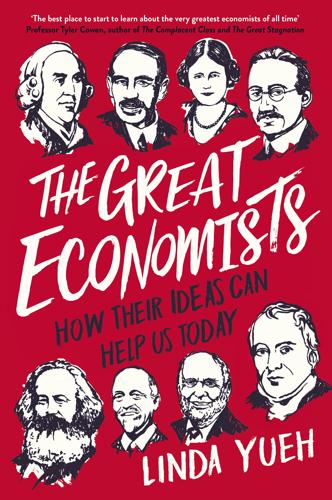
The Great Economists: How Their Ideas Can Help Us Today
by
Linda Yueh
Published 15 Mar 2018
Britain ranks above the world average, but lags behind other countries like the US as well as Germany. Could the UK also experience a reshoring of manufacturing? One issue is a scarcity of STEM workers, which is often mentioned as an impediment for UK employers in business surveys. So, where does this leave advanced economies like Britain and America? Even if manufacturing output is reshored back to the US or the UK, manufacturing is unlikely to become the biggest part of the economy. Employment will also likely face pressure from robotics and automation. Still, the US experience with the reshoring of production holds lessons for Britain and others as to how to become more competitive in high-end manufacturing, which in turn has implications for what drives growth and also a nation’s trade position.
…
The company working with Oak Ridge to create the plastics that make the car body strong enough to withstand road stress is a reminder that manufacturing is still based in factories, as is clear from the smell of melting plastic and the loud whirling of machines that accompany this high-tech process. For reshoring and reindustrialization to take hold, therefore, will require people to see industry in a new light. Will Americans really contemplate going back to work on the factory floor? A common concern of companies is the shortage of skilled workers. I conducted an informal survey of students at the University of Tennessee and found that most didn’t see their future in manufacturing.

The Fourth Industrial Revolution
by
Klaus Schwab
Published 11 Jan 2016
Ensuring that swathes of the globe are not left behind is not a moral imperative; it is a critical goal that would mitigate the risk of global instability due to geopolitical and security challenges such as migration flows. One challenging scenario for low-income countries is if the fourth industrial revolution leads to significant “re-shoring” of global manufacturing to advanced economies, something very possible if access to low-cost labour no longer drives the competitiveness of firms. The ability to develop strong manufacturing sectors serving the global economy based on cost advantages is a well-worn development pathway, allowing countries to accumulate capital, transfer technology and raise incomes.
…
According to the International Federation of Robotics, the world now includes 1.1 million working robots, and machines account for 80% of the work in manufacturing a car.93 Robots are streamlining supply chains to deliver more efficient and predictable business results. Positive impacts – Supply chain and logistics, eliminations – More leisure time – Improved health outcomes (big data for pharmaceutical gains in research and development) – Banking ATM as early adopter – More access to materials – Production “re-shoring” (i.e. replacing overseas workers with robots) Negative impacts – Job losses – Liability, accountability – Day-to-day social norms, end of 9-to-5 and 24-hour services – Hacking and cyber-risk The shift in action An article from The Fiscal Times appearing on CNBC.com states that: “Rethink Robotics released Baxter [in the fall of 2012] and received an overwhelming response from the manufacturing industry, selling out of their production capacity through April … [In April] Rethink launch[ed] a software platform that [allows] Baxter to do a more complex sequencing of tasks – for example, picking up a part, holding it in front of an inspection station and receiving a signal to place it in a ‘good’ or ‘not good’ pile.

The Wires of War: Technology and the Global Struggle for Power
by
Jacob Helberg
Published 11 Oct 2021
The weapons of the Gray War are algorithms and data, and our industrial base must take into account the centrality of dual-use technology. That could mean shifting key medical supply chains to Mexico or manufacturing servers in Germany, far from Beijing and its doctrine of civil-military fusion. Naturally, this will also entail reshoring far more U.S. production. A technology alliance would not only guard against Chinese supply-chain interference, it could also spur greater innovation. For instance, while China is poised to overtake the United States in total R&D spending by the end of the decade, the combined R&D expenditures of the Organisation for Economic Co-Operation and Development—which includes much of NATO and other key allies—exceed China’s by more than 250 percent.49 Drawing on the pooled resources of an Allied Innovation and Industrial Base would enable a Western techno-bloc to stay ahead of its authoritarian adversaries.
…
It’s impractical to think that American companies are prepared to bring back to the U.S. the production of every computer, server, and mobile device as well as everything that connects to a computer—every camera, every keyboard, every mouse and microphone, and every USB key. But according to Diogo Monica, a leading cybersecurity architect, we don’t have to. Instead, he told me, “We can reshore the right components” and ensure that others can be easily inspected and audited. This would help build a “minimum viable industrial capacity,” sufficient not simply to meet a national emergency but to protect our back-end and wage a long-term competition with China. For example, since high-performing microchips are indispensable to everything from artificial intelligence to cell phones, a potential initial area of focus could be the production of semiconductors and microchips.
…
He called for “aggressive investment in new products, in new industries, in new factories, in new science, in big leaps forward,” and concluded that “building is how we reboot the American dream.”29 It is time for tech to take up that challenge—for instance, with more venture capital directed toward advanced manufacturing processes and robotics that would enable us to creatively reshore American industry. The federal government should stand ready to help. A National Infrastructure Bank—proposed in Congress many times—could establish a public-private entity to spur investment in everything from railways to smart grids. Such legislation has included provisions to “bolster manufacturing in the United States” and promote “economic connectivity,” and could be expanded to explicitly include priorities like establishing a national 5G network.30 Instead of fifty-eight manufacturing-related programs across eleven agencies, a standalone National Institute of Manufacturing—modeled on the National Institutes of Health, as Michigan senator Gary Peters has proposed—could be created to implement a national manufacturing strategy.31 The government should also greatly increase funding for small businesses, focusing on the same strategically vital industries China has emphasized in its Made in China 2025 initiative.
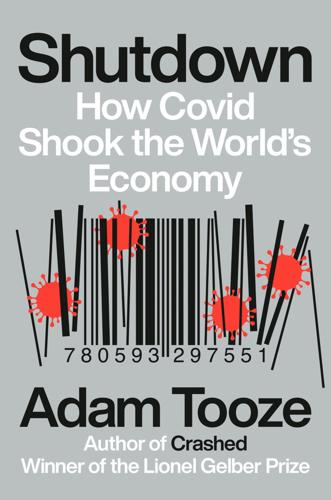
Shutdown: How COVID Shook the World's Economy
by
Adam Tooze
Published 15 Nov 2021
How could it make sense to rely on long-range imports for essential medicines and basic hospital supplies? Reshoring became the rage. Japan even allocated $2.2 billion of its Covid stimulus package to encourage firms to relocate from China.17 The pandemic made self-sufficiency seem alluring, but as defenders of free trade pointed out, the discussion about the global supply of PPE was based in large part on false premises. China was far from monopolizing global production.18 And the idea of a comprehensive reshoring, on account of Covid, was illusory as well.19 It was not just costs, but sophisticated networks of suppliers and systems of logistics that made China attractive for modern manufacturing.
…
Denyer, “Japan Pays 87 Companies to Break from China After Pandemic Exposed Overreliance,” Washington Post, July 21, 2020. 18. R. Baldwin and S. Evenett, “COVID-19 and Trade Policy: Why Turning Inward Won’t Work,” VoxEU, April 29, 2020. 19. A. Beattie, “Coronavirus-Induced ‘Reshoring’ Is Not Happening,” Financial Times, September 30, 2020. 20. “Is a Wave of Supply-Chain Reshoring Around the Corner,” Economist, December 16, 2020. 21. Vyacheslav Polovinko, “Russia Feeds China,” Novaya Gazeta, March 27, 2020. 22. H. Le Thu, “Vietnam: A Successful Battle Against the Virus,” Council on Foreign Relations, April 30, 2020. 23.
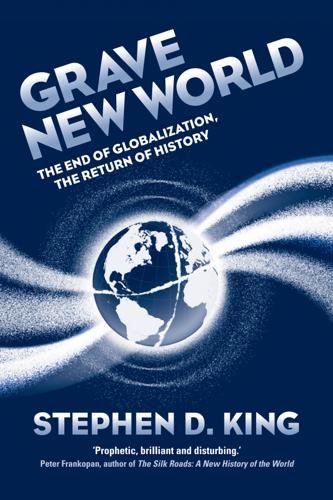
Grave New World: The End of Globalization, the Return of History
by
Stephen D. King
Published 22 May 2017
Learning how to construct suicide vests may, for some, be a noble cause; but for most of us, the information provided by jihadists over the internet is too often used for destructive intent. Replacing cheap labour with robots may provide us with even cheaper goods and services, but it may also lead to a collapse of global supply chains and, with it, a reversal of late twentieth-century globalization. ‘Reshoring’ – thanks to increased automation and robotics – may lead to the rebuilding of economic and financial barriers: nations might then be able to turn themselves into the economic equivalent of ‘gated communities’. Substituting twentieth-century mass warfare for cyber-attacks and cybercrime may, thankfully, hugely reduce the number of battlefield casualties, but it nevertheless leads to heightened mistrust between the world’s superpowers and, via WikiLeaks and other data dumps, threatens personal privacy, intellectual property and ultimately national security.
…
And to the extent that machines can easily be repaired remotely – either by humans or by other machines via the ‘internet of things’ – there will be far fewer working days lost to sickness. Factories could be devoid of human life – with the exception of the man whose job it is to feed the guard dogs.12 The implications of such a model would be profound. Production would increasingly be reshored. The nineteenth-century agglomeration model would be given a new lease of life. The need for global supply chains would rapidly fade. Countries would no longer be mutually dependent on one another, other than for the basics of human life – most obviously commodities and raw materials. Those countries unable to invest in new technologies – including superfast broadband and advanced robots – might find many of their citizens still trapped in poverty.
…
And nationalist politicians would no longer be so easily criticized for their protectionist attitudes. They could simply claim that the economic arguments of the nineteenth and twentieth centuries were no longer relevant: comparative advantage would be less important in a world in which robots could produce the same product virtually anywhere, while, if reshoring took hold, the exchange of capital for governance – the key characteristic of later twentieth-century globalization – would no longer need to take place. Technology may allow us to view the rest of the world more easily, but there is no guarantee that the world becomes more joined up as a result.
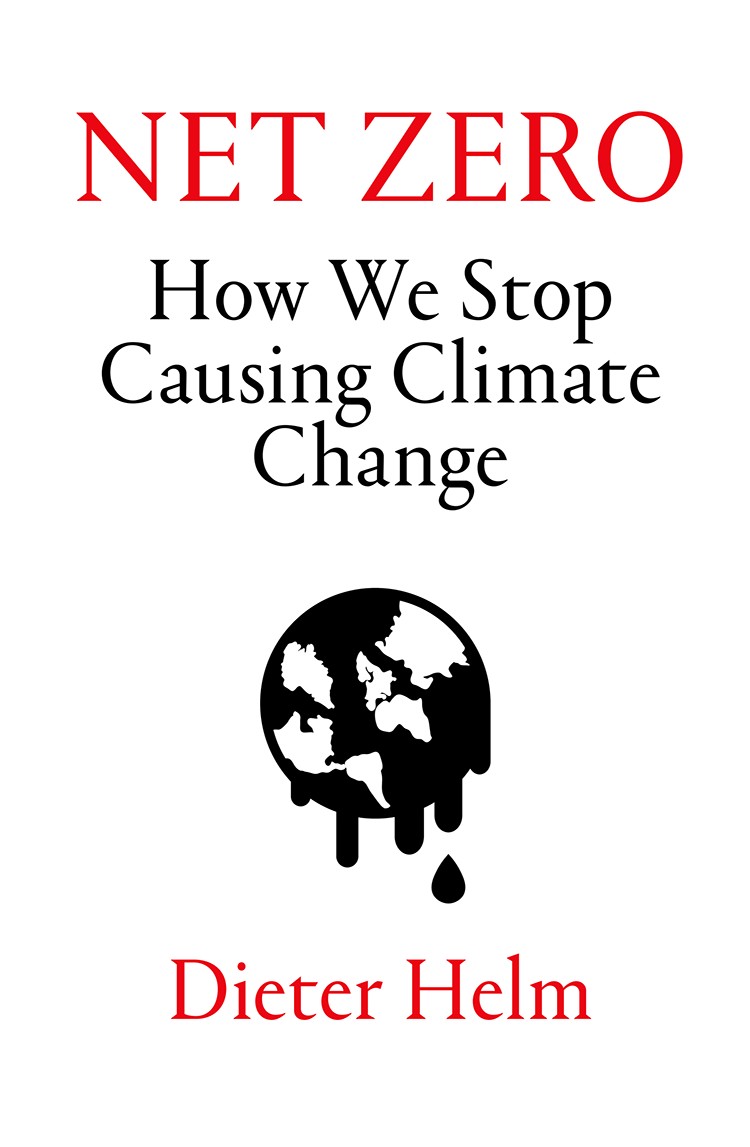
Net Zero: How We Stop Causing Climate Change
by
Dieter Helm
Published 2 Sep 2020
Take the great carbon villain of the piece, the US and especially Trump. The simple mantra that the Europeans are the good guys and the US the bad guys is not quite as black-and-white as it seems. The US has a thriving, energy-intensive manufacturing base. As cheap shale gas has come on-stream, it is not only switching from coal to gas, but it is also reshoring lots of energy-intensive businesses from China and elsewhere, and attracting European investments too. It is swapping energy-intensive imports, based largely on coal, for domestic production based on gas. It is sobering to reflect that the US could even have a better record than Europe on carbon consumption, and without any of the European policies and their costs.
…
In both cases, while there may be long-run technological solutions, like solar- and battery-powered planes and hydrogen-powered ships, the more efficient answer is to reduce the demand. One of the silver linings of the developing trade wars and tariff increases is that they may reduce shipping. Once carbon consumption is considered, and 3D printing and robotics undermine the advantages of cheap labour in the Far East and especially China, reshoring of production is economically more attractive. This may, for non-carbon reasons, be the beginning of a slow but possibly permanent decline in global trade, and with it shipping. Add in carbon border adjustments so that the playing field is properly levelled, and trade should fall a bit further. Also add in the worries about the extended supply chains and security of supplies during the Covid-19 lockdowns.
…
acid rain 25, 194 Africa xiv, xv, 2, 25, 30, 38, 44, 45, 47, 48, 51, 137, 229 agriculture 2, 6, 12, 13, 14, 23, 35–6, 43, 44–5, 70, 76, 86, 87–8, 95, 100, 102, 109, 116, 146–7, 149, 159, 163–80, 181, 183, 192, 197, 198, 206, 220 baseline, the 164–8 biodiversity loss and 2, 5, 100, 164, 165, 168, 169, 171, 172, 174, 180 biofuels and 197–8 carbon emissions and 2, 12, 13, 35–6, 76–7, 146–7, 163–80 carbon price and 167–70, 171, 172, 173, 180 China and 28–9, 35, 45, 180 economics of 76, 165, 166–7, 171, 174 electricity and 13, 166, 168, 174, 178, 180 fertiliser use see fertiliser lobby 14, 110, 164, 165, 169, 170, 197 methane emissions 23, 84, 177, 178, 179 net gain and 172–4 net value of UK 76, 166 new technologies/indoor farming 87–8, 174–9, 180, 213 peat bogs and 2, 179 pesticide use see pesticides petrochemicals and 166 polluter-pays principle and 76, 168–70, 172, 173 pollution 36, 86, 163, 165–6, 168–70, 172, 173, 177–8, 230 public goods, agricultural 170–4, 180 sequestering carbon and 12, 95, 163, 166, 168, 169, 170, 171, 172, 173–4, 177, 179, 180 soils and 2, 146, 163, 164, 165, 166, 168, 169, 171, 172, 175, 179 subsidies 14, 76, 102, 109, 116, 164, 165, 166, 167, 169, 170, 172, 180, 228 25 Year Plan and 179–80 Agriculture Bill (2018), UK 170 air conditioning 135–6, 224, 233 air quality xiii, 13, 25, 46, 52, 61, 70, 135, 153, 177, 180, 201, 216, 230, 232 air transport 3–4, 6, 11, 13, 22, 50, 53, 73, 87, 88, 92, 107, 125, 128, 129, 132, 133, 134, 149, 156–7, 186, 195, 201, 203–5 aluminium 7, 117 Amazon rainforest 2, 34, 35, 95, 145, 149–50, 151, 155, 229, 230 ammonia 35, 137, 191 anaerobic digesters 35, 165, 230 animal welfare 167, 177 antibiotics 93, 165, 174 Arctic 26, 46, 114, 178 artificial intelligence (AI) 32, 175, 220, 231 autonomous vehicles 13, 129, 132, 175, 189–90, 231 Balkans 137–8 Bank of England 121 batteries 6, 31, 131, 135, 141, 183, 184, 185–90, 191, 199, 204, 213, 214, 219, 220, 221, 225, 231 beef 5, 95, 116, 117, 167, 230 Berlin, Isaiah 104 big 5 polluter products 117–18, 120 bin Salman, Mohammad 27 biocrops 36 biodiversity xiv, 2, 5, 12, 13, 28, 35, 51, 76, 94, 100, 148, 149, 152, 153, 158, 159, 164, 165, 168, 169–70, 171, 172, 174, 180, 227, 233 bioenergy 31, 34–5, 36 biofuels 21, 35, 49, 50, 67, 70, 95, 135, 183, 184, 197–8, 210, 230 biomass 32, 34, 49, 50, 67, 69, 109, 146, 147, 151, 210, 217 bonds, government 220 BP 27, 149, 187, 199 Deepwater Horizon disaster, Gulf of Mexico (2010) 147 Brazil 2, 35, 38, 44–5, 47, 95, 145, 149–50, 155, 198 Brexit 42, 47, 56, 117, 165 British Gas 102, 139 British Steel x, 194 broadband networks 6, 11, 90, 92, 125, 126, 127–8, 130–1, 132–3, 135, 140–1, 199, 201, 202, 205, 211, 214, 231, 232 Brundtland Commission 45 BT 127–8, 141 Openreach 214 Burn Out (Helm) ix, xiv Bush, George W. 36, 48, 53, 103 business rates 76, 165 Canada 52, 191, 193 capitalist model 26, 42, 99, 227 carbon border tax/carbon border adjustment xii, 11, 13, 60, 80, 115–20, 194–6, 204 carbon capture and storage (CCS) xiv, 12, 75–6, 95, 109, 146, 147–8, 149, 154, 159, 203–4, 207, 209, 222, 223 Carbon Crunch, The (Helm) ix, xiv, 221 carbon diary 4–5, 8, 10, 11, 64–6, 83, 86, 116, 143, 144, 155, 156, 167, 180, 181, 185, 203, 205 carbon emissions: agriculture and see agriculture by country (2015) 30 during ice ages and warm periods for the past 800,000 years 21 economy and 81–159 electricity and see electricity global annual mean concentration of CO2 (ppm) 19 global average long-term concentration of CO2 (ppm) 20 measuring 43–6 since 1990 1–14, 17–37 transport and see individual method of transport 2020, position in 36–7 UN treaties and 38–57 unilateralism and 58–80 see also unilateralism carbon offsetting xiii–xiv, 4, 5, 12, 34, 45, 72, 74, 79, 94–6, 97, 105, 143–59, 192, 201, 203, 207, 214, 222, 223, 234 for companies 148–50 for countries 151–5 for individuals 155–7 markets 71–2, 110–13, 117, 144, 157–9, 208 travel and 156, 201–3 see also sequestration carbon permits 71–2, 79, 110–13, 117, 144, 208 carbon price/tax xii, xiii, xv, 8, 11, 12, 13, 26, 60, 61, 71, 72, 77, 79, 80, 84, 85–6, 102–3, 105, 106–24, 134, 143, 146, 147, 150, 151–4, 157, 159, 192, 197, 198, 199, 203, 227–30, 232, 234 agriculture and 167, 168, 169–70, 171, 173, 180 domain of the tax/carbon border adjustment xii, 11, 13, 60, 80, 115–20, 121, 124, 192, 194–6, 197, 204, 227 electric pollution and 216–18 ethics of 107–10 floor price 115, 117, 208 for imports 11, 13 prices or quantities/EU ETS versus carbon taxes 110–13 setting 113–15 transport and 192–9 what to do with the money 121–4 where to levy the tax 119–20 who fixes the price 120–1 carbon sinks 2, 5, 166, 169, 203 carboniferous age 34 cars 1, 3, 4, 7, 20, 22, 36, 44, 70, 73, 114, 129, 181, 182, 183, 184–5, 190, 191, 193, 196, 197, 198, 199 see also electric vehicles cartels 39, 40, 43, 45, 46, 47, 56 cattle farming 35, 36, 95, 150, 166, 167, 173, 177, 198 Central Electricity Generating Board (CEGB) 102, 139, 218 cement 6, 7, 26, 29, 34, 87, 117, 171 charging networks, electric vehicle 91, 129–30, 141–2, 184, 185–90, 199, 200, 202, 219 Chernobyl 78 China xi, xv, 1–2, 5, 8, 18, 42, 46, 47, 48, 64, 66, 74, 101, 180, 229 Belt and Road Initiative 28, 45 coal use 1–2, 8, 23–4, 24, 28, 31, 38, 117, 154, 206, 208 Communist Party 2, 27, 42, 46 demand for fossil fuels/carbon emissions 1–2, 8, 18, 20, 22, 23–4, 24, 25, 27–31, 36, 38, 51, 73, 117, 154, 206, 208 export market x–xi, 5, 9, 64, 66, 117, 155, 194 fertiliser use 35 GDP xv, 27, 29 nationalism and 42 petrochemical demand 22 renewables companies 9, 32, 73, 74, 77, 79 Tiananmen Square 42 unilateralism and 58, 59 UN treaties and 46, 47, 48, 53, 54, 55, 58, 59 US trade war 56, 118 Churchill, Winston 183 citizen assemblies 99–101 climate change: carbon emissions and see carbon emissions 1.5° target 38, 57 2° target 1, 10, 22–3, 28, 30, 38, 39, 45, 47, 54, 55, 57, 108, 122, 155, 206 see also individual area of climate change Climate Change Act (2008) 66, 74–7 Clinton, Bill 40, 48 Club of Rome 98 coal 1–2, 5, 8, 13, 20, 23–5, 28, 29, 30, 31, 32, 34, 36, 38, 50, 52, 53, 60–1, 67, 72, 77, 78–9, 101, 109, 112, 116, 117, 119, 134, 136, 145, 147, 148, 151, 154, 155, 182, 183, 194, 196, 206–9, 210, 212, 214, 216, 217, 218, 229, 230 coastal marshes 146, 159 colonialism 45 Committee on Climate Change (CCC), UK x–xi, 7, 74–5, 120, 164, 166, 169, 217, 235 ‘Net Zero: The UK’s Contribution to Stopping Global Warming’ report x–xi conference/video calls 6, 129, 156, 202, 205 Conference of the Parties (COP) xii, 10, 48, 50, 53–4, 55, 59, 205 congestion charges 198 Copenhagen Accord 48, 53–4, 59 Coronavirus see Covid-19 cost-benefit analysis (CBA) 71, 108, 110, 114, 138 cost of living 116 Covid-19 x, xi–xii, 1, 3, 6, 9, 18, 19, 22, 25, 27, 30, 37, 44, 46, 50, 57, 65, 69, 80, 89, 93, 129, 135, 148, 171, 201, 202, 204, 232 CRISPR 176 crop yields 172, 177 dams 2, 36, 52–3, 179 DDT (Dichlorodiphenyltrichloroethane) 100 deforestation 2, 5, 34, 35, 36, 38, 43, 44, 47, 55, 87, 95, 145, 146, 149–50, 155, 172–3, 179, 197–8, 229 Defra (Department for Environment, Food and Rural Affairs) 170 deindustrialisation x, 29, 46, 52, 54, 59, 72–4, 218 Deng Xiaoping 27 Denmark 69–70, 136–7 desalination 135–6, 179 diesel 4, 20–1, 70, 76, 86, 109, 119, 121, 129, 132, 164, 165, 166, 174, 175, 178, 179, 181, 182, 185, 186, 191, 192, 196–7, 208, 217, 230 ‘dieselgate’ scandal 196–7 digitalisation 1, 8, 11, 13, 33, 92, 117, 136, 174, 175, 180, 206, 211, 215, 221, 228–9, 231 DONG 69 Drax 147, 151, 154, 218 economy, net zero 10–12, 81–159 delivering a 96–103 intergenerational equity and 96–7 markets and 103–5 net environmental gain see net environmental gain political ideologies and 98–101 polluter-pays principle see polluter-pays principle public goods, provision of see public goods, provision of technological change and 98 EDF 139, 218 Ehrlich, Paul 98 electricity 1–2, 4, 6, 11, 12, 13, 23, 31, 32, 49, 53, 61, 65, 66, 68, 70, 73, 77, 78, 79, 91, 92, 101, 102, 109, 117, 125, 127, 128, 129–30, 131–2, 134, 135, 136, 137, 139, 140, 141, 149, 158, 166, 168, 174, 178, 180, 182, 183, 228, 229, 231, 232, 234, 235 coal, getting out of 206–7 electric pollution and the carbon price 216–18 electric vehicles 4, 6, 13, 20, 23, 49, 61, 91, 92, 94, 121, 125, 128, 129–30, 131–2, 134, 141, 183–92, 193, 194, 197, 200, 201, 202, 206, 219, 228 equivalent firm power auctions and system operators 210–16 future of 206–25 gas, how to get out of 207–9 infrastructure, electric 185–90, 218–20 low-carbon options post-coal and gas 209–10 net gain and our consumption 222–5 R&D and next-generation renewables 220–2 renewable see renewables Energy Market Reform (EMR) 219 equivalent firm power (EFP) 212–16, 217, 220 ethanol 35, 71, 95, 197 eucalyptus trees xiv, 152 European Commission 60, 71, 72, 112 European Union (EU) xiv, 2, 7, 8, 9, 37, 42, 44, 46, 47, 117, 137, 165, 166, 197; baseline of 1990 and 51–2 Common Agricultural Policy (CAP) 76, 165 competition regime and customs union 56 deindustrialisation and 46, 52, 54, 59, 72–4 directives for 2030 66 Emissions Trading System (EU ETS) 71–2, 73, 79, 110–13, 117, 144, 208 importing carbon emissions 59 Internal Energy Market (IEM) 68, 71 Kyoto and 9, 51, 59, 66–7 Mercosur Agreement 44, 95 net zero target for 2050 66, 115, 143, 155, 167, 180 Paris and 54 Renewable Energy Directive 68–71, 73, 109 2020 targets signed into law 66 2020–20–20 targets 67, 69, 74 unilateralism and 59, 66–71, 80 Eurostar 133 externalities 104, 170, 180, 196 Extinction Rebellion 6 farmers 14, 26, 35, 36, 43, 71, 76, 86, 95, 102, 109, 110, 146–7, 164, 165, 166, 169, 170, 174, 175, 196, 197, 198 fertiliser 4, 6, 7, 26, 29, 35, 61, 73, 86, 87, 116, 117, 119, 163, 165, 169, 174, 175, 178, 179, 191, 194, 197 fibre/broadband networks 6, 11, 90, 92, 125, 126, 127–8, 130–1, 132–3, 135, 140–1, 201, 202, 205, 211, 214, 231, 232 financial crisis (2007/8) 1, 19, 69 first-mover advantage 75 First Utility 199 flooding 13, 77, 149, 152, 153, 159, 170, 233 food miles 167 food security 170–1 food waste 178, 180, 231 Forestry Commission xiv Formula One 186, 196 fossil fuels, golden age of 20–5 see also individual fossil fuel France 46, 47, 52, 56, 73, 78, 101, 113, 130, 136, 138 free-rider problem 39–40, 43, 62–4, 106, 119 fuel duty 121, 195–6 fuel efficiency 197 fuel prices 26, 112–13, 209 fuel use declaration 195 Fukushima Daiichi nuclear disaster (2011) 52, 78 Fukuyama, Francis: The End of History and the Last Man 40–1 gardens 6, 43, 143, 156 gas, natural ix, 2, 5, 8, 20, 23, 24, 25, 26, 29, 31, 32, 36, 50, 52, 68, 69, 79, 102, 109, 117, 119, 129, 136, 137, 146, 147–8, 149, 183, 190, 193, 194, 207–9, 210, 211, 214, 216–17 G8 47 gene editing 172, 176, 231 general election (2019) 121 genetics 98, 172, 174–6, 231 geoengineering 177 geothermal power 137, 178 Germany 9, 30, 47, 52, 59, 60, 62, 66, 67, 69, 70, 71, 72, 73, 75, 77–80, 83, 91, 101, 112, 136, 137, 138, 144, 206, 208, 209 Energiewende (planned transition to a low-carbon, nuclear-free economy) 59, 69, 77–80, 112, 144, 208 Gilets Jaunes 101, 113 GMOs (genetically modified organisms) 176, 177 Great Northern Forest, Britain 151 Green and Prosperous Land (Helm) xiii, xiv, 165, 169, 234 greenbelt 173 greenhouse effect 17 green new deal 90, 102, 234 green parties/green votes 69, 77, 78 green QE (quantitative easing) 102–3 green walls 153, 231 greenwash 156 gross domestic product (GDP) xii, xv, 1, 25, 27, 29, 41, 57, 59, 73, 76, 83, 93, 98, 103, 133, 165, 207, 227, 229, 233 growth nodes 133 G7 47 G20 47 Haber-Bosch process 35, 163 Hamilton, Lewis 186 ‘hands-free’ fields 175 Harry, Prince 6 Heathrow 133, 134 hedgerow 76, 166, 167, 172 Helm Review (‘The Cost of Energy Review’) (2017) ix, 120, 141, 200, 210, 212, 215, 217, 220, 238 herbicide 163 home insulation 102 House of Lords 170 housing 101, 223–4 HS2 92, 125, 132–4, 138, 202 Hume, David 49 hydrogen 13, 49, 92, 125, 128, 135, 137, 183, 184, 190–2, 199, 200, 204, 206, 213, 228 hydro power 31, 35, 36, 50, 52–3, 70, 136, 137, 191 Iceland 137, 178 imports x–xi, xiii, 5, 8, 10, 11, 12, 13, 62, 68, 70, 117–18, 155, 167, 178, 173, 180, 196, 227 income effect 72, 111 income tax 121, 122, 232 India xiv, xv, 25, 30, 31, 38, 43, 44, 47, 48, 51, 54, 55, 57, 154, 229 individuals, net zero for 155–7 Indonesia 2, 35 indoor farming 87–8, 177–8, 180, 213 indoor pollutants 223, 232 Industrial Revolution 1, 18, 19, 25, 47, 116, 145 INEOS Grangemouth petrochemical plant xi information and communications technology (ICT) 117, 202, 231 infrastructures, low-carbon xiii, xiv, 11–12, 14, 28, 60, 62, 65, 66, 90, 91–4, 96, 105, 109, 123, 125–42, 143, 147, 151, 154, 159, 171, 184, 186, 187, 190, 199–200, 214, 218–20, 228, 230, 231–2, 234–5 centrality of infrastructure networks 128–30 electric 125–41, 218–20 making it happen 141–2 net zero national infrastructure plan 130–6 private markets and 125–8, 141–2 regional and global infrastructure plan 136–7 state intervention and 126, 127–8, 141–2 system operators and implementing the plans 138–41 inheritance tax 76, 165 insects 164, 177, 231 insulation 102, 224 Integrated Assessment Models 114 intellectual property (IP) 75 Intergovernmental Panel on Climate Change (IPCC) 17–18, 47, 55, 57, 108, 172 internal combustion engine 13, 22, 181–2, 183, 184, 200, 221, 228 Internal Energy Market (IEM) 68, 71, 138 International Energy Agency (IEA) 25, 207 International Monetary Fund (IMF) 51 internet banking 131, 213 internet-of-things 128, 175 Iran 27, 42, 113, 137 Iraq 56, 192 Ireland 43, 157 Italy 137, 182 Japan 27, 28, 30, 52, 73, 78, 101, 185 Jevons Paradox 224 Johnson, Boris 89–90 Kant, Immanuel 104 Keynes, John Maynard 89, 102, 103, 105 Kyoto Protocol (1997) xii, 2, 7, 9, 13, 17–18, 37, 38, 39, 40–1, 47–8, 49, 51, 52–3, 59, 66–7, 119 laissez-faire 104, 138, 188 land use 35, 61, 95, 172, 237 LED (light-emitting diode) lighting 87, 178, 179, 180, 213 liquefied natural gas (LNG) 136, 183 lithium-ion battery 185 lobbying 10, 14, 33, 69, 71, 109, 110, 111–12, 115, 121, 157, 169, 170, 187, 197, 209, 223, 227, 228 location-specific taxes 194 maize 35, 165, 197 Malaysia 2, 229 Malthus, Thomas 98 Mao, Chairman 27, 42 meat xi, 65, 164, 177, 180, 232 Mekong River 2, 28, 179, 229 Mercosur Agreement 44, 95 Merkel, Angela 78 methane 4, 23, 84, 177, 178, 179, 216 microplastics 22 miracle solution 49–50, 55, 209 mobile phone 5, 125, 185 National Farmers’ Union (NFU) 110, 164, 165, 169, 170, 171 National Grid 139, 141, 189, 200, 211, 214, 219 nationalisations 101–2, 126–7 nationalism 41, 43, 55, 56, 138 nationally determined contributions (NDCs) 54–5 natural capital xiii, 14, 33–6, 51, 85, 86, 88, 90, 94, 97, 154, 158, 168, 171, 173–4, 236 Nature Fund 123, 169, 234 net environmental gain principle xiii, xiv, 10, 12, 62, 84, 94–6, 105, 143–59, 169, 172–4, 192, 201–3, 222–5 agriculture and 169, 172–4 carbon offsetting and see carbon offsetting electricity and 222–5 principle of 94–6, 143–4 sequestration and see sequestration transport and 192, 201–3 Netherlands 138 Network Rail 214 net zero agriculture and see agriculture defined x–xv, 3–14 economy 10–12, 81–159 see also economy, net zero electricity and see electricity transport and see individual method of transport 2025 or 2030 target 89 2050 target x, xi, 5, 59, 66, 74, 75, 115, 120, 135, 143, 155, 167, 169, 180, 184, 216, 217, 222, 226, 230, 231, 232 unilateralism and see unilateralism NHS 65 non-excludable 91, 93, 126, 170 non-rivalry 91, 93, 126, 170 North Korea 42 North Sea oil/gas 9, 40, 75, 97, 102, 137, 139, 147, 148, 193 Norway 130, 137, 191 nuclear power 5, 9, 12, 18, 23, 52, 60, 73, 77–9, 109, 125, 128, 129, 136, 140, 178, 194, 199, 206, 207, 208, 209–10, 212, 214, 216, 218, 219, 222, 228 Obama, Barack 48, 53, 54, 59 oceans 2, 14, 22, 33, 85, 86, 88, 148, 163, 231 offsetting see carbon offsetting offshore wind power 31, 69, 75–6, 208, 212, 219, 221 Ofgem 220 oil ix, 2, 20, 22–3, 25, 26, 27, 31, 32, 33, 36, 39, 40, 50, 67, 69, 86, 97, 117, 119, 129, 136, 137, 146, 147, 148–9, 150–1, 152, 181–3, 184, 185, 187, 189, 190, 192–4, 196, 197, 199, 206, 209, 210, 216–17, 229 OPEC 39, 40, 193 Orbán, Viktor 41, 42 organic food 61, 87, 178 Ørsted 70 palm oil 2, 5, 6, 35, 36, 66, 71, 167, 173, 197–8, 230 pandemic see Covid-19 Paris Climate Change Agreement (2015) xii, 2, 10, 13, 18, 30, 37, 38, 39, 48, 49, 54–5, 56, 57, 58, 66, 80, 105, 106, 118, 119, 227 peat bogs xiv, 2, 13, 14, 33, 35, 36, 43, 109, 146, 169, 179 pesticides 4, 26, 61, 163, 165, 169, 174, 178, 231 petrochemicals xi, 7, 8, 20, 22–3, 29, 73, 80, 86, 117, 166, 182 petrol 4, 86, 119, 121, 129, 185, 186, 187, 191, 192, 199 photosynthesis 34, 197 plastics 1, 22, 28, 35, 43, 66, 86, 87, 119, 143, 166, 184, 231 polluter-pays principle xiii, xv, 84–90 agriculture and 76, 168–70, 172, 173 carbon price and see carbon price/tax generalised across all sources of pollution 86 identifying polluters that should pay 86 importance of 10–11, 13, 61, 62, 65 intergenerational balance and 96–7 net environmental gain and 94 sequestration and see sequestration, carbon sustainable economy and 96–7, 105, 106 transport and 192–5, 198–9 see also individual type of pollution population growth 93, 97, 177, 178, 179, 232 privatisation 127, 140, 218–19, 220 property developers 94 public goods, provision of xiii, 10, 11–12, 62, 75, 84, 90–4, 96, 104, 105, 109, 122, 123, 126, 128, 141, 147, 151, 153, 159, 164, 168, 173–4, 180, 192, 199–200, 202, 218, 229, 230 agricultural 170–4, 180 low-carbon infrastructures see infrastructures, low-carbon research and development (R&D) see research and development (R&D) Putin, Vladimir 27, 41, 42, 89 railways 11, 13, 13, 87, 91, 92, 94, 125, 128, 129, 130, 131, 132–3, 138, 139, 156, 182, 183, 187, 202, 212, 214, 232 rainforest 2, 5, 34, 35, 36, 38, 44, 47, 55, 87, 95, 145, 149, 155, 173, 179–80, 197, 229 rationalism 40–1 Reagan, Ronald 103 red diesel 76, 109, 164, 165, 196 regulated asset base (RAB) 127, 141, 215, 220 remote working 128, 156, 201–2, 205 renewables ix, 6, 8, 9–10, 18, 19, 21, 26, 31–5, 36, 49, 50, 55, 61, 67, 72, 77, 79, 85, 86, 109, 110, 112, 123, 125, 128, 131, 135, 138, 140, 144, 149, 178, 188, 191, 194, 197, 199, 207, 209–10, 211, 212, 213, 214, 215, 216, 217, 219, 220–2, 224, 228 Chinese domination of market 9, 32, 73, 74, 77, 79 cost-competitiveness of 9–10, 49, 51, 61, 68 failure of, 1990-now 19, 31–3, 36 modern global renewable energy consumption measured in TWh per year 32 miracle solution and 49–51 Renewable Energy Directive 68–71, 73, 109 subsidies ix, 9, 10, 50, 68–9, 71, 79, 80 see also individual renewable energy source Renewables UK 110 research and development (R&D) xiv, 12, 13, 14, 62, 65, 66, 90, 93–4, 104, 109, 123, 165, 172, 192, 200, 218, 220–2, 223, 228, 234 reshoring businesses 8, 204 rivers 2, 22, 28, 86, 128, 152, 165, 169, 179, 214, 230 roads 11, 28, 45, 91, 92, 125, 129, 131–2, 140, 165, 182, 189, 194, 198, 202, 232 robotics 32, 175, 204, 206, 231 Rosneft 26 Royal Navy 183 Russia 26, 27, 30, 40, 42, 44, 45, 46, 47, 48, 50, 52, 55, 56, 192, 193 RWE 139, 218 Ryanair 156–7 rye grass 35 salmon 169, 177 Saudi Arabia 26, 33, 40, 42, 50, 137, 192, 193 Saudi Aramco 26, 50 seashells 34 sequestration, carbon xi, xiv, 12, 61, 66, 85, 90, 95, 143–59, 228, 229, 231, 232 agriculture and 12, 163, 166, 168, 169, 170, 171, 172, 173, 176–7, 179, 180 baseline definition and 146–7 biofuels and 35, 146, 217 carbon capture and storage (CCS) xiv, 12, 75–6, 95, 109, 146, 147–8, 149, 154, 159, 203–4, 207, 209, 222, 223 companies, net zero for 148–51 countries, offsetting for 151–5 electricity and 222, 223 gas and 207 individuals, net zero for xi, xiv, 155–7 markets, offsetting 157–9 natural capital destruction and 2, 19, 33–6, 44, 45, 51 natural sequestration xi, xiii, 2, 7, 12, 14, 33–6, 37, 45, 52, 66, 85, 90, 94–6, 105, 143–59, 163, 168, 171, 173, 176–7, 179, 180, 203, 206, 207, 222, 223 net gain principle and 143–4, 146, 149–50 offsetting principle and 143–5 peat bogs and see peat bogs principle of xi, xiii, 2, 7, 12–13 soils and see soils transport and 185, 190, 203 tree planting and see trees, planting/sequestration and types of 145–8 wetlands/coastal marshes and 146, 159, 233 shale gas 8, 208 Shell 27, 149, 199 shipping 8, 13, 22, 28, 36, 49, 114, 125, 137, 181, 182–3, 191, 194–5, 203–5, 217 Siberia 2, 46 smart appliances 128, 129, 132 smart charging 11, 13, 128, 129, 130, 139, 214, 219 soils xiii, 2, 5, 7, 12, 14, 33, 35, 36, 43, 55, 76, 109, 146, 149, 152, 156, 159, 163, 164, 165, 166, 168, 169, 171, 172, 175, 179, 203, 228 solar panels/solar photovoltaics (PV) 5, 6, 9, 12, 13, 21, 31, 32, 33, 49, 53, 68, 69, 71, 74, 79, 87, 91, 135, 136, 137, 178, 179, 188, 204, 207, 208, 209, 210, 211, 213, 214, 216, 217, 221, 222, 223, 224–5 Sony 185 Soviet Union 18, 40, 52, 67–8, 89 soya 95 Spain 69, 130, 137 sport utility vehicles (SUVs) 106, 121, 192 spruce xiv, 152, 170 standard of living xv, 1, 5, 8, 10, 11, 14, 229, 233 staycations 201 steel x–xi, 6, 7, 8, 26, 28, 29, 53, 66, 73, 80, 87, 116, 117, 118, 119, 171, 184, 194–5 Stern, Nicholas: The Economics of Climate Change 41, 63 subsidies ix, 9, 10, 14, 32, 50, 51, 52, 53, 69, 71, 76, 79, 80, 89, 102, 109, 110, 113, 116, 123, 140, 154, 164, 165, 166, 167, 169, 170, 172, 180, 193, 196, 198, 209, 215, 221, 222, 228, 230 sugar cane 35, 71, 95, 197, 198 sulphur pollution 22, 25, 28, 78, 191, 194, 197, 230 sustainable economic growth xv, 10, 12, 14, 61, 83, 92, 94, 97, 98, 105, 227, 233 Taiwan 42 taxation xii, 11, 62, 71, 72, 76, 80, 87, 89, 90, 91, 92, 97, 101, 102, 103, 106–24, 126, 127, 130, 133, 147, 150, 151–2, 153–4, 157, 159, 165, 169, 170, 192–6, 197, 198, 199, 203, 232, 234 technological change 98, 127, 141, 174–5, 221 Thatcher, Margaret 17 Thompson, Emma 6 3D printing 175, 204 Thunberg, Greta 6, 205 tidal shocks 159 top-down treaty frameworks 13, 38–57, 80, 110, 119 tourism/holidays 6, 22, 36, 88, 94, 107, 114, 128, 156, 201, 204–5 transport, reinventing 181–205 aviation 195, 201, 203–5 see also air transport batteries and charging networks 185–90 biofuels 196–8 electric alternative 183–5 hydrogen and fuel cells 190–2 innovation, R&D and new infrastructures 199–200 internal combustion engine 181–2 net gain and offsets (reducing travel versus buying out your pollution) 201–3 oil 183–4 polluter pays/carbon tax 192–6 shipping 203–5 urban regulation and planning 198–9 vehicle standards 196–8 see also individual type of transport Treasury, UK 120–2 trees, planting/sequestration and xi, xiii, xiv, 2, 7, 13, 14, 33, 34, 45, 76, 85, 94–6, 146, 148, 149–51, 152–3, 155, 156, 157, 158, 159, 168, 169, 172, 179, 203, 231 trophy project syndrome 133 Trump, Donald 2, 8, 41, 42, 48, 89, 99, 103, 121 25 Year Environment Plan xiii, 153, 170, 179–80 UK 47, 69 agriculture and 164, 166, 167, 173 carbon emissions (2015) 30 carbon price and 115, 120 Climate Change Act (2008) 66, 74–7 coal, phasing out of 24–5, 60–1, 77, 208 Committee on Climate Change (CCC) x–xi, 7, 74–6, 120, 164, 166, 169, 217, 235 deindustrialisation and 72–4 80 per cent carbon reduction target by 2050 74 electricity and 206, 208, 218, 219, 224 Helm Review (‘The Cost of Energy Review’) (2017) ix, 120, 141, 200, 210, 212, 215, 217, 220, 238 infrastructure 125, 132–3, 134, 137, 139–40 net zero passed into law (2019) 66 sequestration and 145, 150, 153, 154, 155, 156 transport and 195–6, 197, 198 unilateralism and 58–9, 60–1, 65, 66, 69, 72–7, 80 unilateralism xi, 8, 10, 11, 25, 58–80, 83, 105, 106, 119, 125, 143, 144, 155, 164, 167, 197, 203, 227 in Europe 66–80 incentive problem and 58–60 morality and 62–6 no regrets exemplars and/showcase examples of how decarbonisation can be achieved 60–2 place for 80 way forward and 80, 83 United Nations xi, xii, 6, 10, 17, 37, 38, 118 carbon cartel, ambition to create a 39–40, 43, 45, 46–7, 56 climate treaty processes xi, 6, 10, 13, 17–18, 36, 37, 38–57, 59, 80, 110, 118, 119, 204–5 see also individual treaty name Framework Convention on Climate Change (UNFCCC) 17–18, 36, 38, 59 miracle solution and 50–1 origins and philosophy of 41 Security Council 46, 47, 57 United States 8, 74, 139, 206 agriculture in 175, 176, 197 carbon emissions 8, 29, 30 China and 27–8, 42, 118 coal and 2, 24, 28, 29, 208 economic imperialism 45 energy independence 50 gas and 8, 20, 23, 24, 29, 50, 208 oil production 40, 50, 193 pollution since 1990 29 unilateralism and 58, 59, 74 UN climate treaty process and 38, 40–1, 44, 45, 46, 47, 48, 53, 54, 56 universal service obligations (USOs) 92, 126, 131, 202 utilitarianism 41, 63–4, 108, 110 VAT 117, 119–20, 121, 122, 232 Vesta 69 Volkswagen 196–7 water companies 76, 214, 230 water pollution/quality xiv, 12, 22, 61, 76, 152, 153, 165, 169, 170, 171, 172, 175, 177, 178, 179, 180, 232 Wen Jiabao 53, 59 wetlands 159, 233 wildflower meadow 164, 184 wind power 5, 9, 12, 21, 31, 32, 33, 49, 53, 68, 69–70, 71, 74, 75, 76, 78, 79, 91, 135, 136, 137, 138, 139, 178, 188, 191, 207, 208, 209, 210, 211, 212, 213, 214–15, 216, 217, 219, 221, 222 wood pellets 67, 217, 230 Woodland Trust 156, 158 World Bank 51 World Trade Organization (WTO) 52, 56, 118 World War I 183 World War II (1939–45) 78, 90, 92, 101, 106, 171 Xi Jinping 27, 41, 42 ACKNOWLEDGEMENTS So much is now discussed, written and published about climate change that it is impossible to keep track of all the ideas and conversations that have influenced my understanding of the subject.
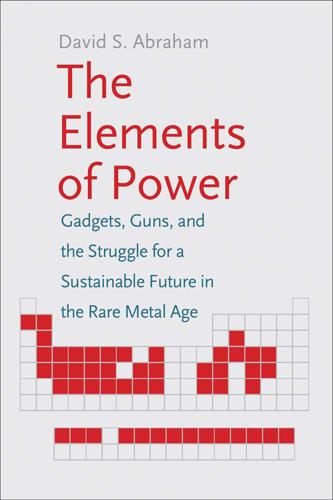
The Elements of Power: Gadgets, Guns, and the Struggle for a Sustainable Future in the Rare Metal Age
by
David S. Abraham
Published 27 Oct 2015
Japan responded quickly to China’s rare earth export ban in 2010, because Japan is the world’s largest rare earth import market because of its high-tech and heavy industries. Conversely, the current lack of high-tech manufacturing in the United States appears to act as insulation from China’s resource strength. This could change quickly. The United States is beginning to bring manufacturing back within its borders, or to “reshore.” Take Apple’s 2013 decision to begin producing computers at a Texas plant for the first time since 2004. Other companies such as General Electric and Caterpillar have followed suit. In fact, a Boston Consulting Group study in 2014 revealed that 16 percent of large companies are bringing manufacturing back to the United States, more than a doubling in two years.
…
See also names of individual elements Raytheon, 171 Reagan, Ronald, 30, 239n30 Reck, Barbara, 188, 189, 190, 191, 192 Recycling, 177, 184–92, 224, 285n34 Reeck, David, 141 REEs (rare earth elements), xi, 5, 61 Refining, steps in, 69–72 Reisman, Lisa, 110, 111 Renewable energy, 135, 136–37 Research, need for, 220–23 Reshoring, 212 Resource constraints, 205–8 Resource needs, x, 12 Resource security, 28–32, 203–5, 208–12, 228 Rhenium, 113, 114, 128–30, 132, 256n42 Rhodia (Solvay, metal processing firm), 70 Richard Hammen, 70 Richardson, Ed, 165–66 Rive, Lyndon, 148 Romans (ancient), 158 Roosevelt, Franklin Delano, 30, 238n28 Royal Philips Sonicare, 115 Rule of law, 200–201 Sagawa, Masato, 20–22, 25–28, 205, 229 Samarium, 20, 121 Samarium-cobalt magnets, 20, 22, 189–90 Santini, 235n2 Saudi Arabia, control of oil prices, 40 Savagian, Pete, 142, 143 ScanWind, 139 Schlumberger, 86 Screens: flat-screen technology, 122–24 LCD screens, 264n33 touch screens, 1, 261n19 Seafood, 208–9 “Sea of Death” (Dokai Bay, Japan), pollution in, 181 Search engine use, in China, 199 Secondary sources, rare metals recovery from, 79–80 Second China Rare Earth Summit, 194 Secrecy, xi–xii, 67, 68, 70, 87, 147, 160, 161, 196, 197, 268n17 Securing Materials for Emerging Technologies (American Physical Society & Material Research Society), 208, 211, 212–13 Selenium, 79, 149, 150, 190, 246n40 Semiconductors, 165 Senkaku Islands (Diaoyu Islands), territorial dispute over, 22–24 Senter, William, 156 Sesa-Opas (pseud., Indonesian social media user), 126, 127 Shanghai International Securities, 252–53n17 Shape memory, 221 Sheffi, Yossi, 112–13, 172 Sichuan Province, China, opposition to mining in, 49 Siemens, 139 Sillamäe, Estonia, refining in, 67–69 Silmet (Factory Number 7), 67–69, 72–76, 80–82 Silver, xiii, 4, 187, 190 Silver, Michael, 35, 139–40, 218 Simbol Materials, 211 Sinclair, Clive, 118, 119 Skyscrapers, molybdenum in, 162 Smartphones, 121, 216, 218, 260n15 Smith, John, 131–32 “Smoke Capital” (Osaka, Japan), pollution in, 181 Smuggling, 98, 203.
…
See Rare metals Teck Resources, 184 Teddy Ruxpin (talking teddy bear), 119 Telemarketing, indium sales via, 251n7 Tellurium, xiii, 78–79, 80, 148–50, 167, 190, 207, 209, 246n40 Tenent, Robert, 217 Teng Biao, 200 Teran, Alex, 147 Terbium, 2, 4, 151, 167, 174, 206, 229 Territorial disputes, China-Japan, 22–24 Tesla, 145–47 Texas Instruments, 117, 118 Thatcher, Margaret, 30 Thermal-imaging systems, 163–65 Thin film technologies, 148–49 Thorium, 3, 57, 176 Thor Lake mine (Avalon Rare Metal), 54–56 3D printing, 221 Tin, 48, 105–7, 108 Tiomin Resources, 46–48, 54 Titanium: in aerospace industry, 162, 263n30 in airplanes, 96, 128, 156–60, 168, 274n6 commoditization of, 221 market for, 44 in mobile phones, 121 nonmilitary use of, 121, 124, 146, 162–63, 221 shape memory, 221 sources of, 46, 93, 113 U.S. research on, 206 in weaponry, 163, 168, 169 “Titanium Goose” (A-12 spy plane, “Oxcart”), 155–57, 158–59 Titanium Metal Corporation, 156 Toothbrushes, 115–17, 258n3 Toothpaste, ancient use of, 257–58n1 Toronto Stock Exchange, 50 Toshiba, 112–13, 256n42 Touch screens, 261n19 Toyota Tsusho, 108 Toys, electronic, 119–20 Trade secrets, xi Trading networks, 89–114 China, rare metal exchanges in, 96–98 China, regulatory environment in, 98–101 conflict funding, 108–12 evading export controls, 104 export quotas/ban set by China, x, 24, 240n34 Indonesia, illegal trade in, 105–8 Lehrman family, 91–96 limited suppliers, problem of, 112–13 London Metal Exchange, 101–2 overview, 89–91 precariousness of, x price bubbles, 113–14 secrecy in, 16 smuggling, 102–5 Truman, Harry S., 30 Tungsten: Allied actions on, in WWII, 239n28 China, production in, 32, 205, 240n33, 289n16 conflict tungsten, 108, 109 Congo production, 108 export quota, 240n34 in glass, 217 importance, xi, 11 in lighting, 151 patents, 211 production locations, 48 shortage fears, 207, 219 sources of, 32, 48, 93, 108, 205, 240n24, 240n33, 289n16 wartime use of, 29, 30, 239n28 in weaponry, 29, 161–62, 167 Tunna, Nigel, 96 Twitter, 126 Uganda, cassiterites from, 111 Umicore, 191 UN Intergovernmental Panel on Climate Change, 135 United States: aluminum can recycling, 285n34 Bureau of Mines closure, 222 China, trade case against, 36 on China’s materials exports, 203 cobalt supplies, 19 commodity stockpiles, 291n36 conflict materials, actions on, 110–11 Japan, embargo against, 30 rare metal security strategy, 206, 208–12 reshoring, 212 tungsten, wartime actions on, 162, 239n28. See also Military (U.S.) Uranium, ix, 67–68, 164 Urban mining. See Recycling U.S. Chamber of Commerce, 288n11 U.S. Commercial Company, 238n28 U.S. Defense Department: rare metal stockpiles, 31. See also Military (U.S.) U.S. Department of Energy, 136–37, 138, 146, 207 U.S.
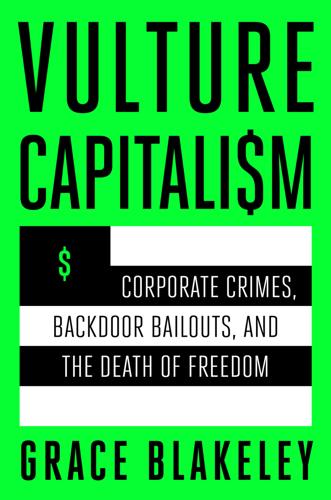
Vulture Capitalism: Corporate Crimes, Backdoor Bailouts, and the Death of Freedom
by
Grace Blakeley
Published 11 Mar 2024
These multinational corporations easily outcompete smaller ones operating in the Global South, using their power over the market to price-gouge their suppliers, forcing these smaller firms to cut costs by reducing wages and worsening working conditions.49 And they often also ally with powerful financial institutions to buy up any competitors that do emerge in order to consolidate their hold over the world market.50 Moreover, companies headquartered in the rich world can offshore production to poor countries, taking advantage of low labor costs and reshoring the profits to their home nation.51 Capitalist states make sure these inequalities persist by preventing people from moving around to find better-paying jobs, and by preventing states in the Global South from accessing resources and technology that would help them to industrialize. Together, these processes facilitate the generation of “super profits”—or “imperial rents”—for capitalists in the rich world, as well as stunting industrialization in the poor world and keeping these states in a position of dependency.52 The fusion of economics and politics is a critical part of this model and is something early liberal theorists missed.
…
But as dependency theorists like Prebisch would have predicted, these measures failed, deepening inequalities between rich and poor countries.154 Trade liberalization simply made it easier for predatory multinational corporations to enter the economies of the Global South and displace domestic capitalists before reshoring profits to the Global North. Meanwhile, domestic producers faced large barriers to exporting their goods on a global market weighted toward core countries, in part due to the protectionism of the rich world.155 Financial liberalization gave rise to immense financial instability, and austerity increased poverty and inequality.156 The plans also made it easier for elites to siphon their cash out of their countries into tax havens, undermining democracy.157 The financialization of the world economy “facilitated the outward flow of capital from developing countries.”158 One IMF economist later admitted that “everything we did from 1983 onward was based on our new sense of mission to have the south ‘privatized’ or die; toward this end we ignominiously created economic bedlam in Latin America and Africa.”159 For most of the world’s poorest states, the results were disastrous, especially in Nkrumah’s home in sub-Saharan Africa.160 The poor world did not have the productive base to withstand the overwhelming power of foreign capital.
…
Meanwhile, domestic producers faced large barriers to exporting their goods on a global market weighted toward core countries, in part due to the protectionism of the rich world.155 Financial liberalization gave rise to immense financial instability, and austerity increased poverty and inequality.156 The plans also made it easier for elites to siphon their cash out of their countries into tax havens, undermining democracy.157 The financialization of the world economy “facilitated the outward flow of capital from developing countries.”158 One IMF economist later admitted that “everything we did from 1983 onward was based on our new sense of mission to have the south ‘privatized’ or die; toward this end we ignominiously created economic bedlam in Latin America and Africa.”159 For most of the world’s poorest states, the results were disastrous, especially in Nkrumah’s home in sub-Saharan Africa.160 The poor world did not have the productive base to withstand the overwhelming power of foreign capital. Multinational corporations entered these countries, bought up national assets, and reshored profits back to the Global North. By 2004, per capita GDP across sub-Saharan Africa was less than half of what it was in 1974.161 As a result, the size of these nations’ debts only increased relative to their GDP. The programs also sharply increased inequality, as well as pushing millions of people further into poverty.162 In East Asia, in the wake of a financial crisis that had had devastating consequences for both economic and human development, structural adjustment added insult to injury.
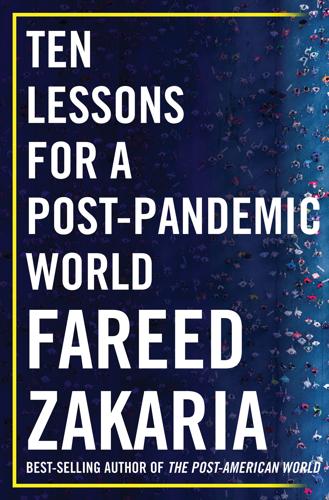
Ten Lessons for a Post-Pandemic World
by
Fareed Zakaria
Published 5 Oct 2020
With far fewer flights, the per-pound cost of transporting goods across the Pacific tripled. Seeking security, many governments—from the EU to Japan to India—announced their resolve to pursue greater self-sufficiency, or at least make the system of global supply chains more resilient. Even previously committed globalists suddenly began talking about “reshoring.” In a national address, French president Emmanuel Macron lamented his country’s “dependence on other continents,” and announced his new post-pandemic goal would be to achieve the “independence of France” in technology and industry. Weeks later, lifelong internationalist Joe Biden released a $400-billion “Buy American” plan.
…
For a few months, face masks were running desperately low worldwide, prompting many governments to ban exports of protective equipment. India did so, and over the following months, Indian manufacturers boosted production capacity of N95 masks to fifty-seven times their pre-pandemic level. By July, many places faced massive oversupply. In China, wholesale mask prices fell 90%. Instead of reshoring, the goal should be to create a kind of strategic medical reserve akin to the strategic petroleum reserve. The United States does have such a stockpile but it is limited and often neglected. Its medical supplies were never significantly replenished after the H1N1 outbreak in 2009. Many of the Asian countries that handled Covid-19 well had in fact created large reserves of crucial equipment, a lesson they learned from the SARS and MERS outbreaks.
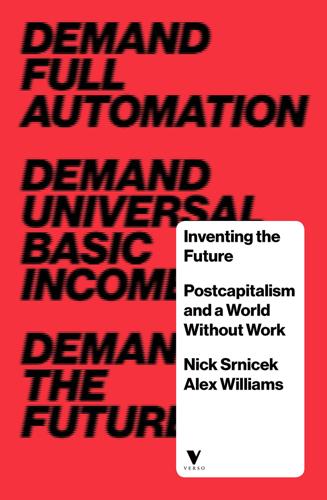
Inventing the Future: Postcapitalism and a World Without Work
by
Nick Srnicek
and
Alex Williams
Published 1 Oct 2015
Technological and economic developments now enable countries to virtually leapfrog the industrialisation phase, which means that developing economies are now deindustrialising at much lower rates of per capita income and with much lower shares of manufacturing employment.106 China is a good example of this, with manufacturing employment in decline,107 labour struggles becoming more confident,108 real wages surging109 and demographic limits leading to a focus on ‘technological upgrading [and] productivity enhancements’ in order to maintain growth.110 The automation of factories is at the leading edge of this deindustrialisation trend, with China already the biggest purchaser of industrial robots, and expected to soon have more industrial robots in operation than either Europe or North America.111 The factory of the world is going robotic. Deindustrialisation can also be seen in ‘reshoring’, where manufacturing returns to developed economies in jobless, automated forms.112 These deindustrialisation trends are taking hold across the developing economies of Latin America, sub-Saharan Africa and most of Asia.113 Even in countries where manufacturing employment has increased in absolute terms, there have been significant decreases in the labour-intensity of the process.114 The result of all of this is not only an incomplete transition to a significant working class, but also the stymying of the expected employment path for the workforce.
…
ILO, Global Wage Report 2012/13: Wages and Equitable Growth (Geneva: International Labour Organization, 2013), pdf available at ilo.org, p. 20. 110.ILO, Global Employment Trends 2014, p. 29. 111.International Federation of Robotics, World Robotics: Industrial Robots 2014 (Frankfurt: International Federation of Robotics, 2014), pdf available at worldrobotics.org, p. 19; Lee Chyen Yee and Clare Jim, ‘Foxconn to Rely More on Robots; Could Use 1 Million in 3 Years’, Reuters, 1 August 2011; ‘Guangzhou Spurs Robot Use amid Rising Labor Costs’, China Daily, 16 April 2014, at chinadaily.com.cn; Angelo Young, ‘Nike Unloads Contract Factory Workers, Showing How Automation Is Costing Jobs of Vulnerable Emerging Market Laborers’, International Business Times, 20 May 2014. 112.Majority of Large Manufacturers Are Now Planning or Considering ‘Reshoring’ from China to the US, Boston Consulting Group, 24 September 2013, at bcg.com; Stephanie Clifford, ‘US Textile Plants Return, with Floors Largely Empty of People’, New York Times, 19 September 2013. 113.Dani Rodrik, Premature Deindustrialization, BREAD Working Paper No. 439, Bureau for Research and Economic Analysis of Development, 2015, at ipl.econ.duke.edu, p. 2. 114.Fiona Tregenna, Manufacturing Productivity, Deindustrialization, and Reindustrialization, World Institute for Development Economics Research, 2011, at econstor.eu, p. 11. 115.Out of a labour force of 481 million, approximately 1 million work in this sector.
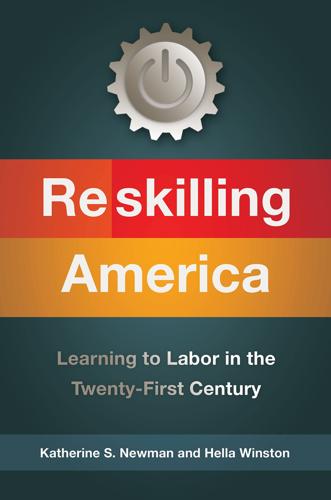
Reskilling America: Learning to Labor in the Twenty-First Century
by
Katherine S. Newman
and
Hella Winston
Published 18 Apr 2016
Looking out over the vast expanse of a modern steel mill, there are hardly any people on the shop floor at all. Automation has replaced human workers with preprogrammed machines that can operate twenty-four hours a day without getting tired, at levels of precision that are far superior to what line workers once produced. As a consequence, the re-shoring of manufacturing is not likely to produce millions of jobs. Ninety-four thousand people working in the steel industry in 2012 produced 14 percent more steel than nearly four hundred thousand workers did in 1980.11 And as manufacturing comes back to the Rust Belt states, the employees it does need will be different from the ones it turfed out in the off-shoring era.
…
Jeffrey Goldberg, “A Matter of Black Lives,” Atlantic, September 2015, http://www.theatlantic.com/magazine/archive/2015/09/a-matter-of-black-lives/399386/. Introduction 1. Andrea Cheng, “Record Number of Manufacturing Jobs Returning to the US,” Marketwatch, May 1, 2015, http://www.marketwatch.com/story/us-flips-the-script-on-jobs-reshoring-finally-outpaced-offshoring-in-2014-2015-05-01. 2. Megan Woolhouse, “Some Offshored Manufacturing Jobs Return to US,” Boston Globe, July 26, 2015. 3. Harold L. Sirkin, Michael Zinser, and Douglas Hohner, “Made in America, Again: Why Manufacturing Will Return to the U.S.,” Boston Consulting Group (August 2011), https://www.bcg.com/documents/file84471.pdf. 4.

Frugal Innovation: How to Do Better With Less
by
Jaideep Prabhu Navi Radjou
Published 15 Feb 2015
These inventory costs can add billions of dollars in multi-tiered industry value chains such as automotive and electronics. Together, these two obstacles can be called the “value gap”, and they prevent firms from meeting demand faster, better and cheaper. Some firms, however, have been able to bridge the value gap in the following ways. Reshoring After several decades of unbridled offshoring to low-cost destinations from China to Mexico, manufacturing is now returning to the developed world, as a way to cut costs. Much of the savings involve a product’s physical distribution. The 20th-century industrial model worked only as long as cheap labour and economies of scale outweighed shipping costs.
…
MacArthur Foundation 14 John Deere 67 John Lewis 195 Johnson & Johnson 100, 111 Johnson, Warren 98 Jones, Don 112 jugaad (frugal ingenuity) 199, 202 Jugaad Innovation (Radjou, Prabhu and Ahuja, 2012) xvii, 17 just-in-time design 33–4 K Kaeser, Joe 217 Kalanick, Travis 163 Kalundborg (Denmark) 160 kanju 201 Karkal, Shamir 124 Kaufman, Ben 50–1, 126 Kawai, Daisuke 29–30 Kelly, John 199–200 Kennedy, President John 138 Kenya 57, 200–1 key performance indicators see KPIs Khan Academy 16–17, 113–14, 164 Khan, Salman (Sal) 16–17, 113–14 Kickstarter 17, 48, 137, 138 KieranTimberlake 196 Kimberly-Clark 25, 145 Kingfisher 86–7, 91, 97, 157, 158–9, 185–6, 192–3, 208 KissKissBankBank 17, 137 Knox, Steve 145 Knudstorp, Jørgen Vig 37, 68, 69 Kobori, Michael 83, 100 KPIs (key performance indicators) 38–9, 67, 91–2, 185–6, 208 Kuhndt, Michael 194 Kurniawan, Arie 151–2 L La Chose 108 La Poste 92–3, 157 La Ruche qui dit Oui 137 “labs on a chip” 52 Lacheret, Yves 173–5 Lada 1 laser cutters 134, 166 Laskey, Alex 119 last-mile challenge 57, 146, 156 L’Atelier 168–9 Latin America 161 lattice organisation 63–4 Laury, Véronique 208 Laville, Elisabeth 91 Lawrence, Jamie 185, 192–3, 208 LCA (life-cycle assessment) 196–7 leaders 179, 203–5, 214, 217 lean manufacturing 192 leanness 33–4, 41, 42, 170, 192 Learnbox 114 learning by doing 173, 179 learning organisations 179 leasing 123 Lee, Deishin 159 Lego 51, 126 Lego Group 37, 68, 69, 144 Legrand 157 Lenovo 56 Leroy, Adolphe 127 Leroy Merlin 127–8 Leslie, Garthen 150–1 Lever, William Hesketh 96 Levi Strauss & Co 60, 82–4, 100, 122–3 Lewis, Dijuana 212 life cycle of buildings 196 see also product life cycle life-cycle assessment (LCA) 196–7 life-cycle costs 12, 24, 196 Lifebuoy soap 95, 97 lifespan of companies 154 lighting 32, 56, 123, 201 “lightweighting” 47 linear development cycles 21, 23 linear model of production 80–1 Link 131 littleBits 51 Livi, Daniele 88 Livi, Vittorio 88 local communities 52, 57, 146, 206–7 local markets 183–4 Local Motors 52, 129, 152 local solutions 188, 201–2 local sourcing 51–2, 56, 137, 174, 181 localisation 56, 137 Locavesting (Cortese, 2011) 138 Logan car 2–3, 12, 179, 198–9 logistics 46, 57–8, 161, 191, 207 longevity 121, 124 Lopez, Maribel 65–6 Lopez Research 65–6 L’Oréal 174 Los Alamos National Laboratory 170 low-cost airlines 60, 121 low-cost innovation 11 low-income markets 12–13, 161, 203, 207 Lowry, Adam 81–2 M m-health 109, 111–12 M-KOPA 201 M-Pesa 57, 201 M3D 48, 132 McDonough Braungart Design Chemistry (MBDC) 84 McDonough, William 82 McGregor, Douglas 63 MacGyvers 17–18, 130, 134, 167 McKelvey, Jim 135 McKinsey & Company 81, 87, 209 mainstream, frugal products in 216 maintenance 66, 75, 76, 124, 187 costs 48–9, 66 Mainwaring, Simon 8 Maistre, Christophe de 187–8, 216 Maker Faire 18, 133–4 Maker platform 70 makers 18, 133–4, 145 manufacturing 20th-century model 46, 55, 80–1 additive 47–9 continuous 44–5 costs 47, 48, 52 decentralised 9, 44, 51–2 frugal 44–54 integration with logistics 57–8 new approaches 50–4 social 50–1 subtractive method 48 tools for 47, 47–50 Margarine Unie 96 market 15, 28, 38, 64, 186, 189, 192 R&D and 21, 26, 33, 34 market research 25, 61, 139, 141 market share 100 marketing 21–2, 24, 36, 61–3, 91, 116–20, 131, 139 and R&D 34, 37, 37–8 marketing teams 143, 150 markets 12–13, 42, 62, 215 see also emerging markets Marks & Spencer (M&S) 97, 215 Plan A 90, 156, 179–81, 183–4, 186–7, 214 Marriott 140 Mars 57, 158–9, 161 Martin Marietta 159 Martin, Tod 154 mass customisation 9, 46, 47, 48, 57–8 mass market 189 mass marketing 21–2 mass production 9, 46, 57, 58, 74, 129, 196 Massachusetts Institute of Technology see MIT massive open online courses see MOOCs materials 3, 47, 48, 73, 92, 161 costs 153, 161, 190 recyclable 74, 81, 196 recycled 77, 81–2, 83, 86, 89, 183, 193 renewable 77, 86 repurposing 93 see also C2C; reuse Mayhew, Stephen 35, 36 Mazoyer, Eric 90 Mazzella, Frédéric 163 MBDC (McDonough Braungart Design Chemistry) 84 MDI 16 measurable goals 185–6 Mechanical Engineer Laboratory (MEL) 52 “MEcosystems” 154–5, 156–8 Medicare 110 medication 111–12 Medicity 211 MedStartr 17 MEL (Mechanical Engineer Laboratory) 52 mental models 2, 193–203, 206, 216 Mercure 173 Merlin, Rose 127 Mestrallet, Gérard 53, 54 method (company) 81–2 Mexico 38, 56 Michelin 160 micro-factories 51–2, 52, 66, 129, 152 micro-robots 52 Microsoft 38 Microsoft Kinect 130 Microsoft Word 24 middle classes 197–8, 216 Migicovsky, Eric 137–8 Mikkiche, Karim 199 millennials 7, 14, 17, 131–2, 137, 141, 142 MindCET 165 miniaturisation 52, 53–4 Mint.com 125 MIT (Massachusetts Institute of Technology) 44–5, 107, 130, 134, 202 mobile health see m-health mobile phones 24, 32, 61, 129–30, 130, 168, 174 emerging market use 198 infrastructure 56, 198 see also smartphones mobile production units 66–7 mobile technologies 16, 17, 103, 133, 174, 200–1, 207 Mocana 151 Mochon, Daniel 132 modular design 67, 90 modular production units 66–7 Modularer Querbaukasten see MQB “mompreneurs” 145 Mondelez 158–9 Money Dashboard 125 Moneythink 162 monitoring 65–6, 106, 131 Monopoly 144 MOOCs (massive open online courses) 60, 61, 112, 113, 114, 164 Morieux, Yves 64 Morocco 207 Morris, Robert 199–200 motivation, employees 178, 180, 186, 192, 205–8 motivational approaches to shaping consumer behaviour 105–6 Motorola 56 MQB (Modularer Querbaukasten) 44, 45–6 Mulally, Alan 70, 166 Mulcahy, Simon 157 Mulliez family 126–7 Mulliez, Vianney 13, 126 multi-nodal innovation 202–3 Munari, Bruno 93 Murray, Mike 48–9 Musk, Elon 172 N Nano car 119, 156 National Geographic 102 natural capital, loss of 158–9 Natural Capital Leaders Platform 158–9 natural resources 45, 86 depletion 7, 72, 105, 153, 158–9 see also resources NCR 55–6 near-shoring 55 Nelson, Simon 113 Nemo, Sophie-Noëlle 93 Nest Labs 98–100, 103 Nestlé 31, 44, 68, 78, 94, 158–9, 194, 195 NetPositive plan 86, 208 networking 152–3, 153 new materials 47, 92 New Matter 132 new technologies 21, 27 Newtopia 32 next-generation customers 121–2 next-generation manufacturing techniques 44–6, 46–7 see also frugal manufacturing Nigeria 152, 197–8 Nike 84 NineSigma 151 Nissan 4, 4–5, 44, 199 see also Renault-Nissan non-governmental organisations 167 non-profit organisations 161, 162, 202 Nooyi, Indra 217 Norman, Donald 120 Norris, Greg 196 North American companies 216–17 North American market 22 Northrup Grumman 68 Norton, Michael 132 Norway 103 Novartis 44–5, 215 Novotel 173, 174 nudging 100, 108, 111, 117, 162 Nussbaum, Bruce 140 O O2 147 Obama, President Barack 6, 8, 13, 134, 138, 208 obsolescence, planned 24, 121 offshoring 55 Oh, Amy 145 Ohayon, Elie 71–2 Oliver Wyman 22 Olocco, Gregory 206 O’Marah, Kevin 58 on-demand services 39, 124 online communities 31, 50, 61, 134 online marketing 143 online retailing 60, 132 onshoring 55 Opel 4 open innovation 104, 151, 152, 153, 154 open-source approach 48, 129, 134, 135, 172 open-source hardware 51, 52, 89, 130, 135, 139 open-source software 48, 130, 132, 144–5, 167 OpenIDEO 142 operating costs 45, 215 Opower 103, 109, 119 Orange 157 Orbitz 173 organisational change 36–7, 90–1, 176, 177–90, 203–8, 213–14, 216 business models 190–3 mental models 193–203 organisational culture 36–7, 170, 176, 177–9, 213–14, 217 efficacy focus 181–3 entrepreneurial 76, 173 see also organisational change organisational structure 63–5, 69 outsourcing 59, 143, 146 over-engineering 27, 42, 170 Overby, Christine 25 ownership 9 Oxylane Group 127 P P&G (Procter & Gamble) 19, 31, 58, 94, 117, 123, 145, 195 packaging 57, 96, 195 Page, Larry 63 “pain points” 29, 30, 31 Palmer, Michael 212 Palo Alto Junior League 20 ParkatmyHouse 17, 63, 85 Parker, Philip 61 participation, customers 128–9 partner ecosystems 153, 154, 200 partners 65, 72, 148, 153, 156–8 sharing data with 59–60 see also distributors; hyper-collaboration; suppliers Partners in Care Foundation 202 partnerships 41, 42, 152–3, 156–7, 171–2, 174, 191 with SMBs 173, 174, 175 with start-ups 20, 164–5, 175 with suppliers 192–3 see also hyper-collaboration patents 171–2 Payne, Alex 124 PE International 196 Pearson 164–5, 167, 181–3, 186, 215 Pebble 137–8 peer-to-peer economic model 10 peer-to-peer lending 10 peer-to-peer sales 60 peer-to-peer sharing 136–7 Pélisson, Gérard 172–3 PepsiCo 38, 40, 179, 190, 194, 215 performance 47, 73, 77, 80, 95 of employees 69 Pernod Ricard 157 personalisation 9, 45, 46, 48, 62, 129–30, 132, 149 Peters, Tom 21 pharmaceutical industry 13, 22, 23, 33, 58, 171, 181 continuous manufacturing 44–6 see also GSK Philippines 191 Philips 56, 84, 100, 123 Philips Lighting 32 Picaud, Philippe 122 Piggy Mojo 119 piggybacking 57 Piketty, Thomas 6 Plan A (M&S) 90, 156, 179–81, 183–4, 186–7, 214 Planet 21 (Accor) 174–5 planned obsolescence 24, 121 Plastyc 17 Plumridge, Rupert 18 point-of-sale data 58 Poland 103 pollution 74, 78, 87, 116, 187, 200 Polman, Paul 11, 72, 77, 94, 203–5, 217 portfolio management tools 27, 33 Portugal 55, 103 postponement 57–8 Potočnik, Janez 8, 79 Prabhu, Arun 25 Prahalad, C.K. 12 predictive analytics 32–3 predictive maintenance 66, 67–8 Priceline 173 pricing 81, 117 processes digitising 65–6 entrenched 14–16 re-engineering 74 simplifying 169, 173 Procter & Gamble see P&G procurement priorities 67–8 product life cycle 21, 75, 92, 186 costs 12, 24, 196 sustainability 73–5 product-sharing initiatives 87 production costs 9, 83 productivity 49, 59, 65, 79–80, 153 staff 14 profit 14, 105 Progressive 100, 116 Project Ara 130 promotion 61–3 Propeller Health 111 prosumers xix–xx, 17–18, 125, 126–33, 136–7, 148, 154 empowering and engaging 139–46 see also horizontal economy Protomax 159 prototypes 31–2, 50, 144, 152 prototyping 42, 52, 65, 152, 167, 192, 206 public 50–1, 215 public sector, working with 161–2 publishers 17, 61 Pullman 173 Puma 194 purchasing power 5–6, 216 pyramidal model of production 51 pyramidal organisations 69 Q Qarnot Computing 89 Qualcomm 84 Qualcomm Life 112 quality 3, 11–12, 15, 24, 45, 49, 82, 206, 216 high 1, 9, 93, 198, 216 measure of 105 versus quantity 8, 23 quality of life 8, 204 Quicken 19–21 Quirky 50–1, 126, 150–1, 152 R R&D 35, 67, 92, 151 big-ticket programmes 35–6 and business development 37–8 China 40, 188, 206 customer focus 27, 39, 43 frugal approach 12, 26–33, 82 global networks 39–40 incentives 38–9 industrial model 2, 21–6, 33, 36, 42 market-focused, agile model 26–33 and marketing 34, 37, 37–8 recommendations for managers 34–41 speed 23, 27, 34, 149 spending 15, 22, 23, 28, 141, 149, 152, 171, 187 technology culture 14–15, 38–9 see also Air Liquide; Ford; GSK; IBM; immersion; Renault; SNCF; Tarkett; Unilever R&D labs 9, 21–6, 70, 149, 218 in emerging markets 40, 188, 200 R&D teams 26, 34, 38–9, 65, 127, 150, 194–5 hackers as 142 innovation brokering 168 shaping customer behaviour 120–2 Raspberry Pi 135–6, 164 Ratti, Carlo 107 raw materials see materials real-time demand signals 58, 59 Rebours, Christophe 157–8 recession 5–6, 6, 46, 131, 180 Reckitt Benckiser 102 recommendations for managers flexing assets 65–71 R&D 34–41 shaping consumer behaviour 116–24 sustainability 90–3 recruiting 70–1 recyclable materials 74, 81, 196 recyclable products 3, 73, 159, 195–6 recycled materials 77, 81–2, 83, 86, 89, 183, 193 recycling 8, 9, 87, 93, 142, 159 e-waste 87–8 electronic and electrical goods (EU) 8, 79 by Tarkett 73–7 water 83, 175 see also C2C; circular economy Recy’Go 92–3 regional champions 182 regulation 7–8, 13, 78–9, 103, 216 Reich, Joshua 124 RelayRides 17 Renault 1–5, 12, 117, 156–7, 179 Renault-Nissan 4–5, 40, 198–9, 215 renewable energy 8, 53, 74, 86, 91, 136, 142, 196 renewable materials 77, 86 Replicator 132 repurposing 93 Requardt, Hermann 189 reshoring 55–6 resource constraints 4–5, 217 resource efficiency 7–8, 46, 47–9, 79, 190 Resource Revolution (Heck, Rogers and Carroll, 2014) 87–8 resources 40, 42, 73, 86, 197, 199 consumption 9, 26, 73–7, 101–2 costs 78, 203 depletion 7, 72, 105, 153, 158–9 reducing use 45, 52, 65, 73–7, 104, 199, 203 saving 72, 77, 200 scarcity 22, 46, 72, 73, 77–8, 80, 158–9, 190, 203 sharing 56–7, 159–61, 167 substitution 92 wasting 169–70 retailers 56, 129, 214 “big-box” 9, 18, 137 Rethink Robotics 49 return on investment 22, 197 reuse 9, 73, 76–7, 81, 84–5, 92–3, 200 see also C2C revenues, generating 77, 167, 180 reverse innovation 202–3 rewards 37, 178, 208 Riboud, Franck 66, 184, 217 Rifkin, Jeremy 9–10 robots 47, 49–50, 70, 144–5, 150 Rock Health 151 Rogers, Jay 129 Rogers, Matt 87–8 Romania 2–3, 103 rookie mindset 164, 168 Rose, Stuart 179–80, 180 Roulin, Anne 195 Ryan, Eric 81–2 Ryanair 60 S S-Oil 106 SaaS (software as a service) 60 Saatchi & Saatchi 70–1 Saatchi & Saatchi + Duke 71–2, 143 sales function 15, 21, 25–6, 36, 116–18, 146 Salesforce.com 157 Santi, Paolo 108 SAP 59, 186 Saunders, Charles 211 savings 115 Sawa Orchards 29–31 Scandinavian countries 6–7 see also Norway Schmidt, Eric 136 Schneider Electric 150 Schulman, Dan 161–2 Schumacher, E.F. 104–5, 105 Schweitzer, Louis 1, 2, 3, 4, 179 SCM (supply chain management) systems 59 SCOR (supply chain operations reference) model 67 Seattle 107 SEB 157 self-sufficiency 8 selling less 123–4 senior managers 122–4, 199 see also CEOs; organisational change sensors 65–6, 106, 118, 135, 201 services 9, 41–3, 67–8, 124, 149 frugal 60–3, 216 value-added 62–3, 76, 150, 206, 209 Shapeways 51, 132 shareholders 14, 15, 76, 123–4, 180, 204–5 sharing 9–10, 193 assets 159–61, 167 customers 156–8 ideas 63–4 intellectual assets 171–2 knowledge 153 peer-to-peer 136–9 resources 56–7, 159–61, 167 sharing economy 9–10, 17, 57, 77, 80, 84–7, 108, 124 peer-to-peer sharing 136–9 sharing between companies 159–60 shipping costs 55, 59 shopping experience 121–2 SIEH hotel group 172–3 Siemens 117–18, 150, 187–9, 215, 216 Sigismondi, Pier Luigi 100 Silicon Valley 42, 98, 109, 150, 151, 162, 175 silos, breaking out of 36–7 Simple Bank 124–5 simplicity 8, 41, 64–5, 170, 194 Singapore 175 Six Sigma 11 Skillshare 85 SkyPlus 62 Small is Beautiful (Schumacher, 1973) 104–5 “small is beautiful” values 8 small and medium-sized businesses see SMBs Smart + Connected Communities 29 SMART car 119–20 SMART strategy (Siemens) 188–9 smartphones 17, 100, 106, 118, 130, 131, 135, 198 in health care 110, 111 see also apps SmartScan 29 SMBs (small and medium-sized businesses) 173, 174, 175, 176 SMS-based systems 42–3 SnapShot 116 SNCF 41–3, 156–7, 167 SoapBox 28–9 social business model 206–7 social comparison 109 social development 14 social goals 94 social learning 113 social manufacturing 47, 50–1 social media 16, 71, 85, 106, 108, 168, 174 for marketing 61, 62, 143 mining 29, 58 social pressure of 119 tools 109, 141 and transaction costs 133 see also Facebook; social networks; Twitter social networks 29, 71, 72, 132–3, 145, 146 see also Facebook; Twitter social pressure 119 social problems 82, 101–2, 141, 142, 153, 161–2, 204 social responsibility 7, 10, 14, 141, 142, 197, 204 corporate 77, 82, 94, 161 social sector, working with 161–2 “social tinkerers” 134–5 socialising education 112–14 Sofitel 173 software 72 software as a service (SaaS) 60 solar power 136, 201 sourcing, local 51–2, 56 Southwest Airlines 60 Spain 5, 6, 103 Spark 48 speed dating 175, 176 spending, on R&D 15, 22, 23, 28, 141, 149, 152, 171, 187 spiral economy 77, 87–90 SRI International 49, 52 staff see employees Stampanato, Gary 55 standards 78, 196 Starbucks 7, 140 start-ups 16–17, 40–1, 61, 89, 110, 145, 148, 150, 169, 216 investing in 137–8, 157 as partners 42, 72, 153, 175, 191, 206 see also Nest Labs; Silicon Valley Statoil 160 Steelcase 142 Stem 151 Stepner, Diana 165 Stewart, Emma 196–7 Stewart, Osamuyimen 201–2 Sto Corp 84 Stora Enso 195 storytelling 112, 113 Strategy& see Booz & Company Subramanian, Prabhu 114 substitution of resources 92 subtractive manufacturing 48 Sun Tzu 158 suppliers 67–8, 83, 148, 153, 167, 176, 192–3 collaboration with 76, 155–6 sharing with 59–60, 91 visibility 59–60 supply chain management see SCM supply chain operations reference (SCOR) model 67 supply chains 34, 36, 54, 65, 107, 137, 192–3 carbon footprint 156 costs 58, 84 decentralisation 66–7 frugal 54–60 integrating 161 small-circuit 137 sustainability 137 visibility 34, 59–60 support 135, 152 sustainability xix, 9, 12, 72, 77–80, 82, 97, 186 certification 84 as competitive advantage 80 consumers and 95, 97, 101–4 core design principle 82–4, 93, 195–6 and growth 76, 80, 104–5 perceptions of 15–16, 80, 91 recommendations for managers 90–3 regulatory demand for 78–9, 216 standard bearers of 80, 97, 215 see also Accor; circular economy; Kingfisher; Marks & Spencer; Tarkett; Unilever sustainable design 82–4 see also C2C sustainable distribution 57, 161 sustainable growth 72, 76–7 sustainable lifestyles 107–8 Sustainable Living Plan (Unilever) 94–7, 179, 203–4 sustainable manufacturing 9, 52 T “T-shaped” employees 70–1 take-back programmes 9, 75, 77, 78 Tally 196–7 Tarkett 73–7, 80, 84 TaskRabbit 85 Tata Motors 16, 119 Taylor, Frederick 71 technical design 37–8 technical support, by customers 146 technology 2, 14–15, 21–2, 26, 27 TechShop 9, 70, 134–5, 152, 166–7 telecoms sector 53, 56 Telefónica 147 telematic monitoring 116 Ternois, Laurence 42 Tesco 102 Tesla Motors 92, 172 testing 28, 42, 141, 170, 192 Texas Industries 159 Textoris, Vincent 127 TGV Lab 42–3 thermostats 98–100 thinking, entrenched 14–16 Thompson, Gav 147 Timberland 90 time 4, 7, 11, 41, 72, 129, 170, 200 constraints 36, 42 see also development cycle tinkerers 17–18, 133–5, 144, 150, 152, 153, 165–7, 168 TiVo 62 Tohamy, Noha 59–60 top-down change 177–8 top-down management 69 Total 157 total quality management (TQM) 11 total volatile organic compounds see TVOC Toyota 44, 100 Toyota Sweden 106–7 TQM (total quality management) 11 traffic 108, 116, 201 training 76, 93, 152, 167, 170, 189 transaction costs 133 transparency 178, 185 transport 46, 57, 96, 156–7 Transport for London 195 TrashTrack 107 Travelocity 174 trial and error 173, 179 Trout, Bernhardt 45 trust 7, 37, 143 TVOC (total volatile organic compounds) 74, 77 Twitter 29, 62, 135, 143, 147 U Uber 136, 163 Ubuntu 202 Uchiyama, Shunichi 50 UCLA Health 202–3 Udacity 61, 112 UK 194 budget cuts 6 consumer empowerment 103 industrial symbiosis 160 savings 115 sharing 85, 138 “un-management” 63–4, 64 Unboundary 154 Unilever 11, 31, 57, 97, 100, 142, 203–5, 215 and sustainability 94–7, 104, 179, 203–4 University of Cambridge Engineering Design Centre (EDC) 194–5 Inclusive Design team 31 Institute for Sustainability Leadership (CISL) 158–9 upcycling 77, 88–9, 93, 159 upselling 189 Upton, Eben 135–6 US 8, 38, 44, 87, 115, 133, 188 access to financial services 13, 17, 161–2 ageing population 194 ageing workforce 13 commuting 131 consumer spending 5, 6, 103 crowdfunding 137–8, 138 economic pressures 5, 6 energy use 103, 119, 196 environmental awareness 7, 102 frugal innovation in 215–16, 218 health care 13, 110, 208–13, 213 intellectual property 171 onshoring 55 regulation 8, 78, 216 sharing 85, 138–9 shifting production from China to 55, 56 tinkering culture 18, 133–4 user communities 62, 89 user interfaces 98, 99 user-friendliness 194 Utopies 91 V validators 144 value 11, 132, 177, 186, 189–90 aspirational 88–9 to customers 6–7, 21, 77, 87, 131, 203 from employees 217 shareholder value 14 value chains 9, 80, 128–9, 143, 159–60, 190, 215 value engineering 192 “value gap” 54–5 value-added services 62–3, 76, 150, 206, 209 values 6–7, 14, 178, 205 Vandebroek, Sophie 169 Vasanthakumar, Vaithegi 182–3 Vats, Tanmaya 190, 192 vehicle fleets, sharing 57, 161 Verbaken, Joop 118 vertical integration 133, 154 virtual prototyping 65 virtuous cycle 212–13 visibility 34, 59–60 visible learning 112–13 visioning sessions 193–4 visualisation 106–8 Vitality 111 Volac 158–9 Volkswagen 4, 44, 45–6, 129, 144 Volvo 62 W wage costs 48 wages, in emerging markets 55 Waitrose, local suppliers 56 Walker, James 87 walking the walk 122–3 Waller, Sam 195 Walmart 9, 18, 56, 162, 216 Walton, Sam 9 Wan Jia 144 Washington DC 123 waste 24, 87–9, 107, 159–60, 175, 192, 196 beautifying 88–9, 93 e-waste 24, 79, 87–8, 121 of energy 119 post-consumer 9, 75, 77, 78, 83 reducing 47, 74, 85, 96, 180, 209 of resources 169–70 in US health-care system 209 see also C2C; recycling; reuse water 78, 83, 104, 106, 158, 175, 188, 206 water consumption 79, 82–3, 100, 196 reducing 74, 75, 79, 104, 122–3, 174, 183 wealth 105, 218 Wear It Share It (Wishi) 85 Weijmarshausen, Peter 51 well-being 104–5 Wham-O 56 Whirlpool 36 “wicked” problems 153 wireless technologies 65–6 Wiseman, Liz 164 Wishi (Wear It Share It) 85 Witty, Andrew 35, 35–6, 37, 39, 217 W.L.
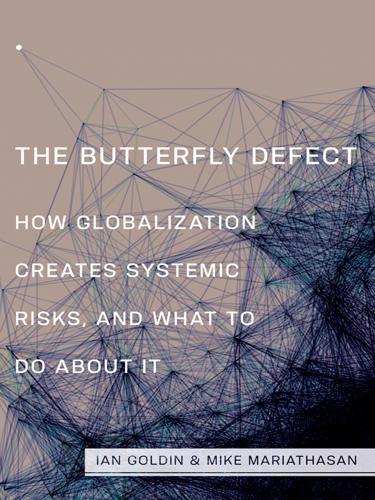
The Butterfly Defect: How Globalization Creates Systemic Risks, and What to Do About It
by
Ian Goldin
and
Mike Mariathasan
Published 15 Mar 2014
Hubert Escaith, Nannette Lindenberg, and Sébastien Miroudot, 2010, “International Supply Chains and Trade Elasticity in Times of Global Crisis,” Staff Working Paper ESRD-2010-08, Economics and Statistics Division, World Trade Organization, accessed 1 February 2013, http://www.wto.org/english/res_e/reser_e/ersd201008_e.pdf. 40. EEF (The Manufacturers’ Organisation, UK), 2011, “Industry Looks to Reshore Production in Response to Supply Risks,” The Manufacturers’ Organization, accessed 31 January 2013, http://www.eef.org.uk/releases/uk/2011/Industry-looks-to-re-shore-production-in-response-to-supply-risks-.htm. The EEF was formerly known as the Engineering Employers’ Federation and is still referred to as EEF in spite of the name change. 41.
…
“The Greek Election: Democracy in Action.” 2 June. Accessed 28 January 2013. http://www.economist.com/node/21556302. ———. 2012d. “Wall Street Bonuses.” 3 March. Accessed 4 February 2013. http://www.economist.com/node/21548981. EEF (The Manufacturers’ Organisation, UK). 2011. “Industry Looks to Re-shore Production in Response to Supply Risks.” The Manufacturers’ Organization. Accessed 31 January 2013. http://www.eef.org.uk/releases/uk/2011/Industry-looks-to-re-shore-production-in-response-to-supply-risks-.htm. EIA (Energy Information Administration). 2008. “U.S. Natural Gas Pipeline Compressor Stations Illustration.”
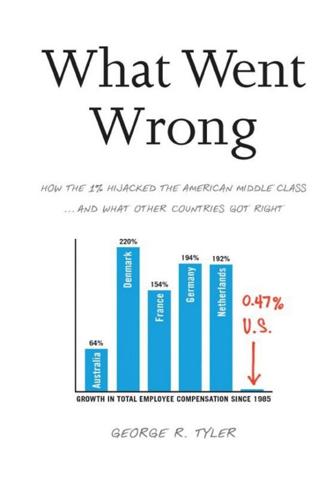
What Went Wrong: How the 1% Hijacked the American Middle Class . . . And What Other Countries Got Right
by
George R. Tyler
Published 15 Jul 2013
During the recent recession, manufacturing employment fell nearly 29 percent through October 2009, over five-fold faster than the pace of job loss across all sectors.31 Once such jobs are gone, as economist Nancy Folbre explained earlier, firms have mostly proven loathe to recreate high-value manufacturing jobs at home, and thus the losses become permanent. Any new jobs are low-wage ones in today’s two-tier manufacturing pay structure. Higher wages in China are encouraging some reshoring now, with Boston Consulting touting a survey a year or so ago that larger multinationals are reexamining domestic US manufacturing. And, the Economist examined this encouraging trend in a special report in January 2013. As an aside, it importantly noted that the trend of “Reshoring is largely an American phenomenon,” because relatively little offshoring is undertaken by European firms.32 Intriguingly, Google’s Nexus Q product is being manufactured in Silicon Valley as in the days of yore (the 1970s), and even Apple may return some jobs to the United States.33 Ideally, these dribs and drabs will become a torrent.
…
As an aside, it importantly noted that the trend of “Reshoring is largely an American phenomenon,” because relatively little offshoring is undertaken by European firms.32 Intriguingly, Google’s Nexus Q product is being manufactured in Silicon Valley as in the days of yore (the 1970s), and even Apple may return some jobs to the United States.33 Ideally, these dribs and drabs will become a torrent. Even then, a huge problem would remain: there is no evidence that reshoring boosts wages in the manufacturing sector. Lost Multiplier Impacts Manufacturing jobs are coveted as the heart of a robust economy because they are more productive and better paying than most other jobs. But they are also particularly valuable because they have a direct multiplier impact on job creation, sustaining a number of jobs in affiliated industries.
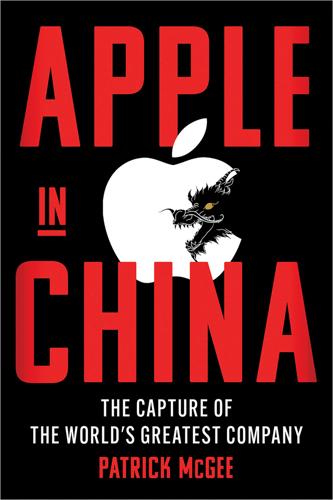
Apple in China: The Capture of the World's Greatest Company
by
Patrick McGee
Published 13 May 2025
nickname “White Guards”: Rita Cheng, Qiao Long, and Chingman for RFA Mandarin, “China’s ‘White Guards’ Gain Reputation for Brutal Enforcement of Shanghai Lockdown,” Radio Free Asia, May 29, 2022, https://www.rfa.org/english/news/china/shanghai-whiteguards-05292022070418.html. reduced Apple revenue by $30 billion: Krish Sankar et al., “The Apple Supply Chain’s Great Reshoring,” TD Cowen, January 4, 2024. Ma critiqued Beijing governance: James Kynge, Henry Sender, and Sun Yu, “ ‘The Party Is Pushing Back’: Why Beijing Reined in Jack Ma and Ant,” Financial Times, November 4, 2020, https://www.ft.com/content/3d2f174d-aa73-44fc-8c90-45c2a554e97b. wrote two China scholars: Christopher Marquis and Kunyuan Qiao, Mao and Markets: The Communist Roots of Chinese Enterprise.
…
“silence is the ultimate consent”: “Tim Cook Talks Global Leadership,” YouTube, uploaded by Mike Bloomberg, September 20, 2017, https://www.youtube.com/watch?v=osGvoS130J8&t=1071s. Chapter 40: Plan B—Assembled in India? these four groups spent $16 billion: Krish Sankar et al., “The Apple Supply Chain’s Great Reshoring,” TD Cowen, January 4, 2024. As an internal memo prepared for Tim Cook: The document was produced in court discovery. See chapter 36, “5 Alarm Fire.” Average monthly manufacturing wages: Torsten Sløk, “US Wages vs Wages in China and India,” Apollo Academy, September 16, 2024, https://www.apolloacademy.com/us-wages-vs-wages-in-china-and-india/.
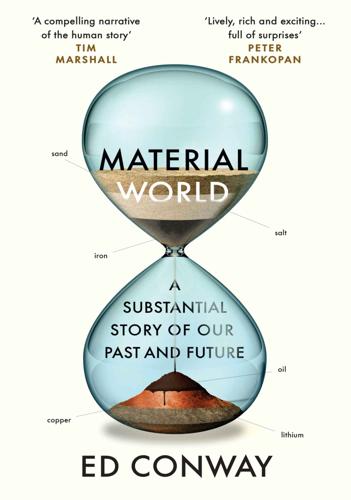
Material World: A Substantial Story of Our Past and Future
by
Ed Conway
Published 15 Jun 2023
What about all the other firms providing critical machinery for the fabs, which read like a list of mysterious names and acronyms: Veeco, Tokyo Electron, Lam Research, ASM Pacific, Applied Materials and Edwards …? Remove one or two of these companies and, well: no more computers or smartphones. This is worth pondering, for the world’s two leading superpowers both talk with increasing volume about attempting to ‘re-shore’ that supply chain. Joe Biden wants to bring semiconductor manufacture back to the US, introducing legislation in 2022 to encourage more investment in the business. Xi Jinping has a ‘Made in China 2025’ policy, which promises to increase China’s dominance and self-sufficiency in the manufacture of everything from complex machinery to semiconductors.
…
There is only a handful of companies capable of making perfect silicon wafers, and none is headquartered in either the US or China. And there is only one site in the world capable of making the quartz sand for the crucibles where those wafers are crystallised. When politicians talk lazily about re-shoring, it often betrays a deep ignorance of what is happening out there in the Material World. Tempting as it is to conclude that the journey we have just been on is unique – an extreme example of economic intricacy in the twenty-first century – it is anything but. Given how ubiquitous semiconductors are, it turns out that most of the gadgets and tools in your life, not to mention the solar panels bedecking many of our buildings and fields, have been on a similar ride before ending up in your hands.
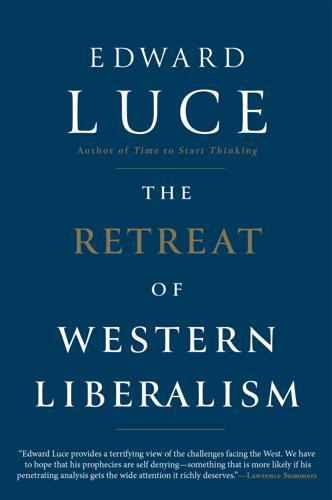
The Retreat of Western Liberalism
by
Edward Luce
Published 20 Apr 2017
v=Gpxr9ZUp7N0>. 19 Robert MacMillan, ‘The warhead at the top of the pack: The Reuters/Donald Trump interview’, Reuters, 24 February 2017, <http://www.reuters.com/article/us-select-24feb-idUSKBN 1631U0>. 20 This anecdote gave Kaplan the title for his book. 21 Shawn Donnan, ‘US trade chief seeks to reshore supply chain’, Financial Times, 31 January 2017, <https://www.ft.com/content/8dc63502-e7c7-11e6-893c-082c54a7f539>. 22 Cited in Branko Milanovic, Global Inequality: A New Approach for the Age of Globalization (Belknap Press, Cambridge MA, 2016). 23 Andrew E. Kramer, ‘The phrase Putin never uses about terrorism (and Trump does)’, New York Times, 1 February 2017, <https://www.nytimes.com/2017/02/01/world/europe/vladimir-putin-donald-trump-terrorism.html>.
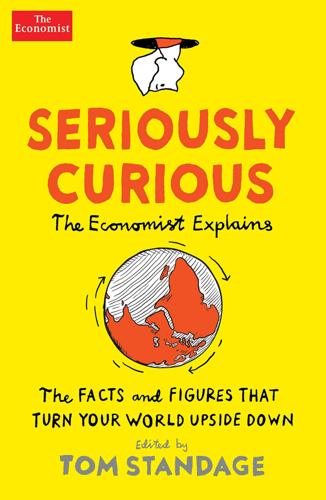
Seriously Curious: The Facts and Figures That Turn Our World Upside Down
by
Tom Standage
Published 27 Nov 2018
One big trend is the growth of “collaborative robots”, smaller and more adaptable machines designed to work alongside humans and increase their productivity. Barclays, a bank, thinks that between 2016 and 2020, sales of these machines will increase more than tenfold. Adopting robots has made it economical for some manufacturers in high-wage countries to “re-shore” production from poorer countries. In 2017 Adidas, a sportswear firm, began producing running shoes in a German factory staffed by robots and 160 new workers. The life robotic Global industrial robots Source: International Federation of Robotics FANUC is not taking its dominance for granted.
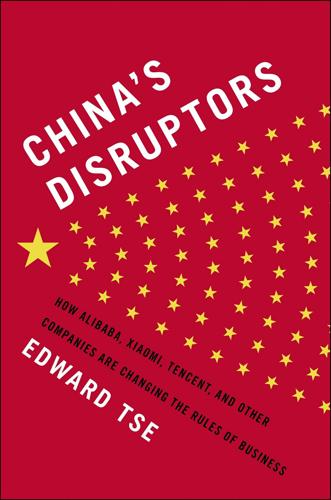
China's Disruptors: How Alibaba, Xiaomi, Tencent, and Other Companies Are Changing the Rules of Business
by
Edward Tse
Published 13 Jul 2015
Headquartered in Beijing, Sinovac Biotech is currently awaiting approval for a vaccine against the EV71 virus that causes hand, foot, and mouth disease in children and is conducting clinical trials for a vaccine that could protect people from one of the most common bacterial causes of pneumonia and meningitis. In manufacturing, China is starting to benefit from advances in digital technology. The last few years have seen much speculation on the possibility of robots and 3D printing leading to a “reshoring” of manufacturing back to developed countries, including the United States. The likelihood, however, is rather the opposite: as Chinese companies refine their ability to introduce new practices and technologies to enhance their manufacturing prowess, they will find themselves in a strong position to claim a greater share of higher-end processes.
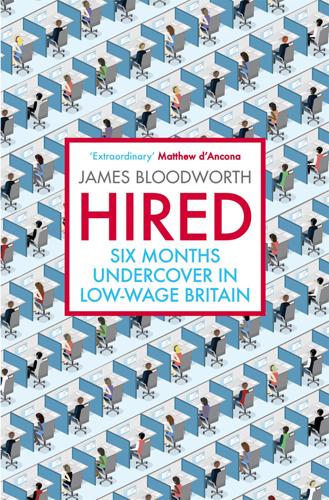
Hired: Six Months Undercover in Low-Wage Britain
by
James Bloodworth
Published 1 Mar 2018
At Amazon it was largely the task of this invisible army of downtrodden migrant labour, hidden in a rural warehouse away from any centre of civilisation, to process the internet shopping of Britain’s burgeoning middle class – a middle class that would, unlike the Eastern Europeans further down the ladder, get a vote on who governed them and made the laws when a general election came around. In this respect Britain was re-shoring a slightly more tolerable version of the backwater sweatshop. Life at companies like Amazon increasingly resembles the separation of the Eloi and the Morlocks in H. G. Wells’s The Time Machine: ‘Above ground you must have the Haves, pursuing pleasure and comfort and beauty, and below ground the Have Nots, the Workers getting continually adapted to the conditions of their labour.’

Four Battlegrounds
by
Paul Scharre
Published 18 Jan 2023
India, Japan, and Australia launched a trilateral supply chain resilience initiative to reduce their dependence on China. As part of its economic stimulus, the Japanese government allocated $2.2 billion to incentivize companies to move production out of China. The French government began working with French pharmaceutical companies to re-shore production. And in the United States, Congress and the White House began taking steps to reduce American dependency on China for pharmaceutical ingredients. U.S. actions are also beginning to shift supply chains for semiconductors. Congress approved injecting tens of billions of dollars into the U.S. semiconductor industry, including government subsidies for building new domestic chip fabrication plants, or fabs, giving the United States more security in its semiconductor supplies.
…
Even a nonviolent shift in political and economic power across the Taiwan Strait that moved Taiwan’s semiconductor industry into the CCP’s sphere of influence would dramatically alter the global balance of technological power. The United States and allies must expand multilateral export controls, increase R&D funding, and subsidize fab construction to re-shore fabs to the United States and other allied nations. Yet as long as China has 60 percent of the global demand for semiconductors, its buying power will tend to bend supply chains around any restrictions. An important element of a comprehensive U.S. strategy for hardware competition is incentivizing companies to diversify electronics manufacturing out of China using a mix of carrots, such as tax incentives, and sticks, such as targeted tariffs.

Covid-19: The Pandemic That Never Should Have Happened and How to Stop the Next One
by
Debora MacKenzie
Published 13 Jul 2020
That means making our systems less fragile—but the right answers may not always be the most obvious. Over the past few decades, many jobs in the traditional industrial heartlands of Europe and North America have been lost to “offshoring,” the movement of industries to fast-industrializing countries elsewhere. There is now talk of rolling that back and “reshoring” in some industries, especially those that are vital in a pandemic, to shorten fragile supply chains. But that might not always be the best thing to do, warns Shannon O’Neill of the Council on Foreign Relations, a US think tank. In many cases, such a forced move will lose those industries the advantages of scale and labor costs they gained by moving, resulting in rising costs of goods for ordinary people, by some—$10,000 a year on average for US consumers, a significant portion of average incomes.

The Globotics Upheaval: Globalisation, Robotics and the Future of Work
by
Richard Baldwin
Published 10 Jan 2019
The basic reasoning is as easy as one, two, three: 1) AI software makes it feasible to charge a zero price to consumers for services that a few years ago would have been expensive; 2) people start using these services like crazy; and 3) the companies providing the new services hire people to look after the robots and do more human chores like management, accounting, human resource management, and the like. A third way AI automation is creating jobs in rich nations is by reshoring back-office jobs that had been offshored to countries like India. The idea of replacing high-cost workers doing routine manipulation of information that can be sent down a wire is an old one. Since the 1990s, many companies have sent these jobs overseas. This created a whole industry called business process outsourcing (BPO) that is today dominated by companies like Infosys.
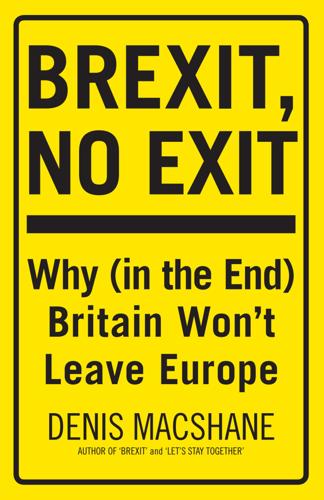
Brexit, No Exit: Why in the End Britain Won't Leave Europe
by
Denis MacShane
Published 14 Jul 2017
The consortium of EU nations that makes the Airbus have spread out the manufacturing of its body, wings, avionics, internal furnishing and engines so that each participating EU nation gets a share of the profit that comes from this collaborative EU enterprise. But outside the EU there will be pressure from other nations to have the current wing production factories reshored in the EU and no longer in Britain. There will be a row and legal fights, but outside Europe Britain will be in a markedly weaker position. The arbitration court for any trade dispute within the EU is the European Court of Justice but Mrs May says she wants nothing to do with it. So where does a British exporter turn if unfairly treated by a European competitor – the comment pages of the Daily Telegraph?

Paper Girl: A Memoir of Home and Family in a Fractured America
by
Beth Macy
Published 6 Oct 2025
Seeberg wasn’t sure the if-you-build-it-they-will-come strategy still worked in an era of sky-high childhood trauma and a severe shortage of tradespeople. Dubbed Silicon Heartland, the plant promised to be the “largest silicon manufacturing location on the planet,” part of Biden’s efforts to re-shore manufacturing and make America less dependent on overseas supply chains. But builders were having trouble finding the seven thousand workers needed just to construct the plant, let alone staff it.[22] Competition for construction workers was also slowing the pace of home building for the growing workforce needed at Intel.

Stakeholder Capitalism: A Global Economy That Works for Progress, People and Planet
by
Klaus Schwab
Published 7 Jan 2021
Indeed, they didn't just pause and reflect on their own lives and careers but on the merits and shortcomings of our global economic system at large, and the potential of other ways of producing and consuming necessary goods and services. Should Europeans and Americans still procure goods from China or other overseas destinations, given their environmental footprint and the fragility of supply chains? Or can they near-shore or even re-shore production, thanks to advances in automation and 3D printing? Should countries with different labor, competition, and industrial policies be trading at all, given the tilted playing field that results from such policies? And, for that matter, has globalization stopped being a force for good? Or was it never one, after all?

Stakeholder Capitalism: A Global Economy That Works for Progress, People and Planet
by
Klaus Schwab
and
Peter Vanham
Published 27 Jan 2021
Indeed, they didn't just pause and reflect on their own lives and careers but on the merits and shortcomings of our global economic system at large, and the potential of other ways of producing and consuming necessary goods and services. Should Europeans and Americans still procure goods from China or other overseas destinations, given their environmental footprint and the fragility of supply chains? Or can they near-shore or even re-shore production, thanks to advances in automation and 3D printing? Should countries with different labor, competition, and industrial policies be trading at all, given the tilted playing field that results from such policies? And, for that matter, has globalization stopped being a force for good? Or was it never one, after all?

The Measure of Progress: Counting What Really Matters
by
Diane Coyle
Published 15 Apr 2025
(p6–7) That era did end, in a world war, the Great Depression, and another world war, so the precedent for deglobalising is not good. Nevertheless, there is a new concern for economic resilience, post-pandemic and post- invasion of Ukraine, and for national security as US-China tensions have increased. “Reshoring” and “friend-shoring” are current buzzwords. However, if production is restructured globally once again, it seems more likely to rewire the global production networks than simply to unpick them. The fall in transportation and communication costs has changed optimal production arrangements. Just-in-time logistics might recede to build in a buffer for resilience, but the efficiency gains of the production networks are so large that they w ill not be abandoned; inventory to sales ratios in manufacturing and retailing have declined substantially everywhere (from about 1.7 in the United States in 1990 to about 1.3 now).

Age of Discovery: Navigating the Risks and Rewards of Our New Renaissance
by
Ian Goldin
and
Chris Kutarna
Published 23 May 2016
Now this term is passé; it implies an idea of home and away that management needs to purge if it is to compete in today’s markets. Products are “made in the world”—and some, like the iPhone, are bought in the world, too. Business breaks apart the entire value chain and locates each piece for strategic reasons: offshoring some, re-shoring and near-shoring others. Cost matters, but it does not dominate the decision. In the twenty-first century, it can be just as profitable to make components for US automobiles in Tennessee as in Guangzhou—once time, overheads, risk and responsiveness are factored in. See Figure 3-1. Figure 3-1.
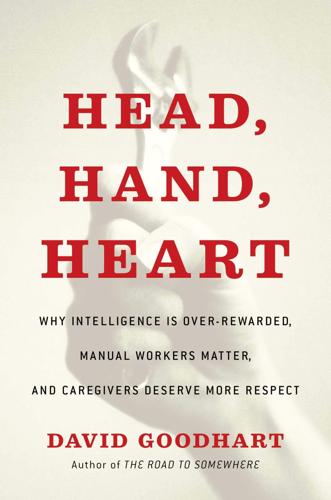
Head, Hand, Heart: Why Intelligence Is Over-Rewarded, Manual Workers Matter, and Caregivers Deserve More Respect
by
David Goodhart
Published 7 Sep 2020
The crisis has been the hour of the nation state and national social contracts at least in Europe, though in the United States it is the relative weakness of the central state that has been exposed. National democracies are likely to claim a greater say in the next phase of globalization. There will be some reshoring and shortening of those long, vulnerable supply chains. Lowest-cost globalization, which regrets the closure of the Midwest manufacturing plant but sees it as a price worth paying for cheaper goods in Walmart, will no longer win the argument so easily. Most of us are producers as well as consumers, and we might be prepared to pay a few dollars more for a smartphone produced closer to home.
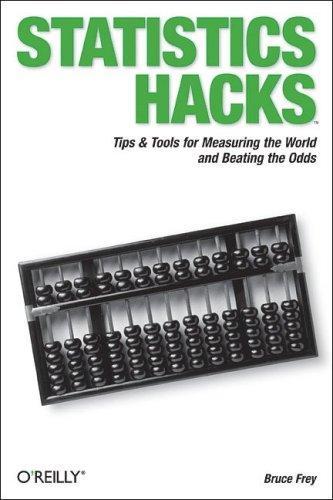
Statistics hacks
by
Bruce Frey
Published 9 May 2006
Music MP3 files that do not follow Benford's law The fact that the file sizes of about 600 MP3 music files do not approximate Benford's law is not surprising, since the sizes of MP3 music files exhibit much less variability than a more random selection of any 600 computer files. See Also Becker, T. J. (2000). "Sorry, wrong number: Century-old math rule ferrets out modern-day digital deception," Georgia Tech Research Horizons, http://gtresearchnews.gatech.edu/reshor/rh-f00/math.html. Browne, M. (1998). "Following Benford's law, or looking out for no. 1." The New York Times, August 4, 1998. Fawcett, W. (n.d.). "Significant figure generator." http://williamfawcett.com/flash/SigFigDistbGen.htm. Benford, F. (1938). "The law of anomalous numbers." Proceedings of the American Philosophical Society, 78, 551-572.
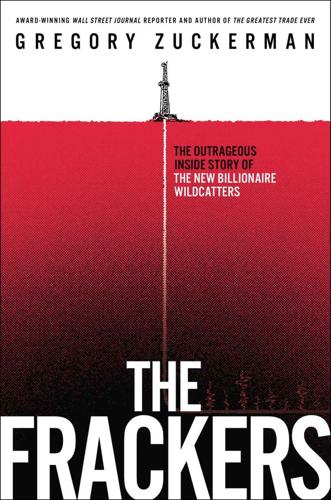
The Frackers: The Outrageous Inside Story of the New Billionaire Wildcatters
by
Gregory Zuckerman
Published 5 Nov 2013
North Dakota enjoys an unemployment rate of about 3 percent, a Walmart in the heart of the state’s oil region pays employees twenty-two dollars an hour, and some local McDonald’s outlets have resorted to offering bonuses of $300 and thirty-two-inch flat-screen televisions to lure new employees.1 Electricity and natural gas prices are so much cheaper in the United States than in most other countries that they could help usher in a new era of American economic dominance. A “reshoring” trend already is under way, as steel, chemical, fertilizer, plastics, tire, and other companies move production back to the country or expand existing factories, while foreign firms build new plants in the United States. The shift is helping to bring back some jobs once believed to have been lost forever to China and other low-cost economies.
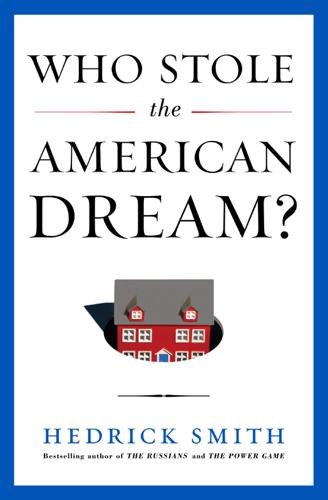
Who Stole the American Dream?
by
Hedrick Smith
Published 10 Sep 2012
With labor unrest and wage inflation in China and stagnant or falling wages in America, a few companies such as General Electric, Otis Elevator, and Master Lock of Milwaukee have begun to bring jobs back from China to the United States—and smart government policies could foster that trend. In all, some 25,000 manufacturing jobs have returned to the United States in the past few years, according to Harry Moser, president of the nonprofit Reshoring Initiative. Personal Involvement But for the long-term effort to level the economic playing field and to reclaim the American Dream, what is needed is a modern political crusade by average Americans on the model of the civil rights and environmental movements of the 1960s and ’70s. Inevitably, people ask for leadership: Where is the great new Lincoln to heal the fissures of our divided nation and set our nation on an upward path?
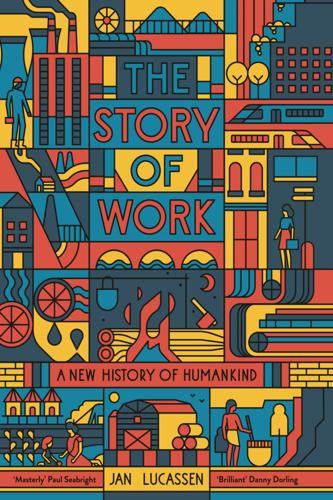
The Story of Work: A New History of Humankind
by
Jan Lucassen
Published 26 Jul 2021
This is a new detail in a truly globalized world for which there are no historical parallels. Moreover, we are also seeing the re-emergence of counter-movements, as ‘offshoring’ (moving production to low-wage countries) is once more provoking a turnabout due to robotization in the North Atlantic and due to rising labour costs, especially in China: so-called reshoring. China, in turn, is not sitting still and is now seriously pursuing factory automation. This is not surprising for a country that stands on the cusp of ageing, something that has already begun in Japan and South Korea.3 Fourthly, and certainly not unimportant, for most states, globalization means an erosion of democratic decision making at the national level.